Home Blog Education How to Create and Deliver Training Presentations That Make an Impact

How to Create and Deliver Training Presentations That Make an Impact
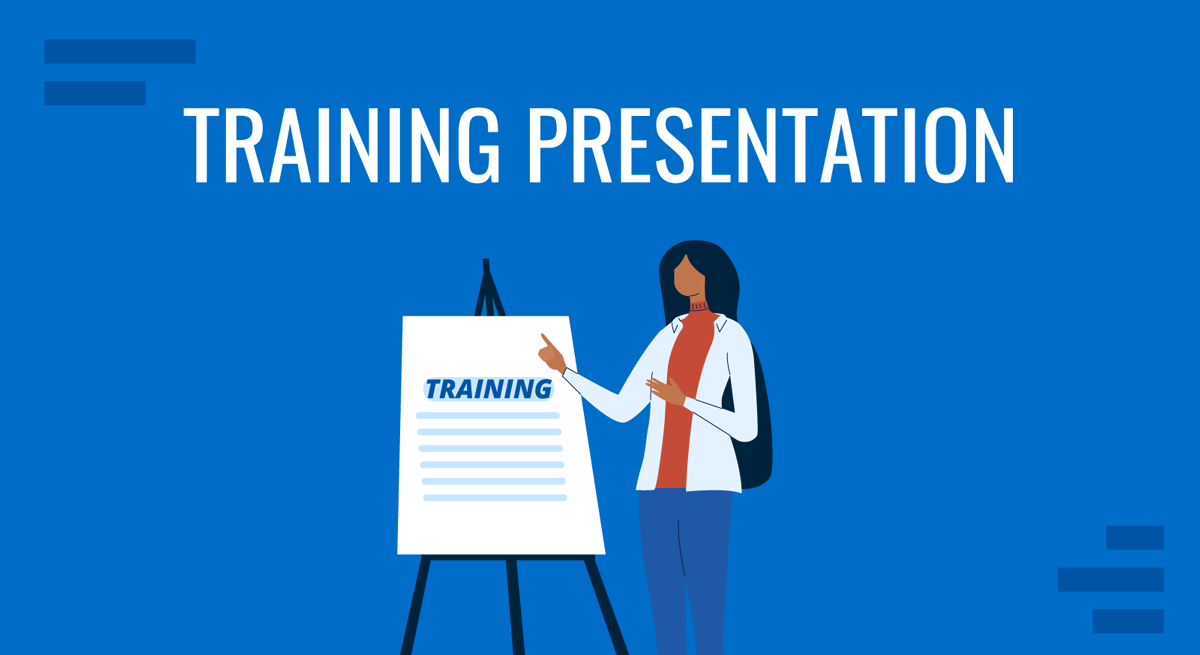
Blended learning and hybrid workplaces have improved how employees train and optimize their work output. Corporate training is now a rich combination of in-person group sessions, live online lessons, and SCORM courses that employees can follow at their own pace.
Are your training presentations up to the challenge?
Learning & Development strategists, HR, and performance management managers take note. In this guide, we’ll show you how to create a training deck from start to finish . Plus, some template examples and optimization tips for creating training presentations that make learning more effective.
What is a Training Presentation?
A training presentation is a set of slides created to teach a skill or increase knowledge of a topic. They’re used in training and development strategies in companies worldwide. Across the slides in a training presentation, employees learn essential information and skills to do their jobs better and grow in their careers.
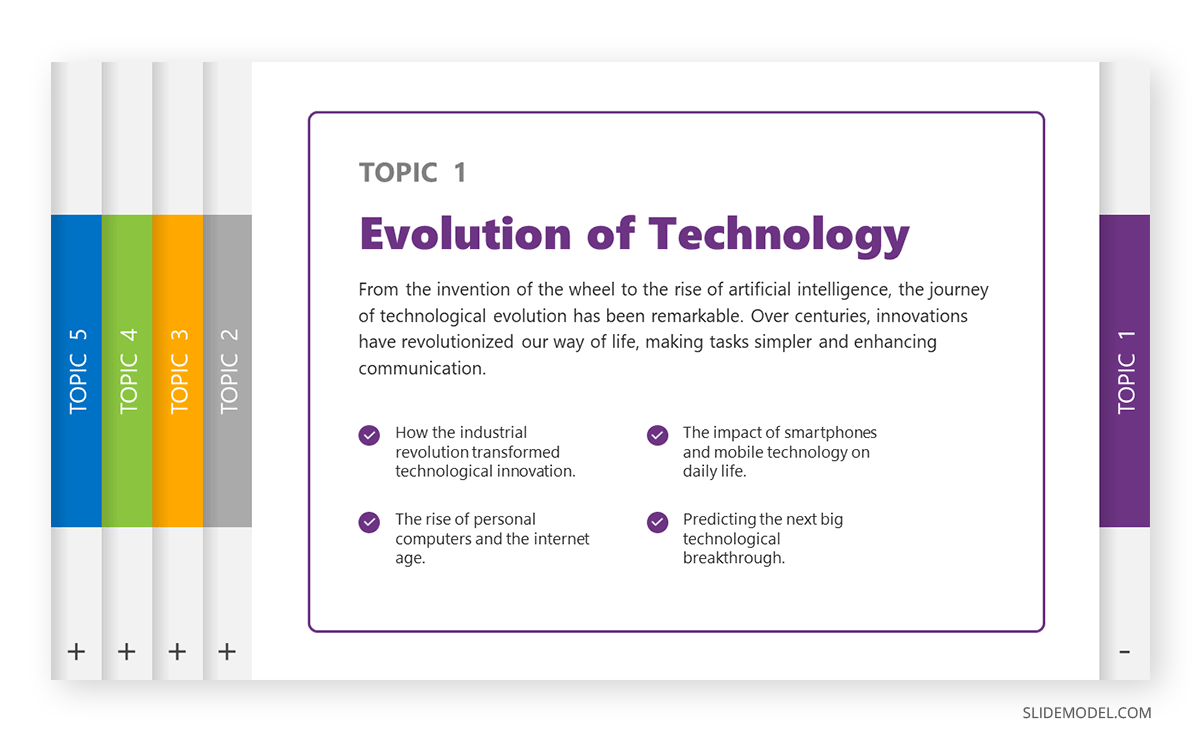
Types of Training Presentations
Training presentations form part of all L&D initiatives in an HR department. They have one of two purposes; to train employees for the job at the present moment and to train them for growth and the future.
Training for the job instructs employees on how to carry out their assigned tasks and responsibilities . The skills they learn follow guidelines from the company’s brand, processes, and structure.
Examples include:
- On-the-job training
- Practice simulations
- Orientation
- Skillbuilding

To train for growth , employees are given resources to increase their capabilities, like learning new technology or methodology. They learn skills that will help their career future, preparing them for a promotion within the company or for changing teams laterally in a new role.
Growth training includes topics like:
- Soft skills
- New technology
- New processes or methodologies
- Job rotation
- Personal development
- Career expansion

Why Are Training Presentations Important?
High-quality training and development initiatives in a corporate setting offer many benefits. Three of the most relevant are employee buy-in and retention, company culture, and professional development.
Employee Buy-in and Retention
When training presentations are achieved at a high standard, team members in People Management, Human Resources, Learning & Development, and DEI feel confident and proud of their work in training fellow employees.
They accompany employees along training paths, so it’s better if they’re invested in what they’re sharing. For a solid brand identity —and clear company culture—thorough training helps with buy-in straight out of the gate with an onboarding strategy. Then continues with regular training initiatives that lead to retention, satisfaction and loyalty.
Company Culture
The role of company culture in an organization has a lot of weight towards brand equity. But a strong culture doesn’t happen overnight; it’s instilled in the employees’ minds through team-building activities, motivational seminars, and equitable training in all aspects of work.
Company culture flows through the ongoing interaction between trainers and trainees. Group sessions and training days help build relationships between teams and employees. Feeling invested is a trait developed through the right type of training.
Professional Development
High-quality training for professional development is essential in every organization. On-the-job training for daily tasks is only part of the puzzle; employees also need to train for growth.
In-company training for professional development includes training for higher—or lateral—positions. Offering training for the future not only heightens professional development for individual employees but also carves a strong culture.
How to Create a Training Presentation
Let’s create a training deck together. We’ll use a case study to guide us along.
You and your L&D team at an IT Company are preparing a company-wide training session about the SCRUM framework before implementing it in more aspects of the business. The Training presentation is titled “Understanding the SCRUM Framework. Agilizing our productivity, together.” Sessions will be blended/hybrid to accommodate both in-office and remote employees. There will be a camera recording the instructor, and remote employees will see the presentation and the video of the instructor talking side by side on their screen.

1. Plan and prepare
Planning and strategizing are as important in training as in other business areas. Your training presentation already has a purpose, company-wide training about the SCRUM framework. But if you aren’t sure what employees need to learn to increase productivity and employee satisfaction, you’ll have to do some research.
Figuring out your people’s learning and development needs takes some work. Are you using a performance management system? What does the reporting reveal? Where are employees failing to set goals? How can training presentations help?
Analyze the reports, and you’ll see where they’re lacking. Plan upskilling strategies around those topics. With a clear objective, start preparing the training, presentation, and conversation points for group sessions.
Put together a lesson plan covering the main characteristics of your presentation. Use it as a foundational reference during the production of the training presentation slides .
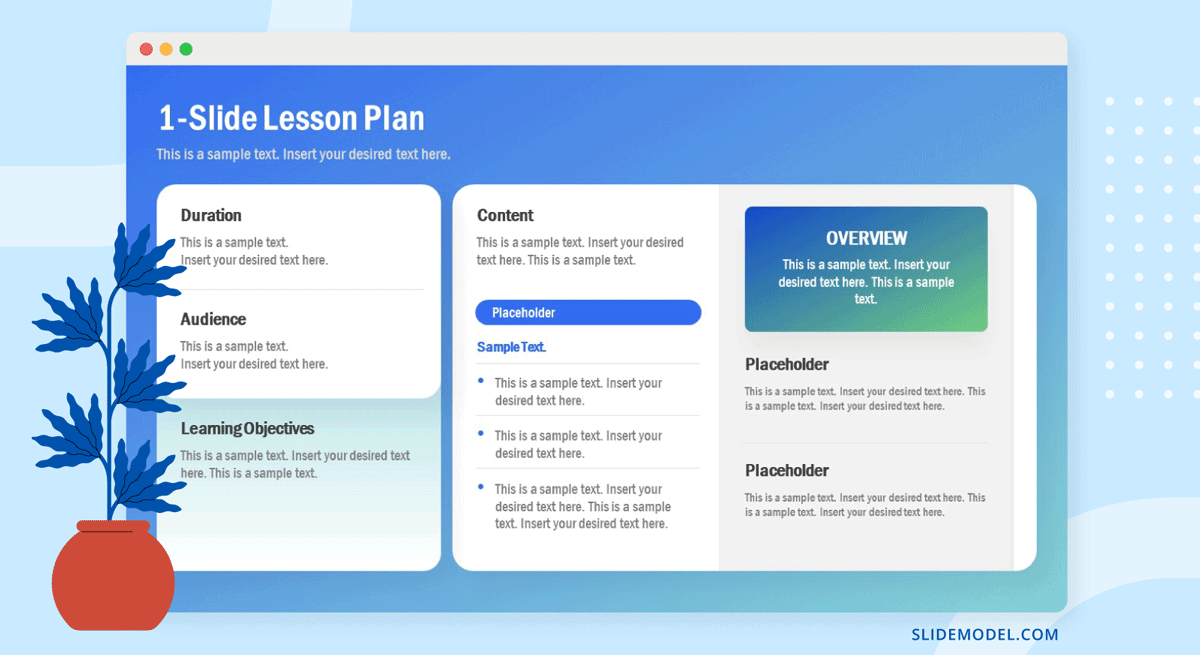
2. Create a basic structure
Creating a structure for a training presentation is a critical step before designing slides or even writing the content. Training presentations with a set structure are more impactful than ones without.
Following a structure makes the transference of knowledge much simpler. Write an outline that follows that structure. Do it on a document or use a visual tool like a storyboard to overview the full presentation deck .
The main structure for any training presentation has three parts; beginning, middle, and end. Yes, it’s that simple.
- Start with an agenda slide that covers the contents of the training presentation and builds a framework of what to expect out of this training program. Follow by listing the syllabus for the course and required learning material that will be accessible, and where students should download/access such content.
- Inform learners that at the end of the presentation, they will have all the basic and practical knowledge to understand and begin working with a SCRUM framework.
- Explain (if necessary) what they need as a prerequisite to get the most out of the training.
- Any instructions they need to follow during the session, such as how to approach practical exercises or instructions for deliverables expected.
- Share all supplemental material through links they can download or access from. This should also include any book chapter mentioned, video resources, photos, etc. Cloud-based storage accessible from the Company’s intranet tends to suit all needs.
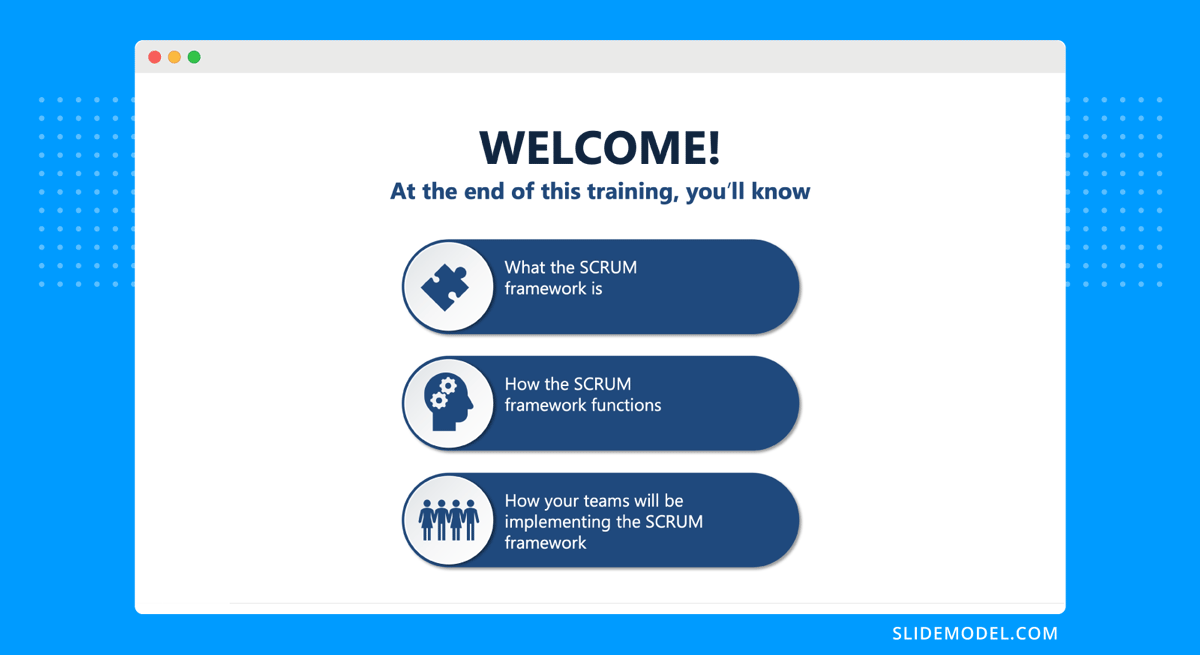
- Throughout the meatiest slides of the presentation, teach them about the SCRUM framework. Then share how their team will use it to agile production and work in general.
- Use visual training techniques to explain themes and topics clearly.
- Create interactive moments for learners to imprint information.
- Incorporate a variety of teaching formats to cover all learning styles; video, text, images, infographics, interactive activities, etc.
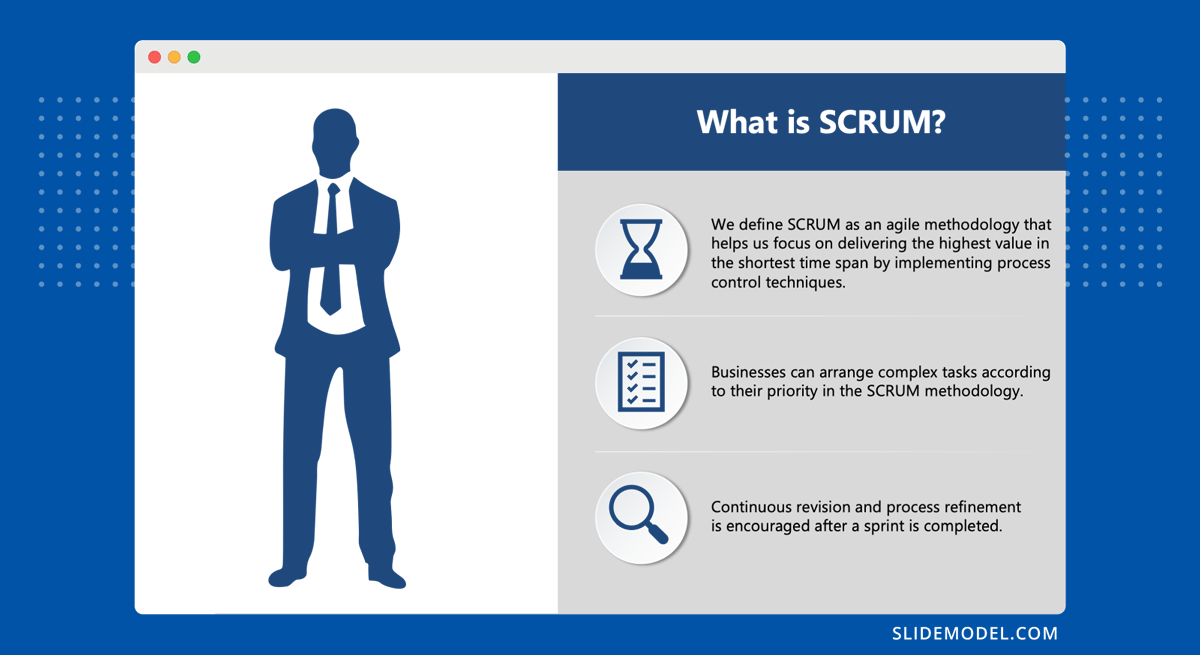
- Craft a few slides summarizing what they learned using a highlights list.
- Have learners take a quiz to test their knowledge and offer results that include the right answers to the questions they got wrong.
- Share references to supplemental material where learners can get more information on the topic.
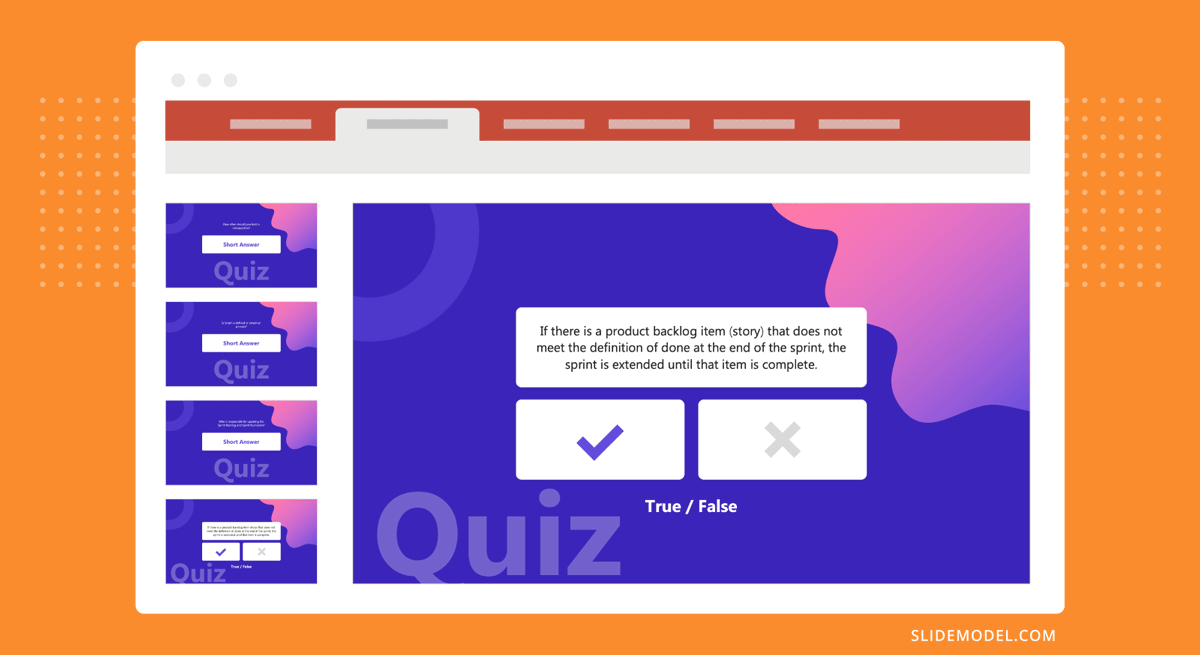
The Middle Structure
In the middle is where most of the magic happens. A training presentation is much like a lecture in its purpose. Therefore, using teaching and lecture techniques in your presentations can only be a good idea.
Here are six lecture structures that you can apply to the middle of your presentation. For the SCRUM Framework training, we’ll use the first example .
- Start with what students can be expected to know to what students don’t know.
- Proceed from reality to abstract ideas, theories, and principles.
- Begin with generalizations and continue with particular examples and applications.
- Open with simple ideas and round them up with complex ones
- Start sharing common misconceptions and then explain the truth.
- Go from a whole view to a detailed view.
3. Gather resources
Organize all the content you’ll need for the presentation in a folder on the cloud or your team’s content library. Browse the SlideModel template collection, where you’ll find plenty of slides, full decks, and cut & copy elements to include in your training deck. For the slides to describe the SCRUM framework, we used this 3D PPT template of how the parts of the framework are interconnected.

Resource checklist for any training presentation:
- All visuals, videos, and PowerPoint slides add value to the training.
- Case studies and examples support your points.
- Your company has the appropriate licenses to use the resources that are included in the final design.
- All references, citations and attributions are gathered for inclusion in the training documentation.
- Your templates are from Slidemodel.
4. Design the slides
Now, it’s time to put it all together and design the slides. Get all your resources ready, a list of all the templates you’ll use, and start a new project on PowerPoint.
Have your outline and/or storyboard open and start designing slides. Start with the cover and then follow the structure you decided on. Work your way through to the end and add a quiz. Here are some instructional presentation design best practices to help you along.
- Create visual unity and balance by choosing a color theme and font pairing that supports the brand message and purpose of the training.
- Mind the flow between slides from beginning to end. Use subtle transitions that don’t distract from the learning.
- Use a table of contents, section dividers, and interactive slide menus for easier navigation.
- Ensure each slide has a focal point and a visual hierarchy between all other elements.
All training material emulates the company brand, its values and vision. As marketing material follows visual and messaging brand guidelines, so should internal development content.
Rather than mix & match slide templates, you can try a really fast method to create an entire training presentation by stating its topic, checking the suggested content, and selecting the desired slide design. This is possible thanks to the SlideModel’s AI Presentation Maker .
5 Training Presentation Slide Examples
Are you looking for inspiration to create a training presentation? SlideModel has numerous designs suitable for explaining, visually dissecting, and analyzing the material. Likewise, you’ll find templates that help L&D strategists communicate with instructors during the planning phase and beyond.
Here are five templates that can help with your training presentation design.
Employee Onboarding
First, this multi-slide ppt template for training is an employee onboarding presentation . Use it to cover all characteristics of a corporate onboarding process. Slides include;
- Pre-boarding
- Training Activities
- Onboarding Roadmap
- Title & closing slides

Managerial Grid
The Blake & Mouton managerial grid is a great way to explain and analyze the different types of management based on production concerns and people concerns. Production concerns are characterized by tasks, and people are concerned with relationships.
Matrix Grids can be used for other purposes as well. Like stakeholder engagement , talent analysis , and content marketing.
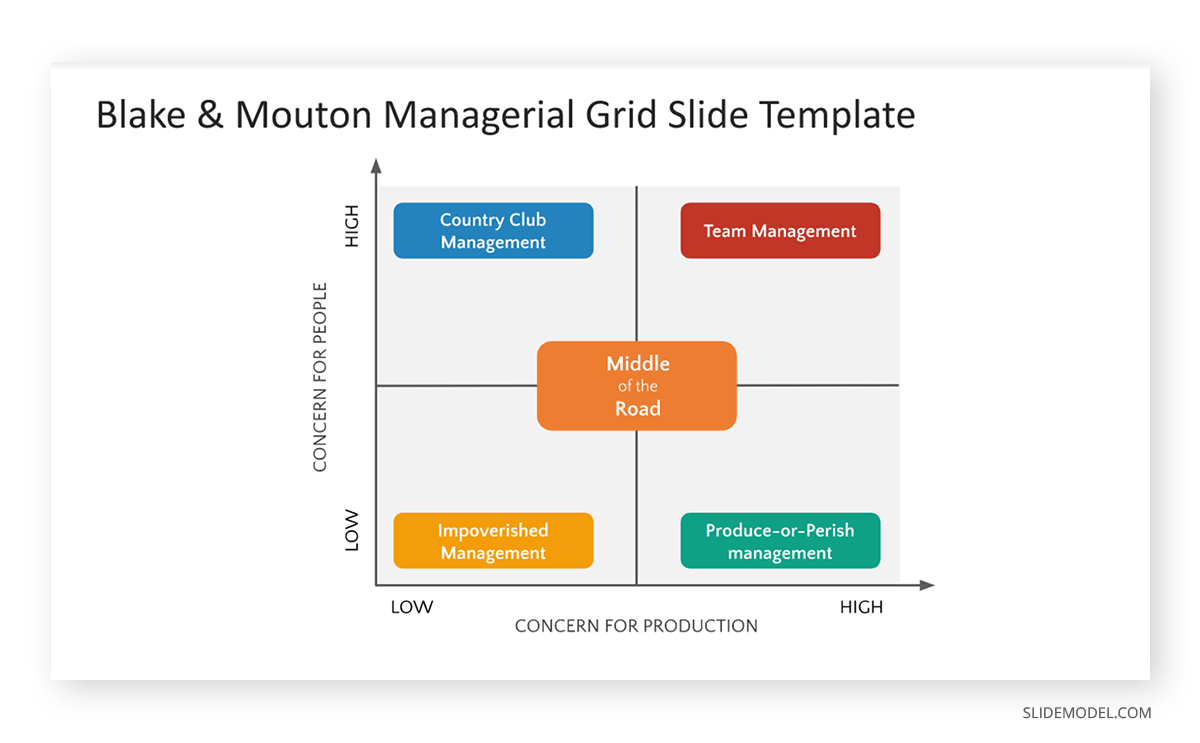
Multichapter Presentation
Does your training content span long chunks of information? Separate it into digestible sections and create a multichapter training presentation. If it still feels very long, separate each chapter into a lesson of a comprehensive digital course. This multichapter presentation template will help you either way. Plus, it will add considerable visual value to the deck as a whole.
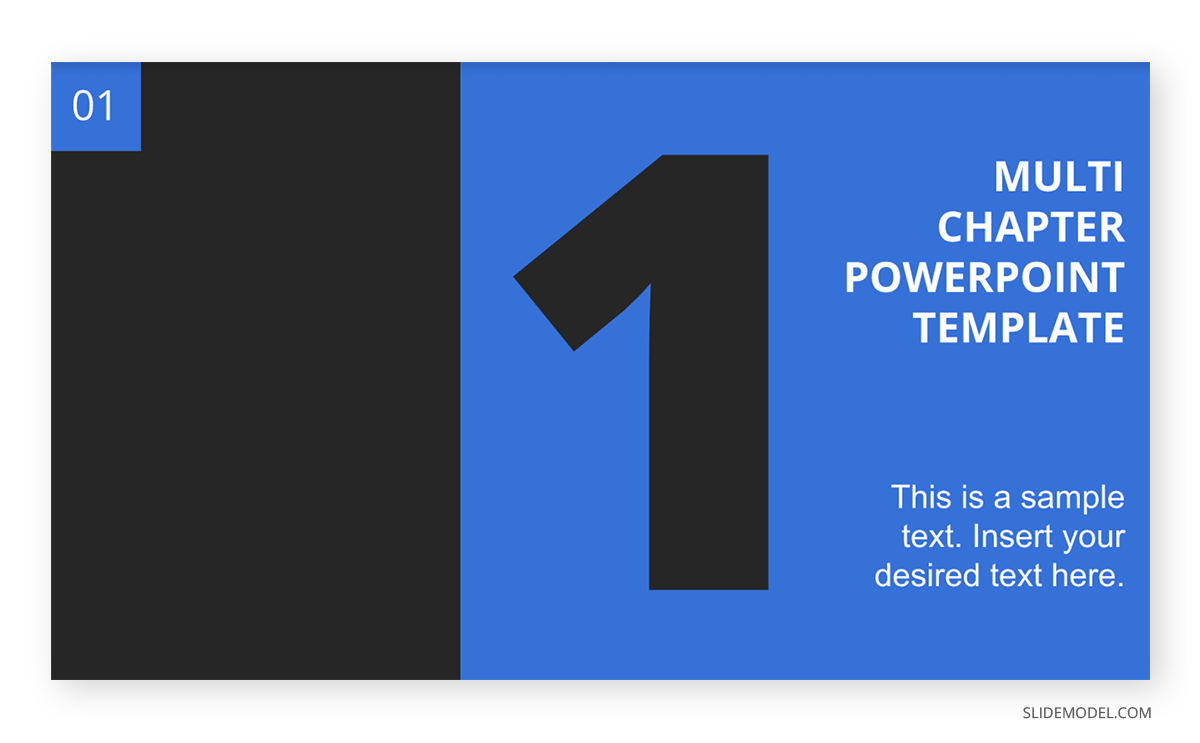
SWOT Analysis
Teaching the SWOT Analysis process is best achieved with a “start big and continue into the details” presentation structure. This 5-slide template starts with the main idea and then delves deeper into each section. A visual structure like this also works for any concept that needs explanatory simplification. Simply separate the main concept into four parts and create a further slide for each.
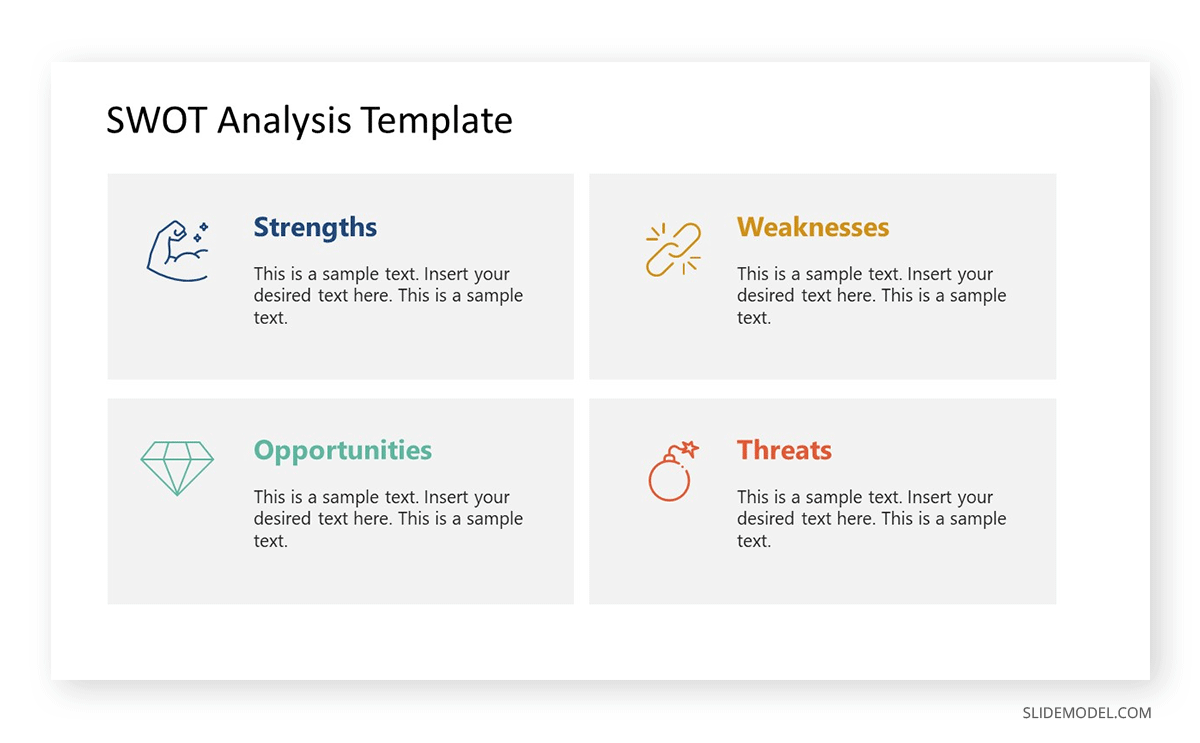
5Cs of Customer Service
Nothing exudes versatility as much as infographics. This template has one function, to describe and analyze the 5Cs of customer service . Nevertheless, you get six visually different infographic compositions for the same topic in one template. How else can your content be separated into five sections with the same first letter? This—all words with the same first letter—is a mnemonic technique that will help your learners absorb and retain information.

How to Deliver Your Training Presentation
How will you deliver the training presentation to your learners? Depending on the company culture and working model, your training presentation will appear in any of the following scenarios.
1. As visual support to your In-person group training session.
The in-person group training session is the most common—until the pandemic changed many things. Your training presentation is the visual support during the event.
Here are some tips for delivering a presentation during a group training session.
- Practice your ability to talk to a group. Notice your voice inflections or lack thereof. Practice the lesson with the training slides to support your spoken or activity-based teaching material.
- Remember that presenting a business presentation and teaching with a training presentation aren’t the same. If you’re new to in-person group training, research to learn and practice instruction skills.
- While training, maintain constant interaction with the learners. Ask them questions, and let them ask you questions. Invite anyone interested to join the online whiteboard for notetaking and mind-mapping the lesson.
2. As Part of a Live Online Session for Hybrid Teams.
Online, blended learning is quickly becoming popular with L&D teams. But how does it work? And why is it so special?
When you have hybrid teams with some employees in-office, others at home, and even more in other parts of the world, you need training solutions that work for everyone.
For the SCRUM training, we’d do the following:
- Prepare the training presentation slide deck.
- Organize a space for the in-person group and plan the event.
- Set up a camera to record the lesson or training session.
- Invite all employees to the session and offer them options of attendance; in-person, online, and live, watching the event recording.
- Get set up to stream the session live. You can use a webinar tool like Streamyard or the one inside your LMS platform. Someone might need to help so you can concentrate on the training rather than the technical tasks.
- Stream the lesson live and record it. On Chromecast , choose to use the split screen. One side shows the video of you teaching, and the other is the training presentation you prepared.
- Send the recording to the employees that didn’t attend in person or live online.
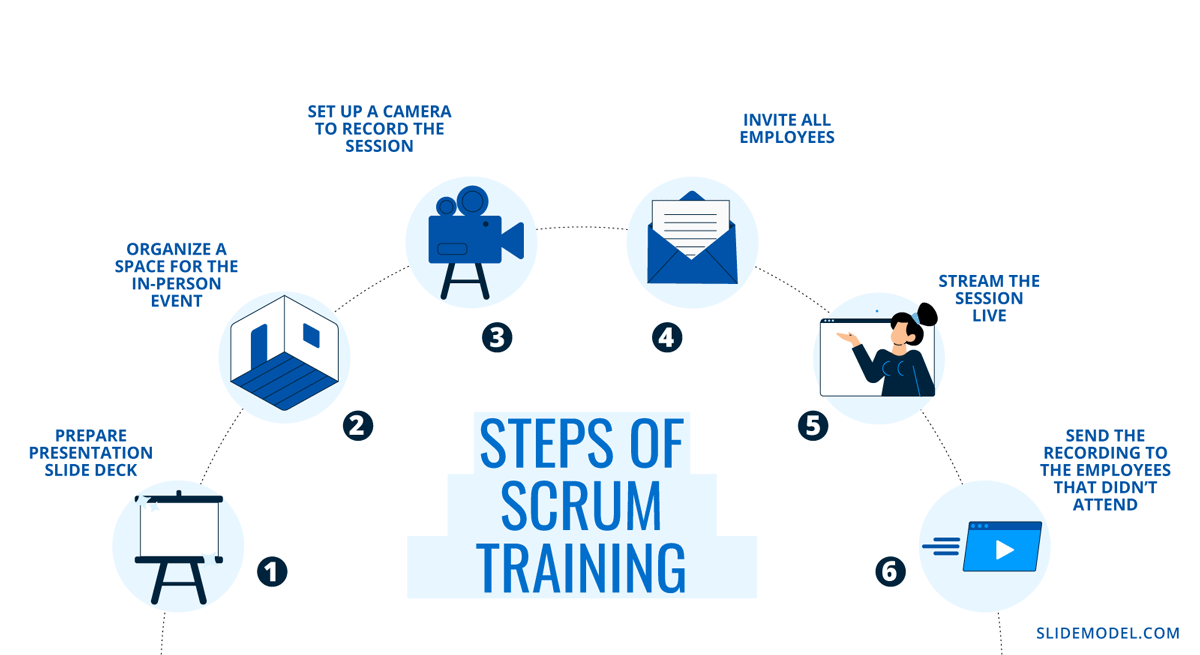
3. As a lesson in a digital course
Your training presentation can be its own course or part of a bigger one. In a comprehensive multi-lesson course, each section has its training presentation or a combination of presentations and other material. Use e-learning tools like SCORM and xAPI to create courses learners can do at their own pace, which you can keep track of.
Create your SCORM and xAPI courses with PowerPoint, SlideModel, and the iSpring PPT plugin. Once finished, upload it all to your LMS platform and enroll employees to learn.
What’s the difference between SCORM and xAPI? The visual below has all the answers.
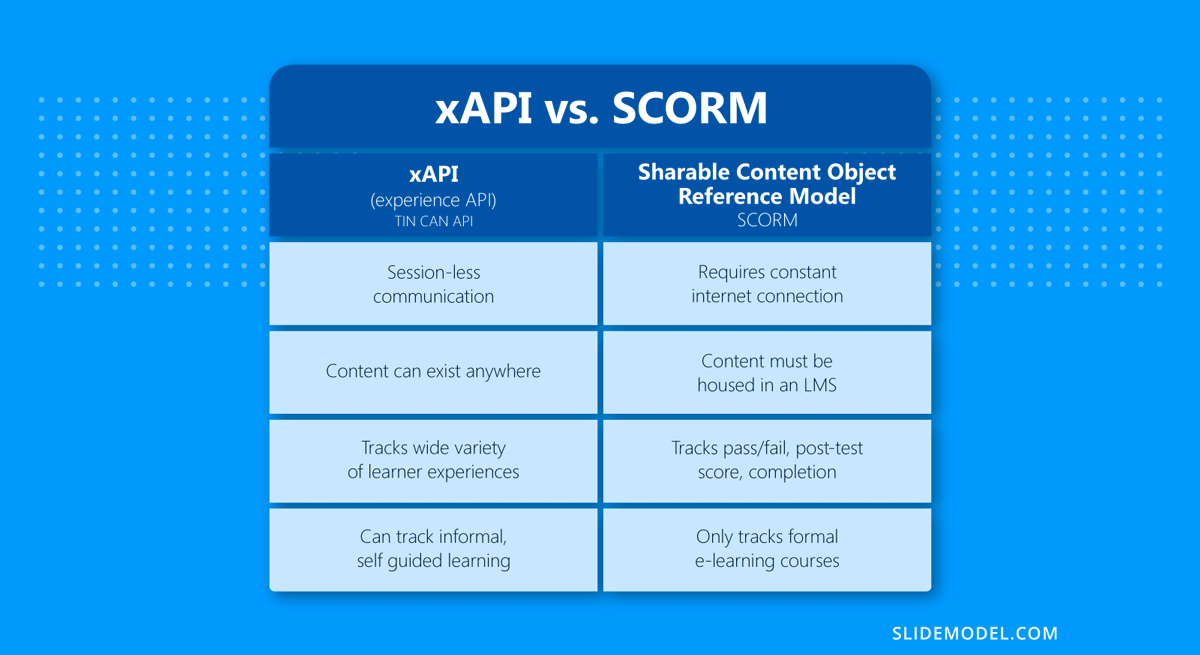
Read our guide on how to create an online course for detailed instructions and tips to make your course stand out.
3. As a PDF document
Delivering a training presentation as a PDF document shouldn’t be your first choice, but consider it for those employees that prefer learning that way. The same training presentation you create for in-person training, online learning or hybrid sessions can be downloaded as a PDF and shared via email or through the learning portal.
Takeaways for how to create successful PowerPoint Training Presentations
Optimize your training presentations to be as efficient as possible using instructional design techniques from the pros. Start with your trusty authoring combination of PowerPoint and SlideModel, and add an iSpring design plugin to complete the toolkit. Follow the steps in the sections above and then some.
Implement Interactivity
Add interactivity to your training presentations to make them more engaging while touching on more learning styles. Interactivity can be as simple as a navigation menu between slides, dialogue simulations, and quick in-slide quizzes. Use xAPI and an LMS to create interactive training presentations for any topic.
After discussing the importance of interactivity, take a look at our 5-topic training presentation template showcased in the following video. With a tabbed menu, this training PPT template is ideal for presenting the agenda of your training session and delivering it in a streamlined manner. Each tab can represent a unique topic or module, making it easier for your audience to follow along and understand the progression of your training. The slide layout not only enhances visual appeal, making it more engaging than traditional slides, but also promotes organized content delivery.
Animated presentation templates, such as the one shown, are an effective way to captivate your audience and make the learning experience more memorable. This kind of animations add an element of surprise and engagement that static slides might lack. When paired with interactive elements mentioned earlier, such training templates can transform your training presentations into immersive learning experiences.
Add In-Slide Video
Hybrid learning and online learning have a wide berth of possibilities. One is in-slide video recordings of you—the training presenter—talking to the audience on the other side of the screen.
This is especially practical for digital training presentations that never had an in-person session and instead are all done online. Use tools like Loom and Camtasia to record yourself speaking as you flip through the training slides, then download the Loom video . Then share the final video output on your company’s learning platform.
Offer Supplemental Material
Regardless of how you deliver your training deck, it’s always a good idea to offer supplemental material for the learner. Let’s look at some ideas:
- If you deliver the training presentation as a video with much narration, offer a PDF transcript for download.
- On an LMS platform, add printable PDF worksheets and further reading material.
- Before or during an in-person session, give handouts and worksheets.
- In a hybrid webinar, share links to online games that help reinforce the topic.
- In any scenario, offer further resources for self-paced learning.
Incorporate Gamification
One of the best teaching techniques for turning training presentations from meh to memorable is gamification. Using games and game-like visual qualities helps learners capture and retain information better. Gamification techniques like badges, challenges, and competition elevate the learner’s feeling of happiness and contentment. They enjoy the process more and therefore learn more effectively.
Cover Multiple Platforms
Reach all employees where they are by creating and delivering versatile training presentations that are viewable on any device, from wall projectors to mobile phones. Create interconnectivity between them with downloads, digital whiteboards for notetaking, online chatrooms, handouts, etc.
Don’t forget also to follow accessibility standards. For example, closed caption subtitles on videos and e-reader-compatible text.
Share Questionnaires And Surveys At The End
Do you agree with the business notion that nothing in business is worth it unless you can track it? If so, then your training presentations must have a callback. Shortly after the learner has attended, watched, or listened to your training presentation, send them a short survey to gauge their satisfaction. Combine this with testing and quizzing results, and over a short time; you’ll have a good grasp on the effectiveness of your training.
Give a Certificate of Completion
Offer your learners a certificate of completion. As its name indicates, a certificate is essential for certifying that a person has taken your course. Create a visual certificate that you can send as a pdf in an email. Include all the necessary information for the learner to mention the completed course on their LinkedIn profile.
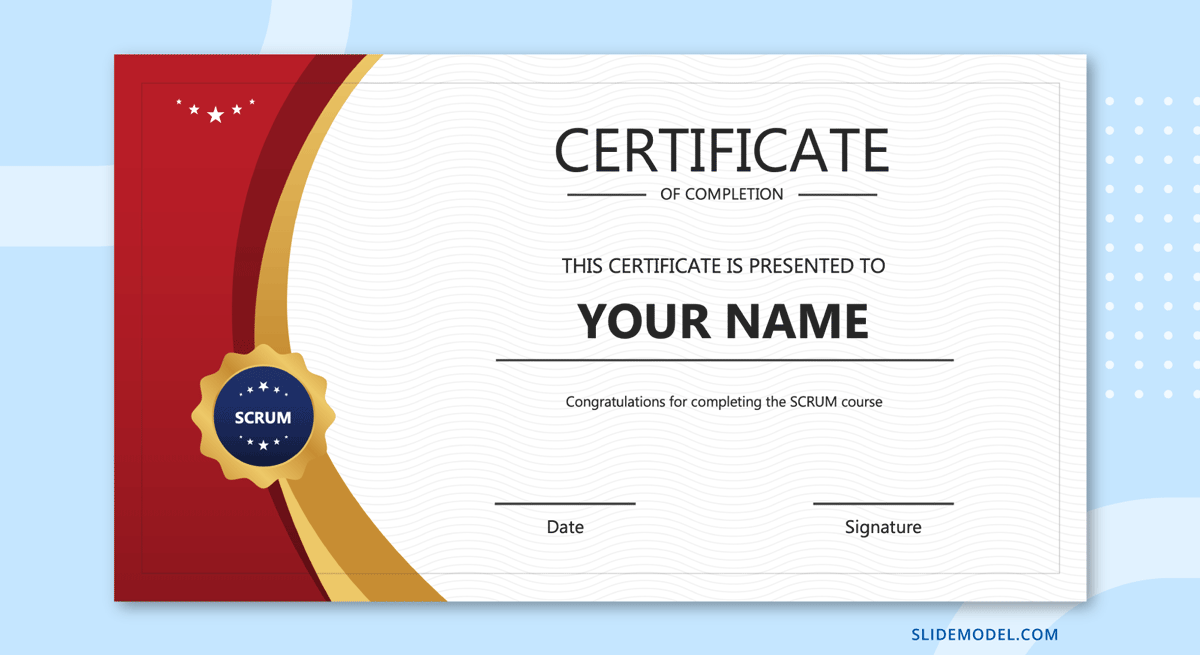
In less than three thousand words, you learned why training presentations are important for business, how to create and deliver them, plus tips on how to make your training presentations amazing.
Your L&D team and all your trained employees will benefit from optimized training presentations that use SlideModel templates for PowerPoint and Google Slides. Support your learners with visuals and instructional infographics. Start downloading educational templates today.
Like this article? Please share
Presentation Approaches, Presentations Filed under Education , Presentation Ideas
Related Articles
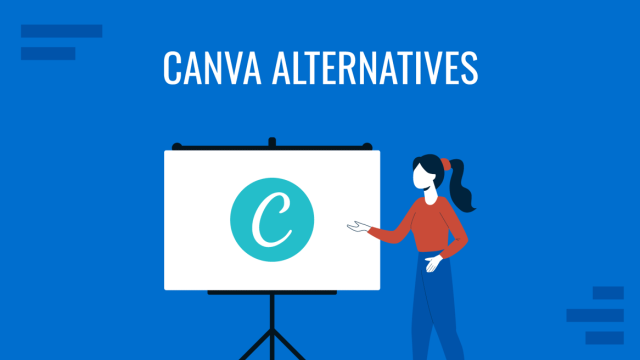
Filed under Design • September 11th, 2024
8 Best Canva Alternatives for Presentations in 2024
Don’t feel restricted about what one application can do for presentation design. Meet a list of the best Canva alternatives in this article.

Filed under Design • August 14th, 2024
Creating Custom Themes for PowerPoint and Google Slides
Do you want your slides to go beyond the average result from a template? If so, learn how to create custom themes for presentations with this guide.

Filed under Business • July 24th, 2024
How to Create a Demo Presentation
Discover the secrets behind successful demo presentations and what they should contain with this article. Recommended PPT templates included.
Leave a Reply
Newly Launched - AI Presentation Maker

Researched by Consultants from Top-Tier Management Companies
AI PPT Maker
Powerpoint Templates
PPT Bundles
Icon Bundle
Kpi Dashboard
Professional
Business Plans
Swot Analysis
Gantt Chart
Business Proposal
Marketing Plan
Project Management
Business Case
Business Model
Cyber Security
Business PPT
Digital Marketing
Digital Transformation
Human Resources
Product Management
Artificial Intelligence
Company Profile
Acknowledgement PPT
PPT Presentation
Reports Brochures
One Page Pitch
Interview PPT
All Categories
Top 7 Training Presentation Templates with Examples and Samples
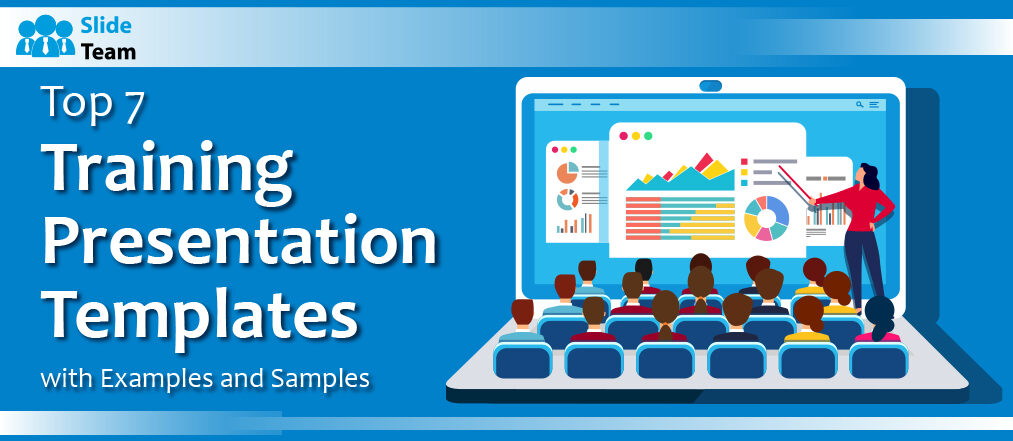
Sherin Sethi
“The only thing worse than training your employees and having them leave is not training them and having them stay.” - Henry Ford
Employee training and productivity optimization have increased thanks to integrated learning and hybrid work environments. These days, corporate training consists of an array of live online courses, SCORM courses that workers can take at their leisure, and in-person group sessions.
Training is the fuel for development, creativity, and employee empowerment—it's not just a box to be checked during the onboarding process. Teams that get practical training are equipped with the knowledge and abilities necessary to meet the expectations of their specific field of work. It's essential for maximizing potential, encouraging teamwork, and ensuring that everyone in your organization has the tools necessary to give their all.
According to a Fierce Inc. survey, 86% of executives and workers attribute workplace failures to ineffective communication and cooperation. Thus, the modern corporate world greatly needs effective business communication. In light of this SlideTeam curated the Top 10 Business Communication Training Presentations to make the task easier.
Training presentations are the foundation of the efficient flow of data. They create a bridge between knowledge and understanding, breaking down complex ideas into easily understood nuggets. An effective presentation may engage your audience, improve retention, and lead to thought-provoking conversations.
Picture yourself as a mid-level marketing manager in a bustling technology company. You are given a task to deliver a compelling training session to your team. You know the importance of effective presentations, but the challenge of crafting engaging content that aligns with your industry and captivates your audience is real.
You are not alone in this. The struggle of developing training presentations that are visually-appealing, educational, and engaging for the trainees is one that many professionals experience. With the help of our pre-designed PowerPoint Templates, draft your training presentations like a breeze. These top 7 training presentation templates are 100% editable and customizable. This gives you the time to focus on the content rather than the design of the presentation.
Let's explore the Templates now!
Template 1: Business Development Training template
This PowerPoint bundle includes a total of 78 slides that showcase the value of training and development initiatives for businesses to maintain current expertise among staff members and address any skills shortages. It highlights the interpersonal, communication, emotional intelligence, and other abilities needed for employees to achieve their objectives and keep a positive mindset inside the company. Additionally, this deck offers leadership abilities like strategic thinking and people management, which support treating staff members just and favorably while enhancing their self-assurance and productivity. It emphasizes technical abilities, including proficiency with program writing like Python, SQL presentation strategies, etc.
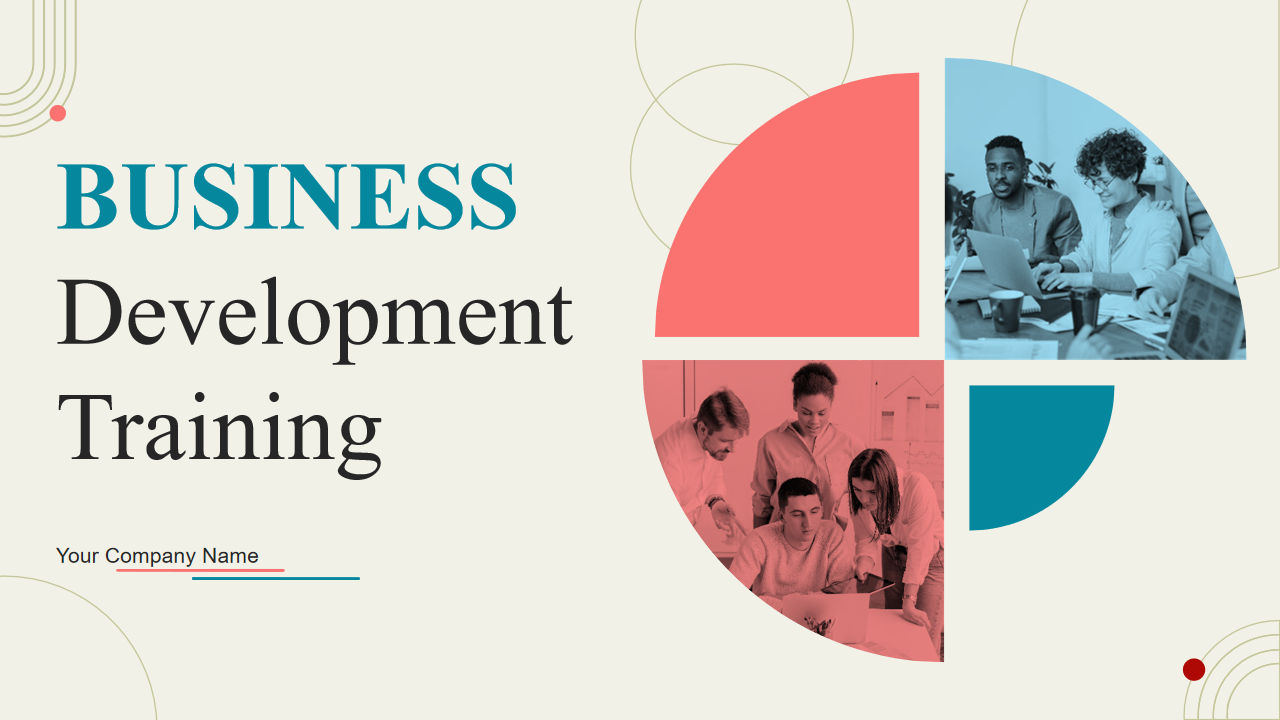
Download Now!
Template 2: Workforce Training Template
This PowerPoint Bundle highlights the relevance of workforce training to keep your employees up to date. It consists of several coaching programs showcasing various methods to train your employees, the importance of coaching for employees and employers across the firm, etc. It also includes training guidelines for employees at the workplace and a game plan for maximizing their performance. Aiding employees in achieving their personal goals by lending additional support and enabling personalized learning experiences to manage skill gaps are also part of this informative bundle.

Template 3: Learning Management System Training Program template
This informative deck, a compilation of 46 slides, depicts your organization's requirement for a learning management system. Issues like delays in the project, employees suffering from skill gaps in compliance with their job profiles, and low conversion rates, which lead to the need for training within the organization, are a part of this bundle. Developing a training program that could be classroom-based, online training sessions, or on-the-job training, etc, is also included.
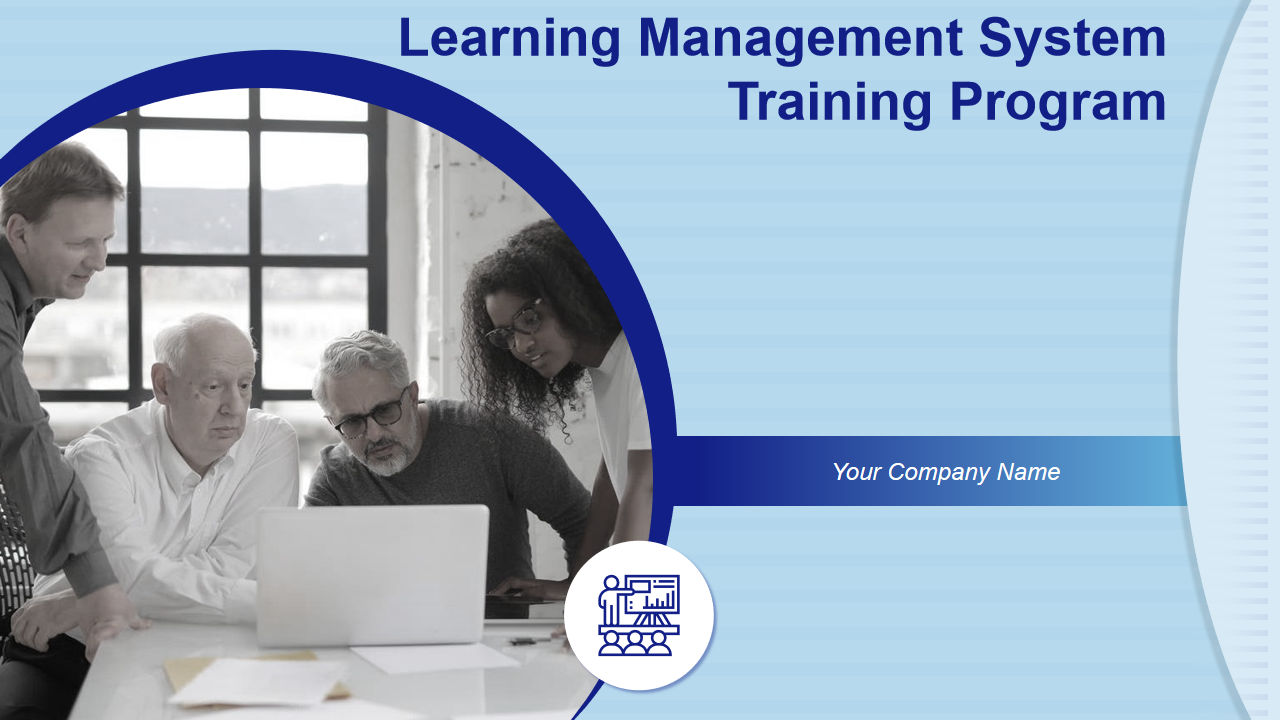
Download now!
Template 4: Employee Training Program Proposal Template
The core component of any successful business lies in efficient personnel administration. It is now essential for businesses to focus on the overall growth and development of employees in the workplace. The employee training program becomes essential to train newly hired employees and help them adjust to their roles. This informative bundle includes evaluating employees by assigning them tasks, providing feedback, conducting ice-breaking sessions between the trainer and employees, etc. The timeline of the training program, vision, and mission of the training program, along with past client testimonials, are also included.
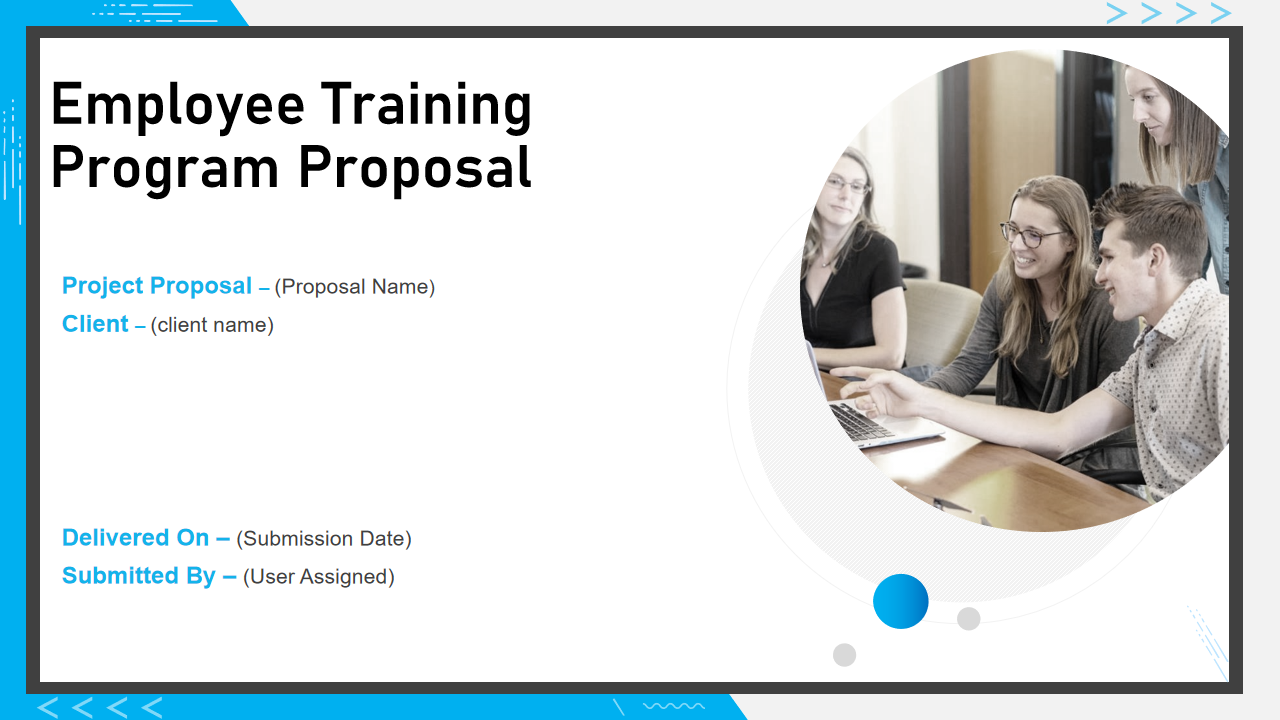
Template 5: Training proposal template
This PowerPoint Template is a deck of 29 slides. It depicts an in-depth proposal regarding corporate training and professional growth. Objectives and actions such as team building workshops, ensuring the stability of the business, time management, etc., are included. These must be carried out during the training session, along with identifying the responsibilities of the teams and employees. Drafting a budget and presenting an estimated time of the course is also a part of this informative bundle.

Template 6: Workshop Training Proposal Template
Professional grooming has become essential to human resource management, encompassing anything from writing formal emails to being proficient in the newest software and engaging in fundamental communication and personality development activities. This PowerPoint Slide presents an outline for pitching your company’s resources for training your clients’ employees. It showcases a cover letter, table of contents that allows you to get through all the major highlights of the presentation, objectives, and project context. Components of your proposed workshop, like corporate communication, Microsoft suite proficiency, personality development, etc, are included with this training proposal. Specially designed graphs, charts, and line diagrams ensure your pitch is presented in the best possible outline. The training objectives of the workshop, like social media presence management, formal etiquette, corporate lingo fluency, fundamentals of finance, and more, are also presented.
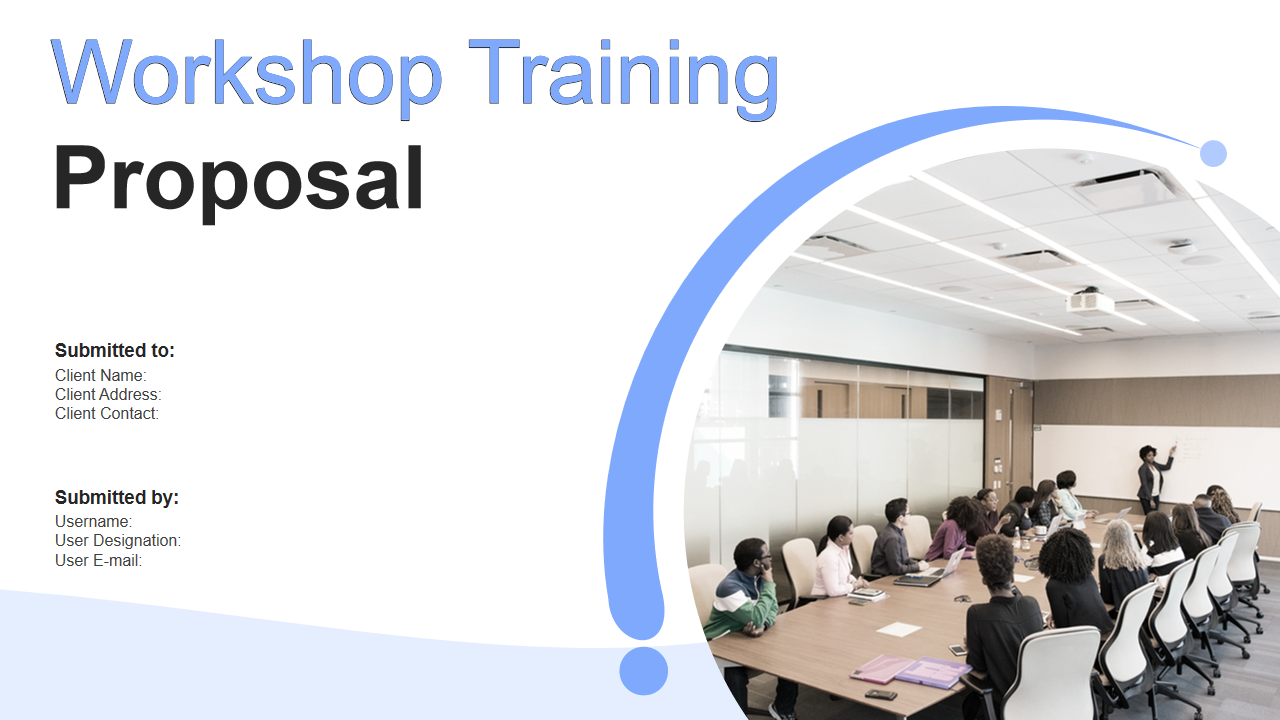
Template 7: Training And Development Powerpoint Template
This PowerPoint Template set showcases how training and development maximize the performance of employees in an organization. It includes an interactive learning roadmap of planning, delivering, and evaluating. This eye-catching deck includes a personalized development plan, a professional development plan, monitoring, and feedback, along with information about the team, the vision of the organization, and its goals.

Template 8: Training Schedule Powerpoint Template
This PPT Slide showcases the importance of a training schedule for smoothly conducting the tasks. The training schedule for enhancing email writing skills, improving communication skills, or any other skill businesses require to stay ahead of cut-throat competition from their competitors is presented in different colors for a clear understanding of the client.
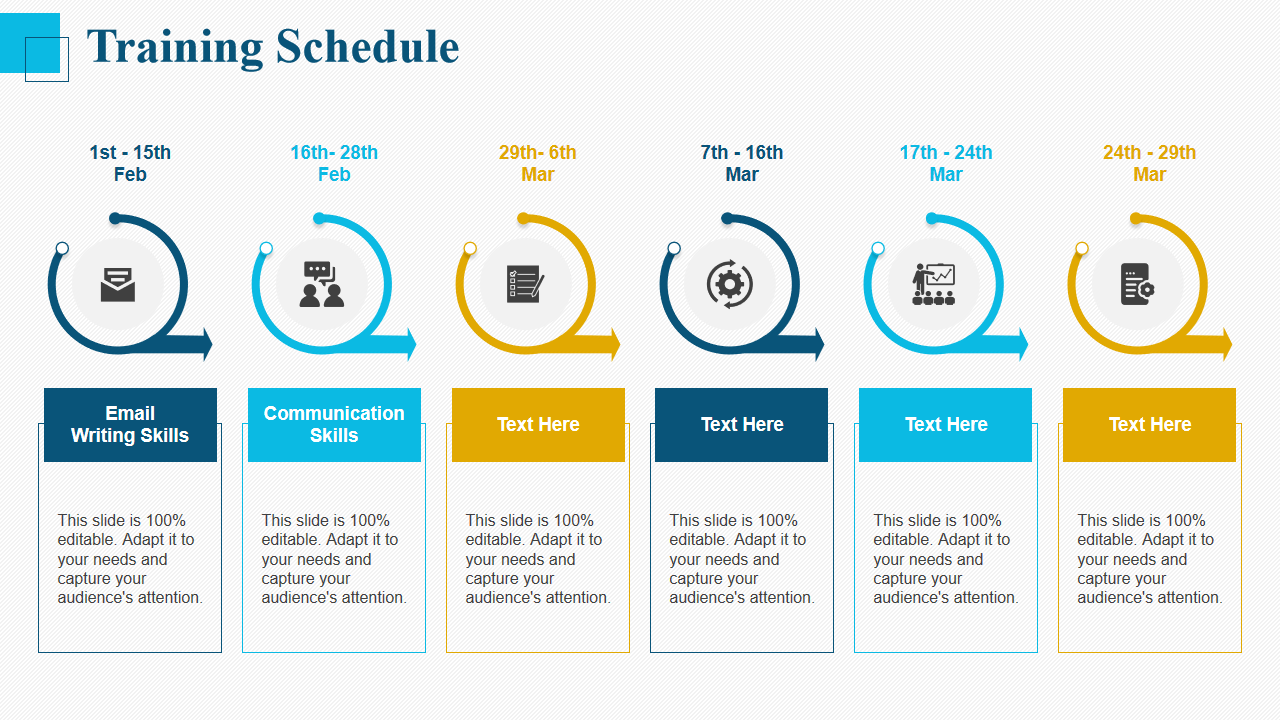
Elevate Your Training Sessions
It is not just the information but also how it is delivered that makes training impactful. You may enhance your training sessions with our tailored training presentation templates, curated to your needs. Whether you are holding client presentations, team training, or product launches, our PowerPoint Templates for training presentations offer a polished and captivating framework that ensures consistency and saves you time. The meticulously planned layouts, interactive features, and attention to detail will captivate the audience, making your training sessions more memorable and successful.
Related posts:
- How to Design the Perfect Service Launch Presentation [Custom Launch Deck Included]
- Quarterly Business Review Presentation: All the Essential Slides You Need in Your Deck
- [Updated 2023] How to Design The Perfect Product Launch Presentation [Best Templates Included]
- 99% of the Pitches Fail! Find Out What Makes Any Startup a Success
Liked this blog? Please recommend us

Top 5 Critical Analysis Templates with Samples and Examples

Top 10 Recruitment Budget Templates with Samples and Examples
This form is protected by reCAPTCHA - the Google Privacy Policy and Terms of Service apply.

You’re using an older browser version. Update to the latest version of Google Chrome , Safari , Mozilla Firefox or Microsoft Edge for the best site experience. You are using an outdated browser, so there may be issues with displaying the page. To make the website work correctly, use the latest version of one of these browsers: Google Chrome , Safari , Mozilla Firefox or Microsoft Edge .
- Corporate Training
- Course Selling
- Academic Learning
- Learning Basics
- Instructional Design
- Online Training Tools
- Manufacturing
- Products iSpring Suite iSpring Learn
- Use Cases Training organizations Onboarding Compliance Training Induction Training Product Training Channel Partner Training Sales Training Microlearning Mobile Learning
- Company About Us Case Studies Customers Partnership Course Development Contact Us
- Knowledge Hub Knowledge Hub Academy Webinars Articles Guides Experts on iSpring
- Language EN English Français Deutsch Español Italiano Nederlands Português Polski 中文 日本語 العربية Indonesia
- Shopping Cart
How to Create a Training PowerPoint Presentation

content creator
Charuan Aguilera See full bio →

A well-designed PowerPoint training presentation can be a powerful tool for conveying information, fostering training skills, engaging learners, and facilitating understanding. This type of presentation can be applied in many industries and can suit different learning styles.
Whether you’re a seasoned trainer looking to enhance your presentation skills or are new to the world of instructional design, this article will guide you through the essential steps to create a training PowerPoint presentation that captivates your audience and delivers meaningful learning outcomes.
What Is a Training Presentation?
A training presentation is a visual tool designed to deliver knowledge in a structured and engaging way in different training contexts.
It is a format that allows instructors to present training materials that keep the audience responsive and motivated, promoting comprehension and retention.
Training presentations are used extensively in educational settings and in staff training. Whether you’re introducing new employees to company policies, teaching students a complex subject, or demonstrating how to use a new software tool, training presentations make learning more effective and engaging.
A good training presentation is a combination of several design and structural elements that ultimately enhance learning effectiveness. Here are some key elements of training presentations:
- Content . The core of a training presentation is the content you deliver to your audience. It’s the information you want your trainees to absorb, memorize, and use effectively in the future.
- Visuals . Visual elements play a crucial role in training presentations. Besides using slides with text, presenters also include graphics, images, and even interactive elements . These visuals help learners better understand and remember the training material.
- Structure . Even with top-notch content and amazing visuals, if the presentation structure is not organized logically, the audience will have a hard time understanding it. That’s why a clear outline is needed so the learners can follow the flow of information and build their knowledge during the training session.
- Practical exercises and assessments . It’s a good idea to include assessments or quizzes in your training presentations to determine participants’ understanding and measure the effectiveness of the training. As an instructor, you can also integrate real-life cases and scenarios to help trainees put the recently acquired knowledge into practice.
The Importance of Effective Training Presentations
In short, an effective training presentation lays the foundation for more profound training experiences. By structuring information logically and using engaging visuals and interactive elements, training presentations improve training and promote efficient retention of knowledge.
An effective training presentation can become a powerful tool for employee training and professional development because it:
- allows the participants to visualize the training content in a logical structure;
- can be adapted to accommodate different learning styles;
- improves the skill development process for both new and seasoned employees;
- provides a tangible resource that trainees can revisit when they want to refresh their knowledge.
Types of Training Presentations
Training presentations come in many forms, depending on learning goals, target audiences, and training contexts. Understanding the different types of training presentations can help you choose the format that’s most suitable for achieving your training objectives.
Let’s take a closer look at some common types of training presentations:
1. Informative Presentation
Informative presentations are the foundation of knowledge transfer. They are designed to deliver key information, facts, or concepts to the training audience. Informative presentations often rely on an instructor with great presentation skills who leads the session.
Some examples of this type of presentation are:
- Lecture-style presentations
- Product knowledge training
- Safety briefings
- Compliance training
These presentations often include a summary slide that highlights what the trainees should take away from the session.
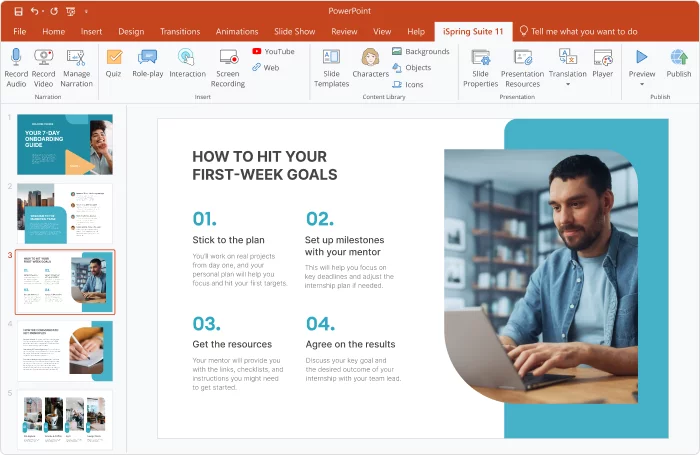
2. Skill Development Presentation
Skill development presentations are all about hands-on learning. They provide trainees with opportunities to gain practical skills or new professional competencies. These presentations typically include:
- Demonstrations
- Guided exercises
- Interactive simulations and role-plays
- Feedback and evaluations
All these elements help participants put theory into practice right away. Skill development presentations can also come in the form of pre-recorded video presentations that illustrate how the skills work in real life.
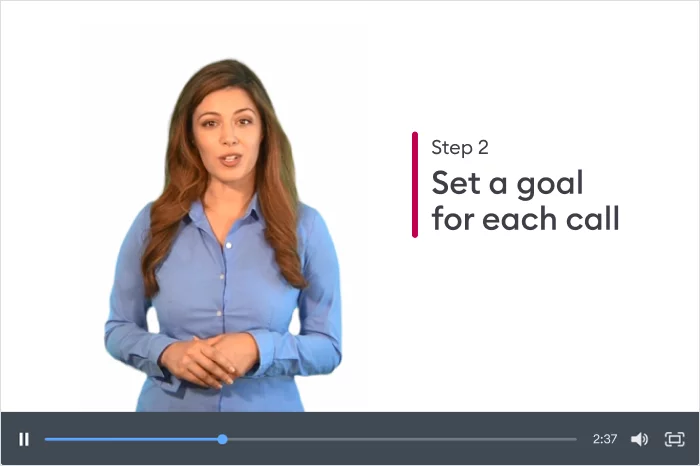
You can use the following questions to define your training presentation’s objectives:
- What do you want your audience to learn from the presentation?
- What specific skills or knowledge should they acquire?
- How will this training benefit the organization?
- Is there a behavioral change you want to achieve?
- How can you measure the success of your training presentation?
Step 2. Outline the structure
The next step is to define the structure of your PowerPoint presentation . Break down your content into logical sections or modules . Prioritize key information and decide on the main points you want to cover in each section.
You can divide your presentation into sections based on the main topics, the key skills, or the type of activity you’re going to include in the training. It’s up to you to choose the structure. Just make sure to follow it consistently throughout the presentation.
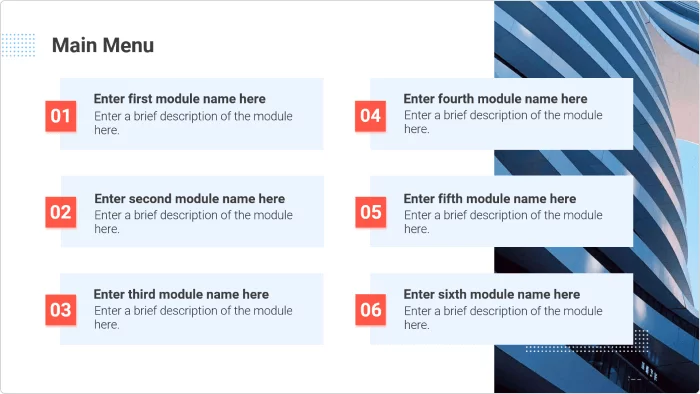
Content creator
Charuan Aguilera
A learning and training enthusiast, Charuan seeks to empower his readers with the latest insights and trends in e-learning.

How to Make a Training Video Right in PowerPoint

How to Remove the Background From a Picture in PowerPoint

How to Create an Interactive PowerPoint Presentation
We use cookies to collect info about site visits and personalize your experience. See our Cookie Policy for more details.
Manage your cookies
Essential cookies are always on. You can turn off other cookies if you wish.
Essential cookies
Analytics cookies
Social media cookies

Our Top 8 Tips For Creating Effective Training Presentations!
Table of contents.
Staff training for all employees, including managers, supervisors, and executives, is vital to an efficient and safe working space. For optimal results, you not only need active participants and good public speaking skills, but you need effective training materials that are easy to digest.
If you’re hoping to create a staff training PowerPoint presentation, or any other training material, this is the place to be. Here’s our guide to creating effective training presentations that leave lasting impressions on your trainees .
What Is A Training Presentation?
As many individuals in the human resources department know, employee training is mandatory for employees to complete when they start a job.
A training presentation is a learning material that helps build the right skills that employees need in order to perform their jobs accurately. For optimal results, your training presentations should include lessons that showcase the specialized knowledge in well-structured and easy-to-read slides .
An effective presentation will create a great learning experience for your audience and will illustrate the main message throughout the presentation.
Youth Employment Services Training Presentation
Youth Employment Services (YES) was faced with the challenge of developing a training series aimed at you guessed it, increasing youth employment. A typical PowerPoint just wasn’t captivating enough, so we gave them an engaging presentation from start to finish.
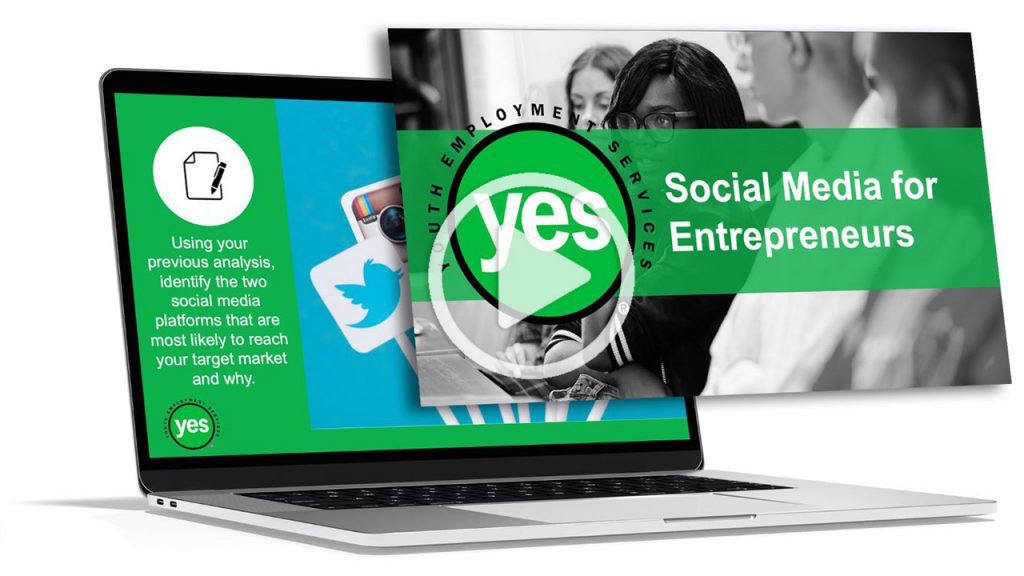
Why Are Effective Employee Training Presentations Beneficial To My Company?
Providing relevant training information to your team is extremely important to the overall safety and efficiency of your company. A solid training presentation that can provide knowledge and important information to your participants can benefit your company in a number of ways. Here are just a few that come to mind:
Peace Of Mind
First, a training presentation can provide peace of mind to your organization. When your team members fully understand the importance of safety requirements or the different responsibilities of their job, it means you can rest assured that they are well equipped for daily tasks and emergency situations.
Employee Retention
Another benefit of effective training presentations is employee retention. When your employees fully understand their role in your organization and feel equipped and supported, they are more likely to stay in their role. Also, knowledge is power and development/progression is more than just monetary.
Setting Standards & Expectations
Finally, an effective training course will ensure that your team members have a set of clear expectations and standards to hold to throughout their time at your company. Clear expectations for your employees can not only lead to a more efficient workplace, but can also create a safer and healthier work environment.
5 Tips That Ensure You Have An Effective Training Presentation

Now that we understand what a training presentation is and why a good presentation is so beneficial for your company, we can focus on how to create a professional and effective training presentation.
Here are 5 training presentation tips that you can use to enhance your training Powerpoint slides and keep the materials interesting to your audience:
Tell Your Story And Articulate Your Learning Goals
When you present your training course to your employees, you want to first start with a summary of the organization’s story and what your main goals are. Your brand’s story should be woven throughout the presentation so that everything ties back together. This solid structure will allow you to build off it and further engage your audience.
In order to engage your team you want them to understand why your business exists and what the main mission or key goals are. When you include these things in your Powerpoint presentation, you can further engage your audience.
As seen in this training presentation for Soccer Shots , the organization’s mission and main goals are clearly articulated at the beginning of the training session.
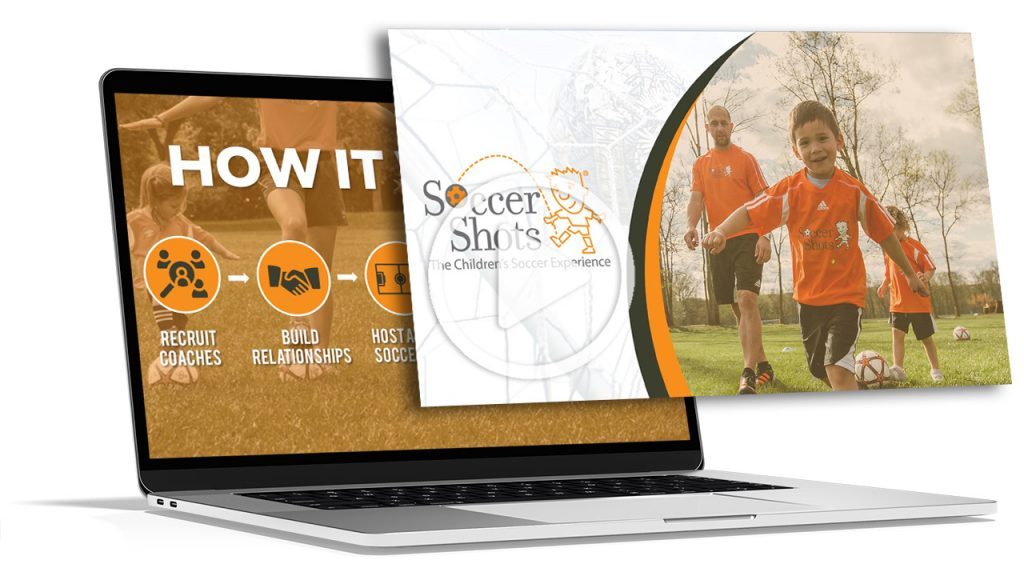
Make Your Presentation Accessible
In order to even fully engage your students at a training session, they need to be able to hear the presenter and see and read the slides.
Creating an accessible presentation will allow every person in the audience to gain knowledge from the Powerpoint slides.
Accessibility can mean different things for different people, so it’s important to know what kind of needs your audience requires. For example, you may need to use a larger text size, a microphone, a clear font, sign language, or narration throughout the presentation.
As a presenter, it’s important to ensure that everyone present at the session is able to reach each slide, complete each task, and can hear the trainer’s speech.
Cater To Different Learning Styles
Another aspect of a good training presentation is understanding that everyone learns differently. Where some employees can gain a lot of knowledge from slides full of bullet points, other employees may need more interactive elements during the training presentation.
To ensure that your professional training presentation appeals and engages all types of learners, you should try to include a variety of elements in your PowerPoint presentation design .

For example, you might include more graphics, images, or videos that can talk for you. Or, you can have specific conversations starters where participants can engage in conversation with the trainer and the other audience members.
Too much text can lead to an information overload that can cause participants to zone out while the trainer is talking. Instead, structure your presentation slides with some white space so your audience isn’t overwhelmed with information.
Use Real World Examples In Your Training Sessions
Another way to boost training skills in a good training presentation is throughout using real life examples. While data charts and abstract ideas can provide extremely helpful information to participants, real world examples can allow that information to stick.
People are more perceptive to ideas that make an impact on their own lives. So, if you include examples from daily life to illustrate and explain your point, you may find that your audience is more engaged in the training presentation.
Now, use your findings to integrate realistic situations as examples or exercises that show trainees the value of your session. The key to an engaged and motivated audience is to keep things real.
Design Is Critical, So Don't Underestimate It
One of the most important tips for creating effective training presentations is that design matters. As much as it may seem that the information is more important than the design for a training course, the design is actually very critical.
Not only can your design reinforce your brand image and brand identity, but it can further engage your participants. Charts that showcase data and information, graphics, high quality images, eye catching colours, and smooth transitions can all help you make a powerpoint presentation that gets your point across effectively.
A great presentation template and slide deck will have a organic design that not only pleases the eye, but will explain important information to your audience.
Consider Additions or Alternatives To Help Support Your Training Efforts
An effective presentation isn’t just about the slides. There are other components that you need to keep in mind before leading your presentation.
Practice Your Presentation Skills
For one, the trainer will need to practice the presentation ahead of the course.
Good public speaking skills and having a strong idea of what you are talking about can all help with creating an effective and engaging presentation.

Use Effective Handouts
You may also want to use handouts to aid your presentation, but make sure it isn’t just information that is already on a slide in your presentation.
Whether it’s an article with more information, notes about the course, a summary of information, or further tips, handouts can be beneficial for your audience.
Hire a Design Agency
Finally, you should consider hiring a presentation design agency to help you create these slides.
While a presentation template can be a good starting point, a great presentation requires a lot more time, effort, and skill. A professional design agency can take this task off your hands so you can focus on the speech aspect.
This was the case for a Lawyer at BelkerPalm Legal who was giving a presentation to a group of law students. Although his experience was vast and his presentation skills were strong, he didn’t have the visuals to back him up. He was relieved to find the Geeks!

Need Help Designing Your Training Materials?
Look no further than the geeks!
We’re a presentation and training manual design company that truly understand how crucial it is building effective training materials for new employees. We’ve done it for clients, and ourselves, but we always put you first.
Author: Content Team
Related posts.


FREE PROFESSIONAL RESOURCES DELIVERED TO YOUR INBOX.
Subscribe for free tips, resources, templates, ideas and more from our professional team of presentation designers.
Elevate Your Training Presentations: A Detailed Guide
Imagine that you have been tasked with training employees for an onboarding process . Right from the company culture to personnel roles, you must discuss each detail. Your goal is to create an effective presentation that leaves a valuable experience. However, you get cold feet and feel blue as crafting these slides feels like an enormous task!
Thus, whether you are a seasoned trainer looking to enhance your skills or a novice embarking on your first training endeavor, this guide will provide valuable insights and practical tips to create presentations that captivate, educate, and inspire. Get ready to unlock the full potential of your sessions and profoundly impact your audience’s lives and careers.
We have divided the article into two parts –
How to Create Effective Training Presentations
How to deliver effective training presentations, 1. define your key objectives.
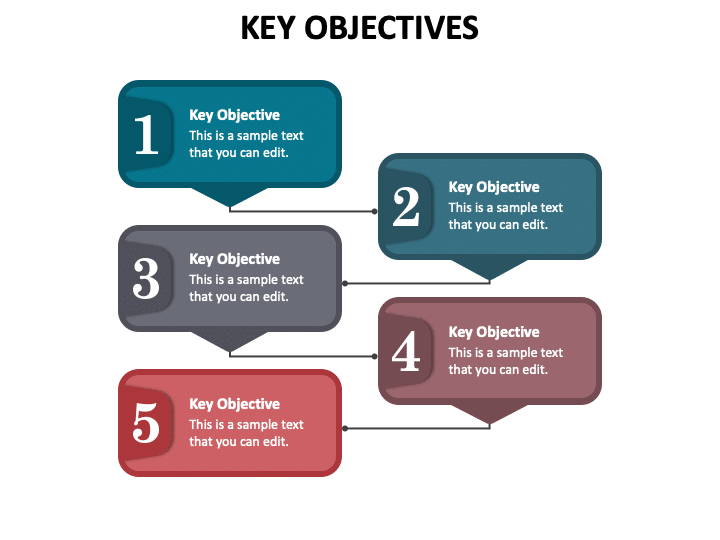
Clear learning objectives are the foundation of any successful training presentation. Take time to define what you want your audience to achieve or learn by the end of the seminar. Avoid vague goals and opt for specific, measurable ones that can drive results.
For example, if your training presentation is about improving customer service skills, a well-defined objective could be: “By the end, participants will be able to handle customer complaints effectively and use active listening techniques to enhance customer satisfaction.”
2. Know Your Audience
Understanding your audience is crucial. It can allow you to gauge their problems and pain points.
You can conduct an audience analysis and gather data during the registration process about their demographics, existing knowledge, languages, experience level, challenges, and preferred learning styles. This information will help you tailor your content, examples, and language to resonate with your audience effectively.
For instance, if your audience consists of beginners, avoid jargon and complex terms that might overwhelm them. You can start with simple terms and concepts and gradually enhance them accordingly.
3. Gather and Organize Content
Thoroughly research and gather relevant content. Use a mix of primary and secondary sources to ensure accuracy and credibility, and rely only on trusted data sources. You can divide your presentation into three parts to allow easy comprehension-
Commence with a simple introduction and brief your audience about what they can expect from the presentation. Tell them concisely about the topic and show how your slides can benefit them. You can even include any instructions or decorum rules that they must follow.
This section includes the meat of the presentation. It talks about your entire training process, methodologies, pros and cons, techniques, personal experience, anecdotes, etc. Ensure that this part is interesting and explicit.
Conclude by summarizing your entire presentation in key points. Prepare a list of frequently asked questions, display them on the screen, and then open the floor for discussions and doubts. End on a positive note and include a call to action.
By sequentially structuring the content, you can make it easier for learners to follow and understand the material.
4. Craft a Compelling Narrative
A compelling narrative is crucial to keep your audience hooked. You must start with a captivating story that grabs their attention and ignites their interest in the topic. This can be done by sharing any personal experience you may have in the given field, talking about an imaginary narrative, etc. By weaving a story, you allow the viewers to imagine a life-like situation that resonates more with them.
For instance, for an employee training program, you can talk about your experience when you were onboard and how difficult it was to navigate the challenges. Showcase how your organization now provides solutions for each one of them, and make the newcomers feel at home.
5. Use Engaging Visuals

Harnessing the power of visuals is extremely crucial for a successful presentation. By incorporating stunning graphics, you can support your points, break down complex information into simpler terms, and avoid text-heavy slides.
However, if you find it difficult to craft visuals or create presentations from scratch, you can use expert-designed presentation templates and graphics for your slides. They can be completely customized, right from the font to the colors; each element can be adjusted according to you.
6. Focus on Slide Consistency
Consistency in your presentation ensures that each slide looks cohesive and aligned with your overall message. When your slides follow a particular design pattern, the audience can focus without any distractions.
Start by using a brand palette, a collection of skillfully selected colors that represent your organization’s identity and values.
Be mindful of using accessible typography that would be visible to people sitting at the back as well. Use and combine appropriate fonts for the heading, subheading, and body text, and make sure that they are aligned properly.
Remember to strike a balance between using brand elements effectively and avoiding overwhelming the audience with excessive visual elements. With a well-designed and consistent presentation, you can effectively convey your message.
7. Incorporate Interactivity
Interactive elements make training presentations more engaging and increase audience participation. Including activities such as group discussions, quizzes, and exercises that encourage active learning can enable you to create a more lively environment.
It also allows participants to apply their knowledge and receive immediate feedback, enhancing retention and understanding.
For instance, you can incorporate live polls and quizzes, whose results can be generated in real-time and allow you to analyze where the audience stands and how much they have gathered from your presentation.
1. Practice and Rehearse
Preparation and practice are key to delivering a perfect and polished presentation. Familiarize yourself with the content and practice your delivery multiple times. Pay attention to your tone, pitch, and expressions during the rehearsal.
It also helps you identify potential stumbling points and loopholes where you need to work more. It also reveals areas where information needs to be added or removed.
You can practice by looking into a mirror and repeating your delivery or inviting colleagues or friends to be your practice audience and asking for their feedback.
2. Know Your Material Inside Out
To deliver a training presentation with confidence and authority, thoroughly familiarize yourself with the content. When you are completely prepared, the audience sees you as a credible source of information with expertise and knowledge.
You must study training materials, books, and any supplementary resources to gain an in-depth understanding of the topic. Be prepared to go beyond the slides and provide additional explanations or examples when required.
This level of preparedness instills confidence in your delivery and ensures that you can address any questions or concerns that may arise during the presentation.
3. Start Strong with a Strong Title
The first few minutes set the tone for the rest of your presentation. If you start slow, your audience might feel uninterested or get disappointed. However, when you begin with a compelling statement or a strong title, it instantly strikes the audience, compelling them to stay focused.
For example, if you are training a group of employees on sales, instead of commencing with “Sales Training Presentation,” you can say, “Mastering the Art of Sales: A Comprehensive Training Program.”
4. Maintain Confident Body Language
Your body language conveys much about your confidence as a presenter. Imagine attending a presentation where the presenter stands with stooped shoulders, has improper hand gestures, and keeps looking elsewhere instead of keeping his eyes on the audience. You are bound to feel annoyed and frustrated at such an event.
Thus, it is vital to stand tall, maintain good posture, and make eye contact to establish a strong presence. Avoid crossing your arms, as it may create a barrier between you and the participants.
Use natural gestures to emphasize key points and maintain an open and approachable demeanor. Confident body language helps build rapport with your audience and keeps them receptive to your message.
5. Maintain a Conversational Tone
Consider your presentation as a conversation rather than a monotonous lecture. Adopt a tone that would make participants feel as if they’re in a dialogue with you.
You can use rhetorics and inclusive language such as ‘we’ and ‘our’ to create a sense of shared experience. Doing so ignites a feeling of oneness and fosters a productive and approachable atmosphere.
6. Manage Time Effectively
When it comes to the stage, time management is one of the most important tools for any presenter. A well-timed presentation not only leaves behind a stunning impression but also ensures that all necessary points have been covered and questions answered.
However, it is not always necessary that your presentation goes as per your timing- many times, the audiences are slow learners. They require time to fathom facts and comprehend data. In such situations, you must adjust your pace. Keep supplementary resources prepared that you can hand out to them later.
7. Handle Q&A Sessions Gracefully
Encourage questions and discussions throughout the training, and allocate dedicated time for a question and answer session at the end. When addressing questions, maintain a patient and respectful attitude. Actively listen to the speaker and ensure that you understand it before providing your response.
If you don’t know the answer to a question, be honest about it and offer to follow up with the information later. Handling Q&A sessions gracefully builds trust with your audience and reinforces your expertise on the subject.
8. Gather Feedback
After the presentation, gather feedback from your audience. Use surveys, questionnaires, or open discussions to collect their insights and opinions on the content, delivery, and overall learning experience. Analyze their viewpoints to find areas that need to be worked upon.
Continuous improvement based on feedback ensures that your presentations become increasingly effective and better tailored to the needs of your learners.
9. End with a Strong Conclusion
Conclude your training presentation with a powerful summary of the key points covered throughout the session. Recap the main takeaways and relate them back to the learning objectives.
End on a positive and inspiring note, motivating the audience to apply what they have learned in their professional lives. By leaving a strong impression in the conclusion, you ensure that participants leave with a sense of motivation to implement their new knowledge and skills.
Creating training presentations requires careful planning, audience awareness, engaging content, and effective delivery. By following these steps and continuously refining your approach based on feedback, you can create compelling and impactful presentations that empower learners to succeed and grow.
Remember that such presentations are a dynamic and evolving process, and with dedication and creativity, you can deliver meaningful and transformative learning experiences.
We hope this article helps you in your future training endeavors.
Leave a Response Cancel reply
Save my name, email, and website in this browser for the next time I comment.
Please enter an answer in digits: 18 − fifteen =
Ashish Arora
You might also like.

Essential Tips to Find the Right Audience for Your Next Presentation
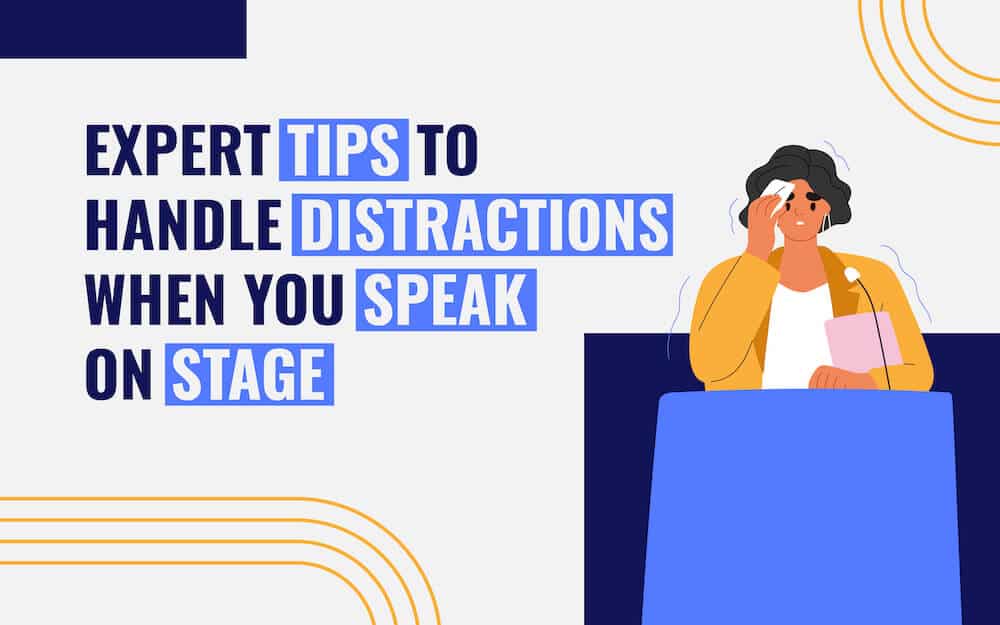
Expert Tips to Handle Distractions When You Speak on Stage

9 Tips to Craft the Perfect Title for Your Next PowerPoint Presentation

Unleash the Power of Agile Communication in the Fast-Changing Digital Realm
We use essential cookies to make Venngage work. By clicking “Accept All Cookies”, you agree to the storing of cookies on your device to enhance site navigation, analyze site usage, and assist in our marketing efforts.
Manage Cookies
Cookies and similar technologies collect certain information about how you’re using our website. Some of them are essential, and without them you wouldn’t be able to use Venngage. But others are optional, and you get to choose whether we use them or not.
Strictly Necessary Cookies
These cookies are always on, as they’re essential for making Venngage work, and making it safe. Without these cookies, services you’ve asked for can’t be provided.
Show cookie providers
- Google Login
Functionality Cookies
These cookies help us provide enhanced functionality and personalisation, and remember your settings. They may be set by us or by third party providers.
Performance Cookies
These cookies help us analyze how many people are using Venngage, where they come from and how they're using it. If you opt out of these cookies, we can’t get feedback to make Venngage better for you and all our users.
- Google Analytics
Targeting Cookies
These cookies are set by our advertising partners to track your activity and show you relevant Venngage ads on other sites as you browse the internet.
- Google Tag Manager
- Infographics
- Daily Infographics
- Popular Templates
- Accessibility
- Graphic Design
- Graphs and Charts
- Data Visualization
- Human Resources
- Beginner Guides
Blog Beginner Guides How To Make a Good Presentation [A Complete Guide]
How To Make a Good Presentation [A Complete Guide]
Written by: Krystle Wong Jul 20, 2023

A top-notch presentation possesses the power to drive action. From winning stakeholders over and conveying a powerful message to securing funding — your secret weapon lies within the realm of creating an effective presentation .
Being an excellent presenter isn’t confined to the boardroom. Whether you’re delivering a presentation at work, pursuing an academic career, involved in a non-profit organization or even a student, nailing the presentation game is a game-changer.
In this article, I’ll cover the top qualities of compelling presentations and walk you through a step-by-step guide on how to give a good presentation. Here’s a little tip to kick things off: for a headstart, check out Venngage’s collection of free presentation templates . They are fully customizable, and the best part is you don’t need professional design skills to make them shine!
These valuable presentation tips cater to individuals from diverse professional backgrounds, encompassing business professionals, sales and marketing teams, educators, trainers, students, researchers, non-profit organizations, public speakers and presenters.
No matter your field or role, these tips for presenting will equip you with the skills to deliver effective presentations that leave a lasting impression on any audience.
Click to jump ahead:
What are the 10 qualities of a good presentation?
Step-by-step guide on how to prepare an effective presentation, 9 effective techniques to deliver a memorable presentation, faqs on making a good presentation, how to create a presentation with venngage in 5 steps.
When it comes to giving an engaging presentation that leaves a lasting impression, it’s not just about the content — it’s also about how you deliver it. Wondering what makes a good presentation? Well, the best presentations I’ve seen consistently exhibit these 10 qualities:
1. Clear structure
No one likes to get lost in a maze of information. Organize your thoughts into a logical flow, complete with an introduction, main points and a solid conclusion. A structured presentation helps your audience follow along effortlessly, leaving them with a sense of satisfaction at the end.
Regardless of your presentation style , a quality presentation starts with a clear roadmap. Browse through Venngage’s template library and select a presentation template that aligns with your content and presentation goals. Here’s a good presentation example template with a logical layout that includes sections for the introduction, main points, supporting information and a conclusion:

2. Engaging opening
Hook your audience right from the start with an attention-grabbing statement, a fascinating question or maybe even a captivating anecdote. Set the stage for a killer presentation!
The opening moments of your presentation hold immense power – check out these 15 ways to start a presentation to set the stage and captivate your audience.
3. Relevant content
Make sure your content aligns with their interests and needs. Your audience is there for a reason, and that’s to get valuable insights. Avoid fluff and get straight to the point, your audience will be genuinely excited.
4. Effective visual aids
Picture this: a slide with walls of text and tiny charts, yawn! Visual aids should be just that—aiding your presentation. Opt for clear and visually appealing slides, engaging images and informative charts that add value and help reinforce your message.
With Venngage, visualizing data takes no effort at all. You can import data from CSV or Google Sheets seamlessly and create stunning charts, graphs and icon stories effortlessly to showcase your data in a captivating and impactful way.

5. Clear and concise communication
Keep your language simple, and avoid jargon or complicated terms. Communicate your ideas clearly, so your audience can easily grasp and retain the information being conveyed. This can prevent confusion and enhance the overall effectiveness of the message.
6. Engaging delivery
Spice up your presentation with a sprinkle of enthusiasm! Maintain eye contact, use expressive gestures and vary your tone of voice to keep your audience glued to the edge of their seats. A touch of charisma goes a long way!
7. Interaction and audience engagement
Turn your presentation into an interactive experience — encourage questions, foster discussions and maybe even throw in a fun activity. Engaged audiences are more likely to remember and embrace your message.
Transform your slides into an interactive presentation with Venngage’s dynamic features like pop-ups, clickable icons and animated elements. Engage your audience with interactive content that lets them explore and interact with your presentation for a truly immersive experience.

8. Effective storytelling
Who doesn’t love a good story? Weaving relevant anecdotes, case studies or even a personal story into your presentation can captivate your audience and create a lasting impact. Stories build connections and make your message memorable.
A great presentation background is also essential as it sets the tone, creates visual interest and reinforces your message. Enhance the overall aesthetics of your presentation with these 15 presentation background examples and captivate your audience’s attention.
9. Well-timed pacing
Pace your presentation thoughtfully with well-designed presentation slides, neither rushing through nor dragging it out. Respect your audience’s time and ensure you cover all the essential points without losing their interest.
10. Strong conclusion
Last impressions linger! Summarize your main points and leave your audience with a clear takeaway. End your presentation with a bang , a call to action or an inspiring thought that resonates long after the conclusion.
In-person presentations aside, acing a virtual presentation is of paramount importance in today’s digital world. Check out this guide to learn how you can adapt your in-person presentations into virtual presentations .

Preparing an effective presentation starts with laying a strong foundation that goes beyond just creating slides and notes. One of the quickest and best ways to make a presentation would be with the help of a good presentation software .
Otherwise, let me walk you to how to prepare for a presentation step by step and unlock the secrets of crafting a professional presentation that sets you apart.
1. Understand the audience and their needs
Before you dive into preparing your masterpiece, take a moment to get to know your target audience. Tailor your presentation to meet their needs and expectations , and you’ll have them hooked from the start!
2. Conduct thorough research on the topic
Time to hit the books (or the internet)! Don’t skimp on the research with your presentation materials — dive deep into the subject matter and gather valuable insights . The more you know, the more confident you’ll feel in delivering your presentation.
3. Organize the content with a clear structure
No one wants to stumble through a chaotic mess of information. Outline your presentation with a clear and logical flow. Start with a captivating introduction, follow up with main points that build on each other and wrap it up with a powerful conclusion that leaves a lasting impression.
Delivering an effective business presentation hinges on captivating your audience, and Venngage’s professionally designed business presentation templates are tailor-made for this purpose. With thoughtfully structured layouts, these templates enhance your message’s clarity and coherence, ensuring a memorable and engaging experience for your audience members.
Don’t want to build your presentation layout from scratch? pick from these 5 foolproof presentation layout ideas that won’t go wrong.

4. Develop visually appealing and supportive visual aids
Spice up your presentation with eye-catching visuals! Create slides that complement your message, not overshadow it. Remember, a picture is worth a thousand words, but that doesn’t mean you need to overload your slides with text.
Well-chosen designs create a cohesive and professional look, capturing your audience’s attention and enhancing the overall effectiveness of your message. Here’s a list of carefully curated PowerPoint presentation templates and great background graphics that will significantly influence the visual appeal and engagement of your presentation.
5. Practice, practice and practice
Practice makes perfect — rehearse your presentation and arrive early to your presentation to help overcome stage fright. Familiarity with your material will boost your presentation skills and help you handle curveballs with ease.
6. Seek feedback and make necessary adjustments
Don’t be afraid to ask for help and seek feedback from friends and colleagues. Constructive criticism can help you identify blind spots and fine-tune your presentation to perfection.
With Venngage’s real-time collaboration feature , receiving feedback and editing your presentation is a seamless process. Group members can access and work on the presentation simultaneously and edit content side by side in real-time. Changes will be reflected immediately to the entire team, promoting seamless teamwork.

7. Prepare for potential technical or logistical issues
Prepare for the unexpected by checking your equipment, internet connection and any other potential hiccups. If you’re worried that you’ll miss out on any important points, you could always have note cards prepared. Remember to remain focused and rehearse potential answers to anticipated questions.
8. Fine-tune and polish your presentation
As the big day approaches, give your presentation one last shine. Review your talking points, practice how to present a presentation and make any final tweaks. Deep breaths — you’re on the brink of delivering a successful presentation!
In competitive environments, persuasive presentations set individuals and organizations apart. To brush up on your presentation skills, read these guides on how to make a persuasive presentation and tips to presenting effectively .

Whether you’re an experienced presenter or a novice, the right techniques will let your presentation skills soar to new heights!
From public speaking hacks to interactive elements and storytelling prowess, these 9 effective presentation techniques will empower you to leave a lasting impression on your audience and make your presentations unforgettable.
1. Confidence and positive body language
Positive body language instantly captivates your audience, making them believe in your message as much as you do. Strengthen your stage presence and own that stage like it’s your second home! Stand tall, shoulders back and exude confidence.
2. Eye contact with the audience
Break down that invisible barrier and connect with your audience through their eyes. Maintaining eye contact when giving a presentation builds trust and shows that you’re present and engaged with them.
3. Effective use of hand gestures and movement
A little movement goes a long way! Emphasize key points with purposeful gestures and don’t be afraid to walk around the stage. Your energy will be contagious!
4. Utilize storytelling techniques
Weave the magic of storytelling into your presentation. Share relatable anecdotes, inspiring success stories or even personal experiences that tug at the heartstrings of your audience. Adjust your pitch, pace and volume to match the emotions and intensity of the story. Varying your speaking voice adds depth and enhances your stage presence.

5. Incorporate multimedia elements
Spice up your presentation with a dash of visual pizzazz! Use slides, images and video clips to add depth and clarity to your message. Just remember, less is more—don’t overwhelm them with information overload.
Turn your presentations into an interactive party! Involve your audience with questions, polls or group activities. When they actively participate, they become invested in your presentation’s success. Bring your design to life with animated elements. Venngage allows you to apply animations to icons, images and text to create dynamic and engaging visual content.
6. Utilize humor strategically
Laughter is the best medicine—and a fantastic presentation enhancer! A well-placed joke or lighthearted moment can break the ice and create a warm atmosphere , making your audience more receptive to your message.
7. Practice active listening and respond to feedback
Be attentive to your audience’s reactions and feedback. If they have questions or concerns, address them with genuine interest and respect. Your responsiveness builds rapport and shows that you genuinely care about their experience.

8. Apply the 10-20-30 rule
Apply the 10-20-30 presentation rule and keep it short, sweet and impactful! Stick to ten slides, deliver your presentation within 20 minutes and use a 30-point font to ensure clarity and focus. Less is more, and your audience will thank you for it!
9. Implement the 5-5-5 rule
Simplicity is key. Limit each slide to five bullet points, with only five words per bullet point and allow each slide to remain visible for about five seconds. This rule keeps your presentation concise and prevents information overload.
Simple presentations are more engaging because they are easier to follow. Summarize your presentations and keep them simple with Venngage’s gallery of simple presentation templates and ensure that your message is delivered effectively across your audience.

1. How to start a presentation?
To kick off your presentation effectively, begin with an attention-grabbing statement or a powerful quote. Introduce yourself, establish credibility and clearly state the purpose and relevance of your presentation.
2. How to end a presentation?
For a strong conclusion, summarize your talking points and key takeaways. End with a compelling call to action or a thought-provoking question and remember to thank your audience and invite any final questions or interactions.
3. How to make a presentation interactive?
To make your presentation interactive, encourage questions and discussion throughout your talk. Utilize multimedia elements like videos or images and consider including polls, quizzes or group activities to actively involve your audience.
In need of inspiration for your next presentation? I’ve got your back! Pick from these 120+ presentation ideas, topics and examples to get started.
Creating a stunning presentation with Venngage is a breeze with our user-friendly drag-and-drop editor and professionally designed templates for all your communication needs.
Here’s how to make a presentation in just 5 simple steps with the help of Venngage:
Step 1: Sign up for Venngage for free using your email, Gmail or Facebook account or simply log in to access your account.
Step 2: Pick a design from our selection of free presentation templates (they’re all created by our expert in-house designers).
Step 3: Make the template your own by customizing it to fit your content and branding. With Venngage’s intuitive drag-and-drop editor, you can easily modify text, change colors and adjust the layout to create a unique and eye-catching design.
Step 4: Elevate your presentation by incorporating captivating visuals. You can upload your images or choose from Venngage’s vast library of high-quality photos, icons and illustrations.
Step 5: Upgrade to a premium or business account to export your presentation in PDF and print it for in-person presentations or share it digitally for free!
By following these five simple steps, you’ll have a professionally designed and visually engaging presentation ready in no time. With Venngage’s user-friendly platform, your presentation is sure to make a lasting impression. So, let your creativity flow and get ready to shine in your next presentation!
Discover popular designs

Infographic maker

Brochure maker

White paper online

Newsletter creator

Flyer maker

Timeline maker

Letterhead maker

Mind map maker

Ebook maker
- AI Community
- L&D On-Demand
Cracking the Code: Proven Strategies for Successful Training Presentations

Jamie Smith

Mastering Training Presentations
When it comes to delivering training presentations, mastering the art is crucial for ensuring effective knowledge transfer and engagement. In this section, we will explore the importance of effective training presentations and discuss key strategies that can help you succeed in your training endeavors.
Importance of Effective Training Presentations
Effective training presentations play a vital role in maximizing the learning experience for your audience. They provide a structured and organized approach to deliver information, making it easier for learners to comprehend and retain the material. Here are some reasons why effective training presentations are important:
Clear Communication : Training presentations allow you to communicate complex concepts and ideas in a clear and concise manner. By using visual aids, examples, and interactive techniques, you can enhance understanding and ensure that your message is effectively conveyed.
Engagement and Motivation : Well-designed training presentations capture the attention of learners and keep them engaged throughout the session. By incorporating interactive activities, real-world examples, and storytelling, you can create a dynamic learning environment that motivates learners to actively participate and apply what they have learned.
Consistency : Training presentations provide a consistent framework for delivering information to different audiences. This consistency ensures that all learners receive the same key messages and have a standardized learning experience , regardless of the trainer or location.
Efficiency : Effective training presentations help optimize the learning process by presenting information in a logical and organized manner. By structuring your content and using visual cues, you can help learners absorb information more efficiently and effectively.
Key Strategies for Successful Training Presentations
To master training presentations, it is essential to employ key strategies that have been proven to yield successful outcomes. By implementing these strategies, you can enhance the effectiveness of your training presentations:
Know Your Audience : Understanding your audience is crucial for tailoring your presentation to their specific needs and preferences. Identify their learning styles, knowledge levels, and professional backgrounds to ensure that your content resonates with them.
Define Clear Objectives : Clearly define the objectives of your training presentation. What do you want learners to know or be able to do by the end of the session? Setting clear objectives helps you stay focused and ensures that your content aligns with the desired learning outcomes.
Engage and Interact : Incorporate engaging techniques to capture and maintain the attention of your audience. Use captivating openings, storytelling, and interactive activities/exercises to make the learning experience more enjoyable and participatory.
Utilize Visuals and Multimedia : Visual aids and multimedia elements can significantly enhance the effectiveness of your training presentations. Create visually appealing slides, utilize relevant images and videos, and leverage technology to make your content more engaging and memorable.
Deliver with Confidence : Effective delivery is key to engaging your audience. Use vocal variety, body language, and eye contact to convey your message with confidence and enthusiasm. Pay attention to your pace and manage your time effectively to keep learners engaged and on track.
Evaluate and Improve : Continuously evaluate the effectiveness of your training presentations. Assess learner understanding through quizzes or assessments, collect feedback from participants, and analyze the data to identify areas for improvement. Use this feedback to refine your future presentations and enhance the overall learning experience.
By understanding the importance of effective training presentations and implementing these key strategies, you can enhance learner engagement, promote knowledge retention , and achieve successful outcomes in your training initiatives.
Understanding Your Audience
To deliver a successful training presentation, it’s essential to understand your audience and tailor your content to their needs. This section will focus on two important aspects of audience understanding: identifying learning styles and tailoring content to different audiences.
Identifying Learning Styles
Learning styles refer to the different ways individuals prefer to learn and process information. By identifying the predominant learning styles of your audience, you can adapt your training presentation to cater to their preferences and maximize their learning outcomes. Here are the three main learning styles:
By understanding the dominant learning styles within your audience, you can incorporate appropriate techniques and resources into your training presentation to engage and accommodate each learning style. This will ensure that all participants can connect with the material and enhance their learning experience.
Tailoring Content to Different Audiences
Each training session may have a diverse audience with varying backgrounds, knowledge levels, and objectives. To effectively engage all participants, it’s crucial to tailor your content to suit their specific needs. Here are some considerations for tailoring your content:
Knowledge Level : Assess the prior knowledge of your audience and adjust the complexity of your content accordingly. Ensure that you provide sufficient background information for beginners while offering more advanced insights for experienced individuals.
Relevance : Make your content relatable and relevant to your audience’s industry, job roles, or specific challenges. Use examples and case studies that resonate with their work environment to enhance understanding and applicability.
Language and Terminology : Adapt your language and terminology to match the familiarity and expertise of your audience. Avoid jargon or acronyms that might be unfamiliar to some participants, or provide clear explanations when using specialized terms.
Cultural Sensitivity : If your audience includes individuals from different cultural backgrounds, be mindful of cultural nuances and avoid any content that may be offensive or inappropriate. Respect and celebrate diversity in your training presentation.
Tailoring your content to different audiences ensures that your training presentation remains engaging, relevant, and impactful. It demonstrates your understanding of their unique needs, which in turn enhances their learning experience and increases the effectiveness of your training.
Planning and Preparation
To deliver a successful training presentation, careful planning and preparation are key. In this section, we will explore two important aspects of planning and preparation: defining clear objectives and structuring the presentation.
Defining Clear Objectives
Before diving into the content of your training presentation, it’s crucial to define clear objectives. Objectives provide a roadmap for your presentation and help you stay focused on the desired outcomes. When setting objectives, consider what you want your audience to learn or achieve by the end of the session.
The #1 place for Learning Leaders to learn from each other.
Get the data & knowledge you need to succeed in the era of AI. We're an invite-only community for L&D leaders to learn from each other through expert-led roundtables, our active forum, and data-driven resources.
To ensure that your objectives are clear, specific, and measurable, you can use the SMART framework:
By following the SMART framework, you can establish well-defined objectives that guide your presentation and help you evaluate its effectiveness.
Structuring the Presentation
Once you have defined your objectives, it’s time to structure your training presentation. A well-structured presentation makes it easier for your audience to follow along and understand the content. Consider the following components when structuring your presentation:
Introduction: Start with a captivating opening that grabs your audience’s attention and introduces the topic. Clearly state the objectives of the presentation and provide an overview of what will be covered.
Main Content: Divide the main content into logical sections or modules. Each section should focus on a specific topic or concept. Use headings and subheadings to provide a clear structure and make it easier for your audience to navigate through the presentation.
Transitions: Ensure smooth transitions between different sections or topics. Use transitional phrases or visuals to signal when you are moving from one point to the next. This helps your audience follow your train of thought and stay engaged.
Visual Aids : Support your presentation with visually appealing and informative slides. Use bullet points, graphics, and charts to convey key information. Keep the slides simple and uncluttered to avoid overwhelming your audience.
Conclusion: Summarize the main points covered in your presentation and reinforce the key takeaways. Provide a clear call-to-action or next steps for your audience to apply what they have learned.
By structuring your presentation in a logical and organized manner, you create a framework that enhances understanding and retention of the material. Remember to adapt the structure to the specific needs and preferences of your audience, keeping their learning styles and preferences in mind.
Planning and preparation lay the foundation for a successful training presentation. By defining clear objectives and structuring your presentation effectively, you can deliver a presentation that is focused, engaging, and impactful.
Engaging Presentation Techniques
To deliver a successful training presentation, it’s crucial to employ engaging techniques that capture the attention and interest of your audience. By incorporating captivating openings, storytelling with real-world examples, and interactive activities and exercises, you can create a dynamic and memorable learning experience.
Captivating Openings
The opening of your training presentation sets the stage for the rest of the session. It’s important to grab your audience’s attention from the start and create a sense of curiosity. Consider using these techniques to make your opening captivating:
- Start with a thought-provoking question or a startling statistic related to the topic.
- Share a relevant and engaging anecdote or personal story that connects with the audience.
- Use a powerful visual or multimedia element to create impact and intrigue.
By grabbing your audience’s attention right from the beginning, you can establish a strong foundation for an engaging training presentation.
Storytelling and Real-World Examples
Storytelling is a powerful tool for engaging your audience and making your training presentation more relatable. Incorporate real-world examples and case studies that illustrate the concepts you are teaching. Use storytelling techniques such as:
- Creating vivid and descriptive narratives that paint a picture in the minds of your audience.
- Sharing success stories and testimonials that demonstrate the practical application of the training content .
- Relating the information to current events or industry trends to show its relevance and importance.
By using storytelling and real-world examples, you can make your training presentation more engaging and memorable, helping your audience connect with the material on a deeper level.
Interactive Activities and Exercises
Incorporating interactive activities and exercises into your training presentation can enhance engagement and reinforce learning. These activities encourage active participation and provide opportunities for hands-on practice. Consider including the following interactive elements in your presentation:
By including interactive activities and exercises, you create a collaborative learning environment that encourages knowledge retention and application.
Remember, engaging presentation techniques are vital for keeping your audience focused and interested throughout your training session. By starting with captivating openings, utilizing storytelling with real-world examples, and incorporating interactive activities and exercises, you can ensure a successful and impactful training presentation.
Visual Design and Multimedia
When delivering a successful training presentation, visual design and the use of multimedia elements are essential aspects to consider. Creating effective slides and incorporating visuals and multimedia can enhance audience engagement and comprehension. In this section, we will explore two important components: effective slide design and the utilization of visuals and multimedia.
Effective Slide Design
Creating visually appealing and well-organized slides is crucial for maintaining audience interest and conveying information effectively. Here are some key principles to keep in mind when designing your training presentation slides:
Simplicity : Keep your slides clean and uncluttered. Use a simple color scheme and avoid excessive text or complex graphics.
Consistency : Maintain a consistent visual style throughout your presentation. Use the same font, font size, and formatting for headings, subheadings, and body text.
Hierarchy : Prioritize the information on your slides using clear headings, bullet points, and subheadings. Use proper formatting to distinguish between main points and supporting details.
Visuals : Incorporate relevant images, charts, and diagrams to support your content. Visuals can aid understanding and make your presentation more engaging.
Whitespace : Utilize whitespace effectively to create a balanced and visually pleasing slide layout. Leave enough space between elements to enhance readability and avoid clutter.

Utilizing Visuals and Multimedia
Visuals and multimedia elements can significantly enhance the impact of your training presentation. Here are some effective strategies to incorporate visuals and multimedia:
Images : Use high-quality images that are relevant to your content. Images can help convey concepts, evoke emotions, and make your presentation more memorable.
Charts and Graphs : Present data and statistics using clear and visually appealing charts and graphs. Choose the appropriate chart type to effectively represent your data.
Videos : Include short video clips to demonstrate processes, showcase examples, or provide real-world scenarios. Videos can add variety and engage different learning styles.
Infographics : Create visually compelling infographics to present complex information in a concise and easy-to-understand format. Infographics can simplify concepts and improve retention.
Animations : Use animations sparingly to emphasize key points or to reveal information gradually. Animations can help maintain audience attention and enhance understanding.
Remember to use visuals and multimedia elements strategically and purposefully. Avoid overloading your slides with excessive visuals or distracting effects. Each visual or multimedia element should serve a specific purpose and enhance the learning experience for your audience.
By following these guidelines for effective slide design and utilizing visuals and multimedia, you can create visually engaging and impactful training presentations that effectively communicate your message and captivate your audience.
Effective Delivery
To deliver a successful training presentation, it is important to focus not only on the content but also on the delivery itself. Engaging delivery techniques, vocal variety and body language, and effective management of time and pace are key factors that contribute to the overall impact of your presentation.
Engaging Delivery Techniques
Engaging your audience is crucial to keep them attentive and interested throughout your training presentation. Here are some effective delivery techniques to consider:
Vocal Variety and Body Language
Your voice and body language play a significant role in delivering an impactful training presentation. Here are some tips to enhance vocal variety and body language:
Managing Time and Pace
Effective time management and pacing are crucial to ensure that your training presentation stays on track and participants are able to absorb the information effectively. Consider the following guidelines:
By employing engaging delivery techniques, leveraging vocal variety and body language, and effectively managing time and pace, you can deliver a training presentation that captivates your audience and maximizes their learning experience. Remember to practice and rehearse your delivery to ensure a confident and polished performance.
Evaluation and Feedback
In order to ensure the effectiveness of your training presentations, it’s crucial to incorporate evaluation and feedback processes. This allows you to assess learner understanding, collect valuable insights, and continuously improve your training approach. Here are three key aspects to consider when it comes to evaluation and feedback: assessing learner understanding, collecting and analyzing feedback, and continuous improvement.
Assessing Learner Understanding
Assessing learner understanding is essential to gauge the effectiveness of your training presentations. By evaluating how well participants grasp the material, you can identify any knowledge gaps and make necessary adjustments. There are various methods you can employ to assess learner understanding, such as:
Quizzes and Assessments : Use quizzes, tests, or short assessments to evaluate participants’ comprehension of the presented content. This allows you to measure their knowledge retention and identify areas that may need further clarification.
Group Discussions : Engage participants in group discussions to encourage active participation and deeper understanding. This provides an opportunity for learners to share their insights, ask questions, and clarify any uncertainties.
Case Studies : Incorporate case studies or real-life scenarios that require participants to apply the knowledge gained from the training. This helps assess their ability to transfer the learned concepts into practical situations.
By regularly assessing learner understanding, you can identify any gaps in knowledge and tailor your future training presentations accordingly.
Collecting and Analyzing Feedback
Collecting feedback from participants is an invaluable source of information for improving your training presentations. It allows you to gain insights into what worked well and what can be enhanced. Here are some ways to collect and analyze feedback:
Once you have collected feedback, analyze the results to identify common themes, areas for improvement, and potential modifications to your training presentations.
Continuous Improvement
Continuous improvement is a vital aspect of successful training presentations. By actively seeking feedback and incorporating suggestions, you can refine your approach and ensure ongoing growth and development. Here are some strategies for continuous improvement:
Reflect and Learn : Reflect on your training presentations and consider what worked well and what could be improved. Learn from each session and apply those learnings to future training opportunities.
Stay Updated : Stay informed about the latest trends, techniques, and best practices in training and instructional design . Continuously expand your knowledge and skills to enhance the quality and effectiveness of your presentations.
Adapt and Customize : Tailor your training presentations based on the feedback and specific needs of your audience. Customize the content, delivery methods, and activities to maximize engagement and learning outcomes.
By embracing a mindset of continuous improvement, you can refine your training presentations and ensure they are consistently effective and impactful.
Evaluation and feedback are essential components of successful training presentations. By assessing learner understanding, collecting and analyzing feedback, and embracing a culture of continuous improvement, you can enhance the quality of your presentations and deliver exceptional learning experiences.
Find the best expert for your next Project!
Related blog posts.

What to Know About Augmented Reality for eLearning
Augmented reality (AR) is transforming the landscape of eLearning, offering unique and interactive ways to engage with educational content. ...

Synapse LMS Administrators on Learnexus
Discover the power of Synapse LMS administrators on Learnexus....

ComplianceWire Experts on Learnexus
Discover the insights and expertise of ComplianceWire experts on Learnexus....
Join the #1 place for Learning Leaders to learn from each other. Get the data & knowledge you need to succeed in the era of AI.
Join as a client or expert.
We’ll help you get started
Hire an Expert I’m a client, hiring for a project
Find a job i’m a training expert, looking for work, get your free content.
Enter your info below and join us in making learning the ultimate priority 🚀
Join as an employer or L&D expert
I'm an employer, hiring for a project
I'm an L&D expert, looking for work
Already have an account? Login
12 training presentation ideas
- Written by: Joby Blume
- Categories: Presentation skills , Visual communication
- Comments: 13
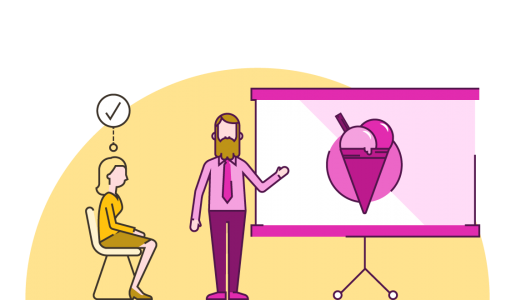
We’ve been thinking about training this week, in particular the really boring training slides we’ve all come across during our corporate careers. We’ve decided to fight back and try to help participants to actually learn something. So, calling all facilitators, trainers, and training content creators, please take note of our 12 training presentation ideas!
Slides aren’t for decoration
Many presenters realise that their slides shouldn’t contain walls of text. But, unable to successfully visualise the information that they want to help convey, they replace the text with pictures that are only tangentially (or metaphorically) related to their training presentation content. The problem? These visuals don’t really help learners to understand or remember the training material.
So – don’t decorate – illustrate. Find images, diagrams, photos, graphs, or sketches that actually help learners to learn.
Animation helps explanation
Because so much PowerPoint animation is done badly, some so-called experts have had the daft idea that you shouldn’t use animation because it’s distracting. That’s like saying that you shouldn’t listen to music because Justin Bieber exists. Done well, animation is wonderful for explaining how things work – showing the parts moving around, processes in full flow, things growing and shrinking and colliding.
Think of the animations that help explain ideas in the TV news or documentaries. That’s what slides can do with the help of clever visualisation and relevant animation. ( Here’s a nice example if you want some more proof.)
And you’re just seven steps away to your first PowerPoint animation ninja belt .
Bullet points don’t work. Honestly.
Text slides do have a place in training presentations. To show quotes, for agendas and timetables, or for material such as definitions where the exact wording matters, and you need the audience to just read quietly for a bit.
But in general bullet points don’t work. Your audience can read, but they can’t read and listen to you talk at the same time. So, if you want participants to listen to you, don’t compete with slides they can read more quickly than you can read out loud.
Have enough slides
A lot of presenters are scared of having too many slides. This makes sense when slides contain big blocks of text – the fewer of these the better! But, if your slides actually help bring your training to life, and illustrate your learning objectives, you need the right number – not just as few as possible. If nothing changes on screen for half an hour while you cover a huge amount of content, your learners will benefit from seeing additional slides.
Use a slide every time you think it will help you to explain the points you are making.
Use a variety of visual aids
There are plenty of visual aids that can help with a training presentation. Obviously good old-fashioned whiteboards can work well. So can videos. So can physical objects used as props.
‘Show and Tell’ at school worked as well or better than a typical training presentation. Why was that? Harness that energy and you’ll be more successful.
Pay attention to design. Your audience will.
It’s amazing how many important training presentations look like they were designed by somebody showing off the two things they learned from a copy of PowerPoint 1995 for Beginners. Ugly text. Ugly graphics. Too much text. Inconsistent layout. No white space. The sort of presentation that says “we didn’t really try” but still gets used for onboarding all new staff, or at training sessions with senior management. It’s embarrassing.
People notice design – consciously or sub-consciously. If you want to give the right impression, and if your training presentation is going to be used in a way that warrants the expense, it’s a really good idea to involve a professional presentation designer. (At the very worst, use these three hacks – every time.)
Harness the power of stories
When I studied for my MBA (years ago, partly worth it, partly not) our strategy lecturer was full of great ‘war stories’. The most memorable lesson we had involved viewing interviews with the leadership of a small fast-growing food technology company, talking about how they planned to grow. The same team had been interviewed every few months. The company was aggressive about expansion and had spent a lot of money developing its product – it was hard to know how the story would end. The lecturer kept stopping the tape, and we discussed what was happening, and what should have been happening. We really didn’t know how things would end.
I studied 100s of companies as part of my MBA. Most I’ve forgotten. I remember that that one ran out of cash and stopped trading days before a large order came in (which they couldn’t take).
The right stories – told with enough detail, and where there’s genuine uncertainty and interest about what will happen – can make your training come to life.
Change pace
Given how obvious it is that training presentations that go on-and-on-and-on-and-on without any sort of change of pace can be tedious, it’s surprising how many people do them that way anyway. Is it because they haven’t got any better ideas? Or because that’s the way others do it? Perhaps.
Break up your training presentations with exercises, discussions, quizzes, videos, props, whiteboarding – anything to vary the pace and ensure variety for your audience.
Don’t use slides as handouts
There’s often an expectation that a trainer delivering a training presentation will also provide a handout. The idea is that a handout serves as a real reminder of what happened, so that participants can benefit ‘long term’ from training. The problem? If slides work as handouts they must be pretty much self-explanatory. If slides are self-explanatory, the trainer will just be ignored while trying to present them – the audience will read instead.
So, by all means provide a handout if you want to – but don’t ever just use the same slides to present and to print as a handout.
Turn your training presentation into eLearning
Using a tool such as Articulate Storyline, iSpring, or indeed using PowerPoint itself, you can easily record a narrated version of your training presentation slides. In this way, your slides can work as training follow-up, or even as an alternative eLearning version of your training.
Once you’ve put in the hard work of creating effective slides, spend a bit of additional time creating a valuable resource for on-demand training on online follow-up material, by recording narration and adding interactivity.
Does interactivity sound like a dark art – it’s actually pretty simple to do in PowerPoint .
Don’t read aloud
When you do need your audience to read slides, don’t compete with them. If they are reading, they can’t listen to you. If they are listening to you, they can’t read.
If you need the audience to read something, explain what you are going to show them and why it matters, put it up on screen, and shut up while you read it to yourself. Then when you see the audience are ready, continue presenting.
Find a presentation skills coach
If you are a trainer or facilitator, you should already be reasonably comfortable with presenting, understand the need to practice, and know that you need to learn your material. If you want to take things to the next level though, find someone – a peer, a professional, or a video camera and your own insight – to critique your presentation delivery.
Eliminate verbal fillers, think about language and phrasing, and work on how you interact with your slides. It’s hard to notice when presenting, but there’s always room for improvement.

Related articles
How to make the ultimate sales presentation.
- Sales presentations / Sales messaging / Visual communication
- Comments: 8
Sales presentations are the cornerstone of many companies’ sales efforts, yet so often they aren’t given the time and attention they deserve. Thrown together at the last-minute, often your sales reps stand up in front of a sales presentation that's nothing more than a glorified page of notes. Read this article for everything you need to make the ultimate sales presentation.

Choosing a presentation design agency
- PowerPoint design / Visual communication / Industry insights
- Comments: 2
Choosing a presentation design agency for your enterprise is a lot harder than buying a product. With presentation design services, you don’t know what you’re going to get until the project is nearly finished. What you get from the studio isn’t the exact same thing as what any other business ends up with. So how do you choose the right presentation design firm for your company?
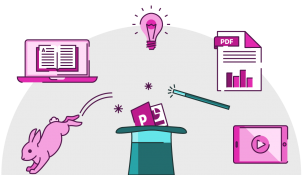
We told you what to do…so why are so many presentations still crap?
- Visual communication / Industry insights
Presentation Zen was published ten years ago. Al Gore won his Oscar for a film based on a presentation in 2006. Amazon sell more than 38,000 books with ‘presentation’ in the title, and more than 7,500 with ‘PowerPoint’. Which all sort or raises the question Why are so many presentations still crap? All those books, decks, all that advice – Is it even making a difference?
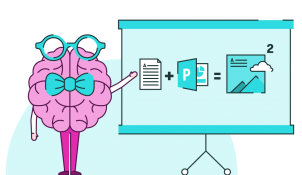
Lot of good points have been discussed in this post. I do agree with them. I have attended and given many presentation and training. I came up with Following article on effective training and presentation as per my experience. Would appreciate the feedback.
http://www.scmtechblog.net/2016/02/how-to-provide-effective.html
firstly thank you for this tips, all management student is learning related effective presentation skills and best perform presentation at the time.
While these tips are good, I felt mislead by the article’s title as I was looking for subjects to talk about, not helpful advise on how to present.
I agree, Mary. The information is useful, though the title is misleading. I was looking for an article about good topics to present during a mock training (part of a job interview). What is presented in this article is not a list of training presentation “ideas”, but rather training presentation “tips”. The tips are very useful, so I thank the writer for that.
Mary, wouldn’t that just completely depend on what you wanted your training to be about? Given how different e.g. massage, fluid dynamics, and brain surgery are, it’s hard to give general ideas on what training presentations should be about. But I’m glad you liked the presentation tips at least.
This information was very helpful. I will use the tips going forward when presenting. thank you
Very useful. There are some critical points that I can use to develop my training skills.
So interesting! Thanks a lot.
Thank you for the positive points. Easy to implement and benifical to audience. I’ll be back!
Great information. This article was very helpful. Especially the section on utilizing elearning tools.
In the training my company offers, we supply all the delegates with a pack showing the whole presentation on the left of each page with space for their own notes on the right. I know this is very common practice. However, as a presenter I’m always a bit confused by the fact that my animation is wasted as delegates can see all I’m holding back. Similarly, there’s no point asking questions because the answers are visible to them. And so on. So, if the presentation is right, what’s the right format for delegates’ notes, please?
Madeleine what you describe is very typical, but it’s also ineffective. Handouts should support a presenter, not undermine both the presenter and the slide. Why would I listen if I can read ahead on the handout (given that I can’t read and listen at the same time)?
Consider accessing this resource on handouts . But for those who just want a quick summary (i) consider providing slides only after the presentation (ii) consider a video/recording of the slides being delivered, not just a static snapshot (depending on the slides) (iii) let people take their own notes – they can always make note of slide numbers and refer back if you tell people you’ll provide slides after (iv) if you want to provide something for note taking, make it something custom-designed, that aids learning/understanding when learners fill in the gaps.
Still i am tensed up to start my training session for my colleague teachers…
Leave a Reply Cancel reply
Save my name and email in this browser for the next time I comment.
Join the BrightCarbon mailing list for monthly invites and resources
I wanted to make sure I send you both a HUGE thank you for making this story come to life and creating amazing graphics to help. We really appreciate BrightCarbon for stepping up our presentation game massively! Sarah Walker Softchoice


You can only compare three courses at once. Please remove one to proceed
How to Put Together an Effective Training Presentation
Master the art of crafting powerful training presentations with proven tips and techniques. Learn to engage, educate, and inspire your audience for training success!
- Professional Skills

This is a guest article from Presentation Experts
Planning and executing a training presentation isn’t a simple feat. The best training sessions require experienced trainers, support from management, and impactful instruction methods.
Having put together coaching programs on presentation skills training , the Presentation Experts in London have several years of experience running training sessions. Whether you’re organizing a public speaking seminar or another form of skills training, here are our five top tips for putting together an impressive training presentation.
Clearly Articulate Your Training Goals
Before you even begin planning the training day, you should identify your goals. You’ll likely be working with another trainer and with management from the company you’re training at. Sit down with this team and go over what’s expected from your instruction. Aim to make your goals as specific and concrete as possible, too. If you’re running a public speaking course, then one of your goals could be having each person in the course give a two-minute presentation at the end.
Without a clear direction – and without all the planners on the same page – your training will fall flat. If attendees to your session don’t understand exactly what they’re supposed to get from this session, they will be significantly less engaged.
Find your next course
Corporate trainer certification, corporate trainer certification (corporate), 4-day train-the-trainer classroom course package, hazwoper train-the-trainer (httt) - online, hazwoper train-the-trainer, hydrogen sulfide safety: train-the-trainer (h2s), the facilitative trainer - public enrollment, confined space entry & rescue train-the-trainer, training the trainer (on-site), make your training memorable.
When planning your training presentation, focus on making it memorable. At the Presentation Experts, we coach our trainees on making compelling business presentations . Your training session should be no different! Nobody who attends your session will learn anything if they forget about it within a few days.
Make the course fun for trainees by changing methods throughout the session. Will anyone retain anything if you speak behind a podium with a PowerPoint for 3 hours? Of course not. Break up the session into smaller chunks, focusing on different activities and learning styles. Not everyone absorbs information in the same way, so by switching up the format of the session, you’re likely to reach more people.
How to Deliver Presentations with Ease and Confidence
Advanced presentation skills, advanced presentation skills (corporate training), presenting with impact, powerful presentation skills, free webinar: power to wow techniques for successful presentations, dynamic presentation skills, dynamic public speaking with scope, effective communication and inspirational presentations, help trainees build self-esteem.
During the course, you should focus on building your participants’ self-esteem. They’re here to learn new skills, which means they’ve likely identified a weakness in themselves. As a result, they may not have much confidence to start off with.
Be encouraging throughout your training session, letting the trainees know that you’re there to support their learning. Ask people to participate in the activities you have lined up, the best way to build self-esteem.
Don’t force people to do something they really don’t want to, but gentle nudges outside their comfort zone will help your attendees recognize their own potential. When their self-confidence goes up, your trainees will want to implement the skills they learned outside of the training presentation.
Building Your Self Esteem and Assertiveness Skills
Being assertive with emotional intelligence, being assertive with emotional intelligence (corporate), self-expression, self-expression (corporate), next factor — executive presence, free webinar: responding productively to microaggressions at work, exercising influence building relationships and getting results - in house, making meetings work - in house, use the perfect powerpoint.
A well-made PowerPoint can make or break your presentation. For a training session, use it to enhance your instructional activities. For optimal results, create an outline of your session before touching a single slide. You want your message to be clear before designing your PowerPoint template . You should also aim to keep it simple, with few or no animations, three to five bullets per slide, and one to two graphics per slide.
For an hour long presentation, about 20 to 30 slides are best. You can adjust the number based on the duration of your training session. To make your presentation stand out even more, you can consider using a Text-to-Image AI generator to create custom visuals for your slides. Always check your PowerPoint on your own computer first, looking for technical glitches. And don’t forget to rehearse your presentation with your slides, finding the best position for yourself to address your audience.
Microsoft® Excel to PowerPoint
Microsoft® office powerpoint boot camp, microsoft® excel to powerpoint (corporate), microsoft® office powerpoint boot camp (corporate), the pixar pitch: new approaches to storytelling and the use of powerpoint, effective flowcharting and process design using microsoft® visio professional, microsoft® office powerpoint fundamentals, effective flowcharting and process design using microsoft® visio professional (corporate), microsoft® office powerpoint fundamentals (corporate), give handouts.
Informational handouts can be a great way to help trainees retain the skills they’ve learned. Just like with PowerPoints, though, there’s a right way and a wrong way to do handouts. Firstly, make sure handouts are appropriate for your training topic. You don’t want to distribute materials that have no value for your trainees.
You should also make your handouts look as professional as possible, by printing on high-quality paper with full color (if you have the budget). Use headings and large type that’s easy to read, along with bullet points and graphics to illustrate. Leave enough white space on your handout so it doesn’t feel overstuffed with information. Ultimately, you want your handouts to be easy to read and quick to digest.
Final Thoughts on Putting Together an Effective Training Presentation
Keep these five top tips in mind for the next instructional session you plan. Whether it’s for your own company or you’re hired as a trainer for an external organization, these tips will be relevant for you. As a presentation agency in London, the Presentation Experts have been coaching organizations on presentation skills for several years.
We always incorporate these steps into each of our sessions, aiming to provide the best training experience possible. And if you stick to these tips, you can design a compelling training presentation too.
Looking for more ways to level up your training skills?
We list 100+ train the trainer courses from expert training providers . Get all of the skills you need to deliver impactful training online or in-person
Search train the trainer courses
You might also be interested in:
How to get promoted in 5 easy steps.
Think you are ready for a promotion? These five steps apply across roles and industries and will help you get where you're going. Read the article to learn more.
5 Top Soft Skills to Future-Proof any Career
Studies show soft skills are increasingly important in the changing world of work. Invest in top soft skills training to future-proof your career. Read on to find out more.
Top 5 Skills for Mid-Level Professionals
Whether you’re a knowledge worker or you're hiring mid-level professionals, you’ll need to know the skills that are most important for mid-level professionals!
8 Popular Computer Skills Courses to Help Your Career in 2023
In the modern workplace, it's essential to evolve your computer skills to grow your career. Here are 8 courses to get you started.
15 Training Presentation Topics to Upskill Your Team

Training employees is essential for company growth. It’s not a secret that skilled workers bring in the most value to the business and constant training is key in the development of these talents. But which are the best training presentation topics for your team? And how to deliver them efficiently in your corporate e-learning program?
At 24Slides, we design thousands of decks for companies worldwide so, I’ve put together 15 of our most popular presentation topics for employee training and development. Plus, you’ll find amazing training presentation designs you can draw inspiration from.
How to Make the Best Use of Presentations for Online Employee Training?
Presentations are no longer a synonym of dull text blocks on a white background. Nowadays, you can create a wholly immersive experience with your slides and that’s what makes them one of your most powerful tools for corporate training. Before we dive into our presentation topics, let me show you some ways you can leverage PowerPoint for eLearning :
- A good design enhances your team’s learning
When doing remote training, it’s common to stuff your slides. After all, you won’t be there to deliver your speech and employees need to have everything on display. But, who wants to read overloaded PowerPoints? To avoid a tedious learning experience, use the power of design to guide your participants . You can incorporate icons next to relevant ideas, use a harmonic color palette so your texts don’t blend with your backgrounds, or add headlines to build content hierarchy. Here are some examples:
- Multimedia elements to boost engagement
PowerPoint allows inserting everything from images and videos to animations and audio into one presentation. And these last two elements have grown in popularity for eLearning. For instance, animations and transitions make your training presentation less rigid and add up to their flow. Regarding audio, voice narrations work as the perfect complement to remote training. However, if you’re going to use an LMS (Learning Management System), I recommend that you first double-check that it lets you import PowerPoint animations, audio, and other special effects.
- Templates for brand alignment
You probably give multiple workshops for your employee training and development program. This means you have to create a presentation for every session - which, according to our survey, takes an average of 4 hours a week . And chances are you’re not the only specialist who gives training in the company. Then, how to make this process go smoothly for everyone? A library of branded presentation templates can be your answer. Companies all over the world already use template libraries to take away the tiring task of making PowerPoints from scratch. This assures all your business presentations stay on brand - every single time!

- Shareable resources
Surprisingly, few people know that PowerPoint allows exporting one’s slides as JPG images, PDF files, and even MP4 videos. This opens up a whole range of possibilities for the additional material you can offer to your participants . For instance, you can easily create a PDF guide for a complex process you mentioned in your presentation. Or what about making a short training and development video? You can add some transitions to your slides and export them as a video . All these extra materials you create help employees interact with your key topics and make them memorable long after the training is over.
As you can see, presentations go hand in hand with effective corporate eLearning, but how much you can really cover in them? Keep scrolling to find superb training presentation topics.
Constant training offers numerous benefits to the business such as improved employee advocacy, increased team productivity, and job satisfaction - just to name a few. So, go beyond the traditional onboarding and get ready to upskill your team all year long. Here I’ve compiled 15 presentation topics you can employ for employee training and development:
1.- Time Management and Productivity
2.- Leadership Development for Young Professionals
3.- Women in Leadership
4.- OKR Goal Setting
5.- Communication in Remote Teams
6.- Keeping a Healthy Work-Life Balance
7.- Employee Mental Health
8.- First Aid Training
9.- Construction Safety
10.- Diversity and Inclusion in the Workplace
11.- Corporate Sustainability
12.- Digital Transformation
13.- Data Security Awareness
14.- Customer Service
15.- Product Onboarding
Check them out in detail below! I’ve grouped them into 6 business areas and included popular training presentation templates by 24Slides - in case you want some inspiration.
Employee Development
Time management , for example, is something that everyone in the company can benefit from - independently of their role. From the time-blocking method to the Impact Effort Matrix , there are countless techniques and tools you can share in a time management and productivity training program.
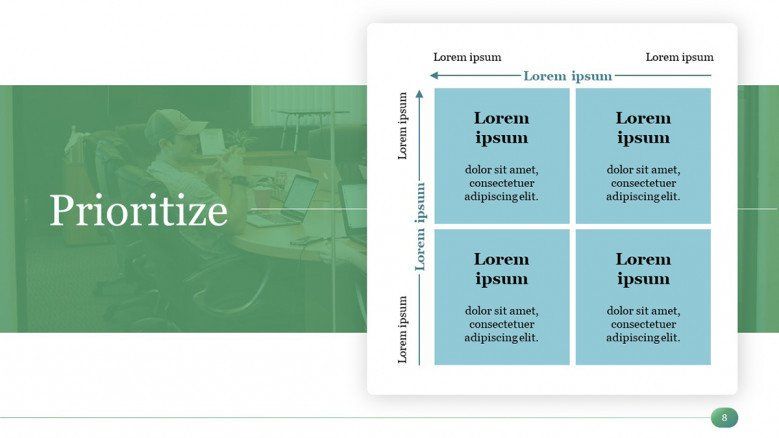
Leadership is key for professional growth but it encompasses a long trail of skills that takes time to master. This means potential leaders are likely to have different training needs depending on which stage they’re at. To work this out, give a fresh twist to the worn-out leadership topic by focusing on your team’s profiles. Talk about leadership development for trainees or leadership skills for executives . You can also address the gender gap in business and provide training for women leadership .

With the rise of remote work , we all need to develop and strengthen our digital skills. This adds up engaging and current topics on which to train employees. For example, effective communication in digital environments , goal-setting for remote teams , online collaboration tools , and more.

Employee Health and Well-Being
Another way to empower your team is to encourage good work-life balance practices. And employee well-being programs are great to help your team cope with stress and do something about it. For instance, how to keep a healthy diet or an active sports life are topics for training and development that your employees would appreciate.

But employee well-being doesn’t only involve the physical aspect. Mental health is also key for a rewarding life. So, address mental health in the workplace and talk about how the company can provide the team support if they ever need it.

Team Safety
A safe workplace is a company’s responsibility to its employees. But when it comes to the industrial engineering sector, team safety takes on a whole new level. If your team works in construction, electrical installations, or excavations, a safety orientation is not enough. The company must carry out constant training on the best safety practices , proper equipment usage, and even evacuation plans .

Another training presentation idea every business should implement is first aid . This is the type of training one hopes to never use, but it’s a must to be prepared. Tell your team how to react in case of an emergency in the office and how to assist colleagues until medical help arrives.

Corporate Social Responsibility
Socially responsible companies use the power of business to do good and part of this is integrating social and environmental concerns into their practices. As one of the main company’s stakeholders, employees should be aware of how their work and actions contribute to the business’ CSR goals . Along the way, they’ll also learn how to be more socially responsible citizens in their communities.
Corporate social responsibility encourages inspiring and engaging training for employees. For instance, you can launch a recycling program and motivate your team to go green. Another fitting training and development presentation topic for CSR could be diversity and inclusion in the workplace .

In the digital era, personal data has become the new oil and consumers demand businesses to be transparent in how they collect and handle their information. But it goes further than that, customers also want companies to up their efforts for keeping their data safe and secure . And as you can imagine, employee training is key in this process.
Security awareness training could be a good start to help your team understand their role in protecting the company and customers’ data.
Digital transformation also requires employees to be trained on cloud computing and technologies to perform at their highest level.
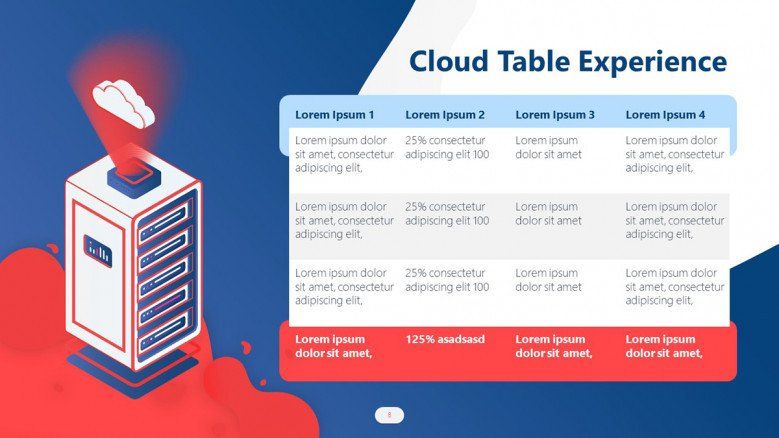
Sometimes organizations put all their attention on product onboarding for customers but leave out one of the most important people who need to get that experience: Employees! Especially the teams that work directly selling it or talking about it.
So, before launching new products, make sure to power everyone from marketing and sales to customer service and customer success with product knowledge training .
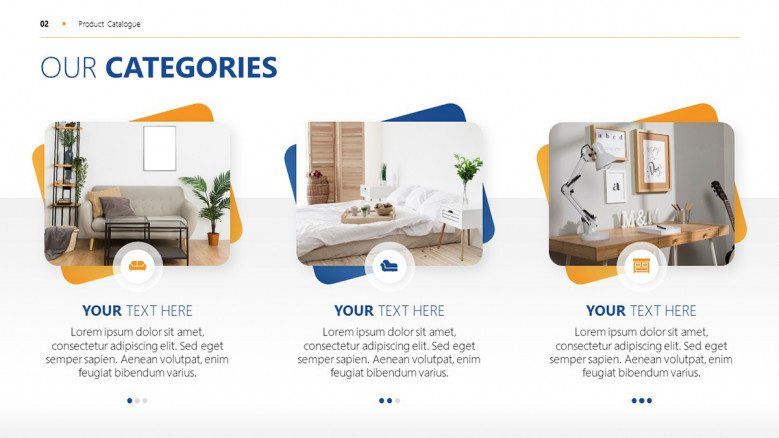
Level Up your Corporate Training with Custom Presentations!
After going through these presentation ideas for employee training, I’m sure you already caught an exciting topic to work on.
If you liked any of the slides in this article, click on them for a free download. You still need to do some editing but they’ll save you hours of layering shapes on PowerPoint.
But if you need a training presentation on-brand that TRULY captivates your audience, you might want to learn about 24Slides’ presentation design services . We help businesses all around the world elevate the impact of their corporate presentations. Plus, our designers are experts in presentation design and branding so rest assured you’ll get the professional slides your training deserves .

Create professional presentations online
Other people also read

How To Write Effective Emails That Will Improve Your Communi...

How to Make a Marketing Plan Presentation in PowerPoint

Alternative presentation styles: Takahashi

Training Industry
Has powerpoint become a pain point deliver more engaging training sessions with these tips.

How many post-workshop evaluations have mentioned the highlight of the day being the beautiful and engaging PowerPoint presentation?
Do you think that’s ever been the case for any presentation you’ve given or sat through?
Chances are that instead, the mere thought of an afternoon training session featuring slide 77 flicking to slide 78 sends shivers down the spines of most attendees. When delivering a training workshop, you are the primary visual aid and it’s up to you to add enthusiasm, energy, expertise and interaction to your session. Even experienced trainers can still struggle to use PowerPoint in a way that enhances their facilitation skills.
There are plenty of great alternatives to PowerPoint, but it’s still a reliable workhorse and if you are using it, it pays to be aware of some of the quick and easy techniques available to you.
This article will share three common challenges trainers face with their presentations , and what you can do to overcome them without having to be a PowerPoint expert.
Challenge 1: Too Many Slides
What’s the magic number of slides to use in a training session … who knows? There’s no definitive answer to that. That makes addressing this first challenge a little trickier.
When you have extended workshops, there might be a volume of content to work through, and the linear nature of slides makes it very hard to keep attendees engaged throughout.
Prezi is seen as an attractive alternative to PowerPoint because its zooming canvas allows you to travel through content in a non-linear way. The idea of seeing an agenda, zooming in to reveal the content, and then zooming back out helps chunk content into groups and supports effective delivery.
Did you know that this can be done in a very simple way in PowerPoint as well?
Your training session can likely be broken down into key sections or learning objectives that set the agenda for your session. These will be the agenda items that set the structure for your presentation.
Then follow these four steps:
- At the start of each agenda item, insert a clear divider slide.
- View your PowerPoint in slide sorter mode.
- Create a section for the collection of each slide.
- Go to Insert > Summary Zoom.
What you will see is a new slide that gives a snapshot of the first slide in each section (that’s why we’ve used dividers). If you have the time, you can then adjust or replace these snapshots and create a visually appealing overview of your presentation. Then try it out in present mode: By clicking forward, you will travel through into each section and then return to this overview screen. It’s also interactive, as simply clicking on an image will take you to that section.
It’s very simple to do, has a huge impact and overcomes that feeling of being overwhelmed by content.
Challenge 2: Not Enough Space on One Slide
Not all ideas fit onto one slide, especially with diagrams, complex ideas or extended focus areas. But a choppy transition leaping from one slide to the next can interrupt the flow of learning. Using a push transition is a very simple way to overcome this and join slides together to give a feeling of continuity.
- For instance, if you have a timeline that doesn’t fit onto one slide, put it across two slides.
- On the second slide, add a push transition, then adjust so it pushes in from the right.
- Go into present mode and review what that looks like.
You can then start exploring more advanced uses for these transitions. For example, you might ‘dive into’ further exploration of a topic with a push down or push from the left to “go back” to a previously visited idea.
Push transitions, when done well, are simple, look great, and can give you more space to work with.
Challenge 3: Too Much Text
This comes in third here but is often the most visible challenge. When people struggle with this, they really struggle! If you’ve got whole sentences or paragraphs on your slides, that means you are using them as your speaking notes and not as a visual aid.
If you are facilitating a training session , you should have a good working knowledge of your subject. You shouldn’t need slides with full sentences on them.
Turn those sentences into speaking prompts that then give you the space to connect with your audience, instead of having them read from the screen as you present.
- Find any slides full of bullet points or sentences.
- Examine each point and distill it down into 2-5 keywords.
- Go to insert > icon and find a relevant icon that matches the point being made.
- Insert the icon above or next to each set of keywords, and then align them.
This is another quick and simple improvement that can immediately lift the effectiveness of your presentations.
Three common challenges and three simple techniques.
With each one being so easy, you have nothing to lose by trying them out the next time you present. And you might just enjoy the extra impact they help you to deliver.
- #engaging learning sessions
- #facilitation skills for trainers
- #how to engage your learners
- #training facilitation
- #training presentations

Kris Flegg is a certified Platinum Prezi Expert and a director of Presentation Design Co. Along with his team, he has worked to construct and design thousands of presentations for clients such as Toyota, Coca-Cola, Qantas and the Australian Government since 2012. Kris has personally conducted face-to-face workshops for over 3,500 people and has led the development and design of high-stakes presentations; he is also the author of “ The Presentation Playbook ”.
This topic is proudly sponsored by

Related Content
From learning leader to solopreneur: your guide to becoming an independent consultant, empower yourself and excel in your corporate training career, storytelling: a powerful tool for learner engagement and retention.
Stay up to date on the latest articles, webinars and resources for learning and development.
Privacy Overview
These cookies are required for the website to run and cannot be switched off. Such cookies are only set in response to actions made by you such as language, currency, login session, privacy preferences. You can set your browser to block these cookies but this might affect the way our site is working.
These cookies are usually set by our marketing and advertising partners. They may be used by them to build a profile of your interest and later show you relevant ads. If you do not allow these cookies you will not experience targeted ads for your interests.
These cookies enable our website to offer additional functions and personal settings. They can be set by us or by third-party service providers that we have placed on our pages. If you do not allow these cookies, these services may not work properly.
These cookies allow us to measure visitors traffic and see traffic sources by collecting information in data sets. They also help us understand which products and actions are more popular than others.
Training Presentation Example
Are you training a team of new recruits to your company? Or delivering a webinar on a topic in your industry? To pull off a training session, webinar, or coaching session effectively, you’ll need an organized presentation as a visual aid.
A good training presentation can provide structure to your speech and boost your confidence as a presenter. It can also deliver your message efficiently, and stick with your audience long after your presentation is over.
Use our training presentation template to:
- Present information simply and logically
- Help you stay focused on your speech
- Motivate, inspire, or inform your audience
Customize Your Training Presentation Template
Structuring your training presentation properly and including the right slides are both important. Illustrate your points by using graphics like bullet lists, pictographs, bar charts, images, and more. Each of these options can be added to your training presentation template in an instant. We reviewed the best training presentation examples and here are the recommended slides to include:

Pro Tips for Creating Your Training Presentation
Here are tips from our favorite training presentation examples.
Does your presentation inform, inspire, persuade, or entertain? Tailor your speech according to your goals.
Make sure you add an introduction in the beginning of your presentation. Explain why you’re speaking on the topic to build your audience’s confidence and trust.
Will your audience want to listen to your speech, or engage with it through questions and stories? Are they completely new to the presentation topic or will they be experts?
Before your training or webinar ends, leave your audience with a summary of your main message.
More Popular Templates
.webp)
Linkedin Pitch Deck
LinkedIn is the world's largest professional network with over 800 million members in more than 200 countries and territories worldwide. We took a look at LinkedIn’s original pitch deck to look for ways to improve the design.

Dropbox Pitch Deck
You’ve likely used DropBox for saving and sharing files, but 13 years ago MIT students Drew Houston and Arash Ferdowsi were just hoping for a little funding to get their start-up off the ground. The initial pitch deck landed them their $1.2M seed round in 2007, though it left room for improvement. We recreated it in Beautiful.ai.

Sales Proposal
Influence your audience into action and make the impact you’ve always wanted in way less time. Let our sales proposal templates guide you every step of the way.

Trade Show Presentation Template
Learn how Beautiful.ai’s trade show presentation template can help teams take their exhibit to the next level and grab the attention of attendees.

Coinbase Pitch Deck
The popular cryptocurrency platform Coinbase has been drawing the attention of a larger audience recently so we’ve reimagined their presentation deck to help that growing audience better understand the company.

Webinar Recap Presentation Template
Learn how Beautiful.ai’s webinar recap presentation template can act as a follow up for your audience to expand your reach after the webinar.

Unsupported browser
This site was designed for modern browsers and tested with Internet Explorer version 10 and later.
It may not look or work correctly on your browser.
How to Make Training PowerPoint Presentations With Templates (+Tips)
Are you getting ready to create a training PowerPoint? Learn how to create a training presentation quickly. Plus, we'll share training and development presentation ideas.

When you are creating your training presentation , you want a presentation that stands out and looks professional. The best way to do that is to use a premium training PowerPoint template . Premium eLearning PowerPoint templates not only look professional and stand out, but they can save you time from creating a template from scratch.
In this article, you’ll be shown how to customize any premium training PowerPoint template that you choose. You’ll also see some slide suggestions to give you ideas for your training presentation. This article also includes training presentation tips.
What to Include in Your Training eLearning PPT Presentation
Before we get into the step-by-step instructions for creating a training PowerPoint, let's look at what should go into your presentation.
When creating a training presentation , you may wonder what slides should be included. Maybe you just need inspiration. Here are five slides you may want for your eLearning presentation:
1. Quiz Slide

2. Training Videos
If you're giving training presentation tips in your presentation, consider showing a video of the tips instead. Videos can be more engaging for the audience, which will cause them to pay attention to the video. The video could be a video that you created or a video that's already made. When you’re adding a video, make sure that it is of high quality.
3. Goals Slide

Before getting to the main point of your training PowerPoint presentation, lay out your goals for the audience. This can help them understand why you’re giving your presentation. This will let the audience know the purpose of the presentation and what you’re trying to do.
4. Problem Slide
If you’re giving your training presentation to address a problem within your company, you need this slide. Tell your audience what the problem is and why it's a problem. Thoroughly going over the problem situation allows people to recognize the problem when they come across it.
5. Solution Slide

Once you've presented your problem to your audience, you need to give a solution. If a person can recognize the problem and knows the solution, they’ll then be able to fix the problem.
When giving the solution in your training PowerPoint, try to provide a step-by-step solution for the problem. You want it to be easy for people to follow, otherwise they won’t remember the solution.
How to Customize the Design of Your Premium Template Quickly
Customizing your template is important. Here are ten optional customizations that you can do for your eLearning PowerPoint template. In this tutorial, we’ll use the premium template, Graduate – Education PowerPoint Presentation .

Let's get started:
1. Choose Your Slides

Begin by opening your eLearning PowerPoint template. Next, click on the View tab. In the toolbar underneath the tabs, click on the Slide Sorter button.
When you click on the Slide Sorter button, you’ll see all the slides that your template comes with. If you see slides that you don’t want, right-click on the slide, and choose the Delete option from the menu that pops up.
Once you’re done selecting slides, click on Normal view in the toolbar.
2. Add Your Content
Go to the first slide that you want to add your information to. For the next couple slides, we’ll use slide 3. Here's what slide 3 looks like with no edits made:

To start, click on the Home tab. To add information, highlight the text you want to remove on the slide. Next, Delete on your keyboard. Now, type or paste your information into the text box.

3. Change the Font

Changing the font is easy. Begin by highlighting the text that you want to change the font of. Next, go to the Font menu in the toolbar and select the font that you want on your slide.
Repeat these steps for every slide so that you're consistent throughout your presentation.
4. Change the Font Color

Another way to customize your slide is to change the font color.
To begin changing the color of the font, highlight the font that you want to change the color of. Then, click on the arrow next to the Font Color button in your toolbar. A menu will drop down with colors. Click on the color that you want your font to be.
Repeat this process throughout your template everywhere you want to change the font color.
5. Change the Font Size

Font size is important because you want to make sure that even the audience member in the back of the room can read everything on your slide. For that to happen, you may need to change the font that the template comes in.
To change font size, highlight the text that you want to change the size of the font of. The menu to change the font is in the toolbar. Choose what size font you want from the drop-down.
Repeat these steps for every slide in your training presentation so that you have consistency.
6. Change the Background Color

If you don’t like the background color of a slide you can change it.
To change the background color of your slide, click on the Design tab. Then, in the toolbar under the Design tab, click on the Format Background button. A Format Background side panel pops up on the right side of your screen. Click on the Fill Color button and choose a new background color.
7. Add Images

Images can be a great tool that you can use in your presentation to engage the audience. There are two separate ways that you can add an image to your slide.
- If your slide has a picture placeholder like slide two of the Graduate – Education PowerPoint Presentation has, use the picture placeholder as a guide. You the Insert tab in the toolbar to add a picture and position it where the placeholder is. Resize the image as needed.
- You can also place an image anywhere on the slide. Click on the Insert tab. In the toolbar, click on the Insert Picture button. Select your location of your image from the drop-down menu. Then, double click on the image and resize the image as needed.
8. Delete an Object

Sometimes objects are in the way or unwanted. When that happens, you can delete the object.
Begin by selecting the object that you want to get rid of. Once the object is selected, just tap Delete on your keyboard.
9. Change an Object's Color

If you changed the color scheme of your presentation, you may want to change the color of the objects on the slide to match the new color scheme.
Start by selecting the object that you want to change. Once the object is selected, click on the Shape Format tab. When you click on the Shape Format tab, a side panel appears on the right side of your screen. In that panel, click on the Color button.
10. Add Animation

Adding a little animation when you change learning presentation slides can make your presentation more interesting for the audience.
To add the transition animations, click on the Transitions tab. In the toolbar under the Transitions tab there's a list of transitions that you can use. Click on the one that you want.
The Best eLearning Presentation Templates on Envato Elements
Envato Elements is a subscription service where you pay a low monthly fee to get an unlimited number of design assets. Once you become a member, you get access to:
- eLearning presentation templates
- audio files
- video files
- and other digital assets

Using templates is a sure way to impress your audience. Every template on Envato Elements is made by professional. So, after you’ve downloaded a template, just fill in your information and make any customizations, and you’re done!
If you only need a single e-learning presentation template, don't worry. You can order professional premium training PowerPoint templates one at a time from GraphicRiver.
Five Top eLearning Presentation Templates From Envato Elements
Are you curious about what training PPT templates are available? Here's a curated list of five premium eLearning Presentation templates:
1. Elearn- Presentation Template

Elearn is a training presentation with a modern design. This template comes with 36 unique slides in 16:9 size. Easily add an image by dragging and dropping the image of your choice into the picture placeholder. Everything in this template is completely editable.
2. eLearning Education PowerPoint Template

eLearning Education PowerPoint Template has a minimal design. Here are some highlights of this template:
- 150 total slides
- 5 color schemes
- picture placeholders
- device mockups and illustrations
Everything in this template is completely editable.
3. E-Learning PowerPoint Presentation Template

E-Learning PowerPoint Presentation Template is made for people who want to give a training PowerPoint. This template comes with 30 unique slides and ten premade color schemes for you to choose from. Easily add an image to your presentation by dragging and dropping the image of your choice into the picture placeholder.
4. Educally

Educally eLearning presentation template is multipurpose education template with a modern design. Here are some highlights of this template:
- 40 unique slides
- picture placeholder
Everything in this template can be easily edited.
5. MWNL PowerPoint Template

MWNL is a training PowerPoint presentation with a modern design. This template comes with 30 unique slides. The MWNL training PowerPoint presentation comes with graphics that can be resized and edited.
Tips on Creating an eLearning Presentation
Creating a training presentation can be a big task. But there are a few ways to make it easier. When you’re making your eLearning, presentation remember these tips:
1. Plan Ahead
When you’re making your training presentation, planning is vital. When planning, remember these three steps:
- Outline your presentation in advance. This helps you make sure that your slides are in an order that make sense.
- Plan out what information you want on each slide. This helps you make sure that you don’t leave any information out.
- Decide hat visuals you want in your presentation.
This tutorial has more information on how to write a PowerPoint presentation.

2. Focus on Your Goals
When you’re making training PowerPoint and putting together your slides, keep your main goal in mind. You want every slide to go back to the main point of your presentation. Even your graphics to bring back to your main point.
When a presentation is scattered and not clear on the main point, it can seem sloppy and unprofessional.
3. Be Concise
When you're adding text to your training PowerPoint presentation, be concise. with too much text to your slide can seem unprofessional.
Your slides should be used to emphasize important points that you’re talking about. Learn more in this tutorial:

4. Be Consistent
Consistency is key for an eLearning presentation. Every slide should have the same font. The color scheme should be the same throughout the presentation.
When your presentation is consistent, it looks professionally done. It's also less distracting for the audience.
One way to be consistent throughout your eLearning present is using by using a training PowerPoint template. It already comes with a color scheme.
5. Include Video or Audio
If you want your training PowerPoint presentation to be more engaging for the audience, then include high-quality video and audio.
For example, you could add narration to your slides or background music to make your training PowerPoint presentation more exciting. Ensure that any audio and Video is high quality. Otherwise, it could distract the audience.
Learn more about adding video here:
Find More eLearning Templates
Are you still looking for a training PowerPoint template? You can find even more education templates on Envato Elements. Or check out the options in these articles:

Create a Training PowerPoint Presentation T oday!
Creating a beautiful presentation that'll stand out is easy when you use a training PowerPoint template. Premium templates from Envato Elements and GraphicRiver are easy to edit. This means that you can make any customizations you want to personalize your template.
If you think you’ll use more than one presentation, then check Envato Elements for premium training PowerPoint template with unlimited use. You’ll save money by using their subscription service.
But if you only need a single premium training PowerPoint template once, then GraphicRiver is an option.
Good luck with your training PowerPoint presentation.


September special: Business Transformation PPT Templates

7 Sections for Effective Presentation Training Slides

- February 17, 2018
- Learning & Education , PowerPoint templates for download
Are you delivering a public speaking or presentation skills training? Find some inspiration for your slides here.
Explore our Business Performance PPT Reports category on the website for more resources to boost your presentation impact.
In this article I suggest how you can prepare engaging PowerPoint visuals covering presentation training topics, specifically:
- How to illustrate presentation structure and content types on a slide
- Visualizing speaker and listener types
- Presenting various meeting room setups
- How to show hints for preparing speech and presentation itself
- Closing the presentation training with a recap and summary slide
Whether you are a professional communication trainer or a beginner, I believe you can find some handy examples.
Note: All slide examples are from the Presentation Skills Training PPT Toolbox . Click the pictures to see details.
We’re talking a lot here about presentation content, right visualizations, showing concepts… Let’s get back tot he roots and recall the very basics of high-quality presentation and how it should look like.
Words are the most powerful drug used by mankind. Rudyard Kipling
Rudyard Kipling was right that words are a very powerful tool, however, if used and delivered effectively. Let’s break down some theories into short sections.
#1: Illustrating Presentation Structure by Drawing

In my presentation experience, I see usually those 3 most popular kinds of structures: classical 3-part, monotonous and ‘Hollywood-movie’ style. When you explain such structures, I suggest you draw a simple diagram like the one above. Either on a flipchart or if you want to have materials prepared before, then make a slide with those speech flow diagrams.
You can either show them all together on one slide for comparison or put each on a separate slide. This way you will get attention and focus on one presentation type at a time.
For discovering more tips for structuring presentations I recommend checking Nancy Duarte’s blog series: Structure Your Presentation Like a Story and her book Resonate.
4MAT – My Favorite Presentation Structure

Out of various speech structures, I like the most the 4MAT concept. It is pretty simple and works for me.
I suggest that when you create a presentation, ask yourself those four questions. Those are questions listeners have in their heads when they listen to you.
Using the 4MAT framework helps me to see things from the viewpoint of my audience and be sure listeners will get their ideas right.
#2: Explore Presentations by Content

It’s obvious the presentation content defines the presentation type. However, it’s good to remind yourself what’s the goal of the presentation – to inspire or to entertain only? Do you want to persuade your audience of your idea or only to inform, to give a report?
Some examples:
- For inspiring presentations: Talks on TED.com are the best examples. Or check one of Elon Musk’s speeches on the Mars Mission . Politicians use this presentation to type a lot
- Informative presentations are usually used when you do a project summary report or yearly business review. Unfortunately, lots of school lectures fall into this category, even though the teachers should work on moving towards an inspiring segment with a bit of entertainment to keep kids attention.
- For persuasive presentations just think of the last sales or marketing presentation you experienced.
- For entertainment – check out any stand-up comedy talks, for example, this (being a father I really appreciate that later talk).
- A mixture of entertainment and information is e.g. famous John Oliver show
You have to make sure that your speech is relevant to the audience you’re speaking to.
#3: Analyze the Speaker Types

When teaching about properly preparing a talk, you need to consider also different speaker types classification. I put here four kinds of presenters: a typical talkative salesman style, an analyst type who likes to go into details (sometimes too much), a monotonous teacher style (that would need a point of wake up) and an involving storyteller. However, you can think of other examples based on your experience.
Depending on the particular speaker type, you can use its strong sides to build the presentation differently and also support it with proper visuals. For instance, for a talkative salesman, the agenda slides can provide a structure to follow. On the other hand, a too much detailed analyst on lengthy teacher talk can benefit from having a strong visual section slides that will wake up your audience.
#4: Analyze the Listener Groups

Knowing the speaker type is one thing. However, even more, important is to examine the audience carefully to reach them best.
Every presenter should ask first “Who are my listeners”? Do they prefer a formal or informal way of communication? Are they feelers or thinkers (see MBTI types of personality )? Will the audience be active or rather passive during the talk?
When doing a presentation training, you should address this key question. And what is the better way than to illustrate it e.g. by a set of icons?
In my slides, I added there also a hand drawn chart where you can position the major listeners’ types. Then you can place and move around the central circle to show various audience cases on a knowledge and involvement scale.

In a training, you can include a similar chart (or apply those presentation training diagram slides ) for determining the audience type.
#5: Room set up – the importance of the presentation environment

After talking about the presentation audience and speaker types, a good presenter should think also about the place where the talk will take place. Choosing a suitable environment is an important factor for the effective delivery of the speech.
I distinguish here five common kinds of room setups: classroom, multiple groups environment, interactive roundtable, big theater and sitting in a circle. Each one suits a different purpose. Some of these you need to arrange before, of course, you will know if you speak at a big conference that there will likely be a theater-like room. However, sometimes even a small change of sitting arrangements can provide a totally different atmosphere for a speech.
- Classroom setup assumes rather one-directional communication from teacher to students.
- Roundtable or sitting in a circle encourages discussion and underlines equality of all participants.
- Having clusters of multiple groups is great if you want to have several teams working on some group work.
#6: Presenting Hints for Speech Preparation

If you want to add a list of things to remember before making a presentation, I suggest you try to illustrate each point with some image, as I did above. This creates a better mnemonic association for each point and people will remember the hints longer. Even better, replace the bullet points with a vivid diagram along with keeping the icons.
#7: Presenting Summary of the Training

At the end of the training, remember to repeat the main message once again. Present the main conclusion, and give your audience something to think about. You can write it down on a slide clearly, without too many distractions. Or write it by hand on a board or flipchart.
Resources for Presentation Training
Besides the links I shared above I recommend those further reading and resources
- Toastmasters International public speaking clubs all over the world
- Books: Slide:ology Nancy Duarte and Presentation Zen by Garr Reynolds
- Our PowerPoint Training templates for various soft-skills training, see details below.
- Feedback Training Presentation Hints
- Motivation Training Presentation Template & Ideas
So if you’re having training on how to create and deliver a presentation, you can reuse slides from our collection in your projects. Or just get inspiration from my slides and create them yourself.
If you decide to go for our hand-drawn style diagrams, you will be able to easily edit all content, adapt the colors to your brand, and add the whole slides or particular charts to your training presentation.
For more inspiration, subscribe to our YouTube channel:
Graphics resource: Presentation skills training toolbox
You can also check the presentation template we’ve designed with illustrations of types of speakers or presentation structures:
If you like such scribble style, see the complete All Scribble Symbols Bundle , with over 250 handwritten hand-drawn symbols and shapes.
About the author: Peter Zvirinsky is a slide design trainer and the founder of infoDiagram. He is helping presenters, trainers and various business managers to communicate their ideas in clear visual way usually in form of PowerPoint slides. Peter loves changing text information into simple diagrams and he wants to inspire also others to use this visualization process in everyday life. Reach out to Peter on LinkedIn or via his slide design & training website.

infoDiagram Co-founder, Visual Communication Expert
Related Posts

How to Present Machine Learning Algorithms in PowerPoint
- September 16, 2024

How to Present Time Management Matrix in PowerPoint
- May 14, 2024

How to Visually Present B2B Segmentation in PowerPoint
- April 26, 2024
- Presentations
- Most Recent
- Infographics
- Data Visualizations
- Forms and Surveys
- Video & Animation
- Case Studies
- Design for Business
- Digital Marketing
- Design Inspiration
- Visual Thinking
- Product Updates
- Visme Webinars
- Artificial Intelligence
11 Tips for Improving Your Presentation Skills (& Free Training)

Written by: Heleana Tiburca

Are you looking for ways to completely level up your presentation skills? We’ve rounded up a list of the 10 best tips to help you deliver and create an effective presentation .
Here’s a sneak peek at some of the tips you’ll find inside:
- Create an audience journey roadmap
- Use proper and confident body language
- Meet your audience before presenting to better connect with them
- Focus on your presentation design to engage your audience
... and a whole lot more!
So, if you want to take your presentation skills to the next level, then this list will show you exactly how to do so.
Let’s get into it.
Table of Contents
Tip #1: define the purpose of your presentation., tip #2: create an audience journey map., tip #3: keep your slides short and sweet., tip #4: focus on your presentation design., tip #5: visualize boring numbers and data., tip #6: practice in front of a live audience., tip #7: meet your audience before presenting., tip #8: channel nervous energy into enthusiastic energy., tip #9: use proper and confident body language., tip #10: allow your personality to shine through., tip #11: take courses to improve your presentation skills., free presentation skills training.
Behind every successful presentation, there was carefully crafted planning that went into it beforehand. To ensure that you’ll have a powerful presentation, you need to consider your message.
The very first step to any good presentation is to define its purpose. This goes on in the very beginning during the planning process where you consider your message.
Your presentation’s end goal can be any of the following:
- To entertain
- To persuade
Your presentation’s end goal might even be a combination of the four purposes above. Consider the fact that you may need to inform buyers of your product and what problem it solves for them, but you also need to persuade them into buying it.
This is where engaging storytelling and proper visual aids will come into play to help you achieve your goal, and will either make or break your presentation.
Once you pinpoint the purpose of your presentation, you can then begin to work on the subject matter and your audience journey map.
An audience journey map is a visual representation of all the steps you need to take your audience members through, from first to last and everything in between, to achieve the goal of your presentation.
There are a few steps to creating your audience journey map.

First, you need to start your explanation at a low point — the current state of an issue. Maybe there’s a problem that you are able to solve. Describe the current situation before you lay out the undertaking ahead.
Once you lay out the problem, you can then start showing your audience the process of solving this problem. To not overwhelm your crowd, give them an actionable roadmap to follow.
With great verbal communication skills, you can tell them how you plan to take the first step.
This is many times the hardest part of the presentation, but once you have the foundation for your first step, you can easily lay out the next stepping stones and take them to your end goal with ease.
Creating an audience journey map will be a major success factor in a compelling presentation and needs to be done before writing and creating your slides.
Having a clear audience journey map will also help ensure you take your audience on a smooth journey with all your main points in line and achieve your end goal with no bumps in the road.
When giving a presentation, make sure that you keep it short, sweet and as informationally-condensed as possible. All of your slides should be easy to digest and understandable at a glance.
Let's take a look at an example. The slide below is part of Visme's simple presentation theme , which is designed to have maximum impact with minimal text.

You can customize this slide and others like it in Visme's presentation software . Or, you can apply the same concept of minimalism to any other presentation tool, such as PowerPoint.
To make sure that you stay on topic and won’t overwhelm your crowd with too much information, you need to have a plan. When you have a solid plan to go by, you won’t go off track and begin rambling about things unrelated to your presentation.
Another practical way you can stay on topic and not overwhelm your audience with too much information is to have your main points written in bold somewhere on your slides.
Here's another example of a Visme slide template that does that well:

As you can see above, you don’t need to write out all the information surrounding the main points, as this will cause your audience too much confusion.
An experienced presenter will be able to quickly glance over at their own presentation slides, see the main points and continue on with their presentation, engaging their audience without going off course.
This, of course, comes with a lot of rehearsing out loud, which we will cover more in tip number six .
Another great way to keep your presentation short is to set a specific time for asking questions.
By reserving a few minutes during your presentation for your audience to ask questions, you can present your main points and achieve your goals, without going into too much detail.
Your audience can then ask for clarity on anything that interests them and you can answer their questions in however much detail you need.
Picture this: you’re gathered around the conference table with all your colleagues early Monday morning and your manager pulls up a lifeless, colorless, text-filled Microsoft PowerPoint presentation.
You’re trying your best to pay attention and understand what he’s trying to convey, but staring deep into your coffee cup seems much more interesting at this point.
Sound familiar?
This is why it’s so crucial to understand how your presentation design will affect the outcome.
By having a messy and overloaded presentation, you’ll lose your audience almost immediately. On the flip side, if it’s so mundane and boring, you will also lose their attention.
One design presentation tip that we suggest you implement is to make sure you don’t overcrowd your slides with too much text.
This is a risky thing to do because the moment you flip to the next slide, your audience’s attention goes from what you’re saying, to your slide.
They’ll begin to read everything presented on the slide and completely tune you out. This is why a minimal text approach with a maximum of 2-3 different yet complementary fonts on your slides will be ideal, like in the example below.

You can use visual aids like images, animated graphic design elements, videos and more to convey the same message that boring text would.
It’s not everyone’s cup of tea to design a presentation from scratch, and that’s why it can be incredibly helpful to use a tool that offers presentation templates to help you get started.
Visme has hundreds of handcrafted presentation templates for public speakers to use for any occasion. Each presentation template is fully customizable and you’ll be able to add your branded content to your slides to make it your own.
Presenting your data can be an incredibly tricky and difficult task.
Instead of adding a bunch of tables and numbers to your slides, try switching things up by using charts, graphs and other data visualization types .
When creating a chart for your presentation, you need to be mindful of several things.
First, you need to choose the right chart to begin with. Not every type of graph is suitable for all data sets. The chart you choose will depend on the nature of your data and your unique purpose of using that chart.
Here's an infographic to help you understand what type of chart to use depending on your unique needs and nature of data.

Image Source
For example, if you're drawing a comparison between two or more items, a bar graph might be suitable. But if you're breaking down composition, a pie chart might be a better idea.
Also, make sure that you can fit all of your information into a chart without overcrowding the visual and also have your audience understand that information at a glance, like in the example below.

Other data visualization tips to keep in mind include choosing a pleasant, cohesive color scheme, sticking to max 2-3 fonts, incorporating a legend, and keeping your data as simple as possible.
Learn more about data visualization best practices to help you create engaging charts for your presentations and reports.
If you're using Visme, you can also import your data directly from Google Sheets, Microsoft Excel, Survey Monkey, Google Analytics and more.
Practice, practice and practice again.
Some would argue that writing up and designing a presentation from scratch is the easiest part. Delivering the presentation in a way that it engages your audience — that's the tricky part.
When it comes to public speaking, it’s only natural that one would get a little nervous and stumble upon their words.
That’s why practicing your public speaking skills in front of others will be vital to how well you present and connect with your crowd during your actual presentation.
It’s one thing to practice in front of the mirror, but it’s something completely different when people are waiting for you to deliver information that will improve their business or life.
So gather up some friends, family members or even your pets, and present your presentation from start to finish as many times as you need.
By presenting your slides out loud, you might even catch some mistakes in your presentation or find you need to add in some missing information.
By shaking your attendee’s hand before a meeting, you’ll begin to make connections and become more approachable and likable by your audience.
Meeting your audience will help break the ice and make them more likely to listen to what you have to say. They will also feel more comfortable asking you questions later, which will increase the value they get out of your presentation.
Plus, you’ll also feel more relaxed speaking to your audience if you've met them already. When you can put a name to a face, you’ll automatically feel a sense of comfort when you make eye contact with them while presenting.
Even the most famous movie stars and popular public speakers will still get nervous before a public presentation.
It’s human nature to get butterflies and perspire a bit before having tons of eyes on you, critiquing every word you have to say.
So, if you’re feeling nervous before a presentation, instead of emotionally shutting down, take that nervous energy and transform it into enthusiastic energy.
Before getting up on stage, listen to your favorite hype music, maybe have a coffee (if it won’t make you jittery) or get a pep talk from a friend.
By being confident and using your enthusiasm to your advantage, you’ll have your crowd on the edge of their seats, completely engaged, following every word you say.
Enthusiastic presentations will much better received by listeners, rather than monotone informational presentations. So, as important as your presentation design is, the way you present it will determine a big part of the outcome.
According to Allan Pease , an Honorary Professor of Psychology at ULIM International University, you can convince almost anyone to do anything for you if you use proper body language.
He has an entire Ted Talk dedicated to the subject, which you can watch below.
The proper use of hand gestures, a power stance, a confident smile and an authoritative yet kind voice are all techniques that you can leverage to get your crowd listening to and agreeing with what you’re saying.
According to Allan Pease, when using hand gestures, you’ll want to make sure that you’re using open palm gestures. This makes you look like a great leader that is right there with the team, ready to lead and take charge.
By using open palm gestures, people will automatically be inclined to listen to you.
The moment you turn your hand over and start using your pointer finger, you will lose your audience. They won’t accept any information from you and they will believe you have an authoritative and hostile attitude.
Body language is everything, so make sure to use open hand gestures, smile, take a deep breath and believe that you’re not nervous, even if you are.
As soon as you believe that you’re not nervous, your brain and body will follow suit and you’ll feel more confident on stage with your presentation, which will make your audience trust you more.
We’re convinced that with the right tone of voice and allowing your personality to shine through, you can take any boring presentation, and turn it into an entertaining and engaging one for your audience.
While it is good to meet your audience where they are, it’s never good to fake your personality for the sake of a presentation.
Everyone can tell when someone isn’t genuine, and if you’re trying to suppress your personality, you’re only hurting yourself and your presentation by doing so, as what you’re saying can then begin to sound disingenuous.
So, don’t be afraid to use your personality to your advantage. Let a joke out and entertain your audience. By making your audience laugh, you’ll have them more in tune with what you’re saying.
Chances are if you’re giving a business presentation, many of your peers will be there and they'd want you to let your personality show. So, be yourself and use that to your advantage!
Finally, our best tip that we can offer you in all areas of life is to never stop learning.
The only way to improve is to continue learning and practicing. That’s why we recommend you take presentation courses that will help improve your communication skills and presentation skills.
You can brush up on your presentation, communication and public speaking tips by taking online courses on Udemy or Coursera . Look for specific courses on storytelling, body language and more to focus on your problem areas.
Or, if you're looking for a free course that packs all the good stuff at zero cost, our team at Visme has put together an incredible presentation course that will help you smash your next presentation!
When it comes to creating and giving presentations, many times it seems like it’s just something that’s expected of us to do, without receiving any type of proper training or qualifications.
Here at Visme, we want to see everyone succeed.
That’s why we combined our years of knowledge and experience to create a free course to give everyone the tools and confidence they need in order to create effective and successful presentations.

There are dozens of benefits and skills you’ll gain in these training sessions. You'll learn how to:
- Effectively brainstorm and create audience personas and audience journey maps
- Use visual communication to inform, engage, inspire and persuade your audience
- Design your presentation as a professional designer would in minutes
- Use colors, fonts, pictures and videos to increase the impact of your speech
- Present your data through compelling charts and graphs that tell a story
You’ll also receive a Visme Versity certificate of completion once you complete the online course — you can add this to your LinkedIn profile to set yourself up for success.
If any of these benefits sound like something you want to add to your tool belt, then you can take our free presentation skills course for professional development right now.
This course is broken down into easily digestible sections, yet it’s jam-packed full of readily applicable information. The best part is you can take the course and complete it at your own pace.
There are engaging educational videos for you to watch and learn from, informational content for you to read and at the end of each session, there is a quiz for you to take to assess your progress.
By the end of this course, you’ll have an abundance of skills that will help you succeed in all types of presentations.
Sign up today and learn how to become a great presenter in no time!
Level Up Your Presentation Skills
You’ve now learned 11 amazing tips on how to improve your presentation skills, but there’s still so much more to uncover and learn in the realm of presentations skills.
If you want to overcome your fear of public speaking, improve on your business presentations, become a better communicator and transform good presentations into great presentations, then this free presentation course by Visme is for you.
Want to create stunning presentations of your own? Sign up for our presentation software and start using hundreds of pre-made slides, animated effects, free graphics, charts and more.
Create beautiful presentations faster with Visme.

Trusted by leading brands
Recommended content for you:

Create Stunning Content!
Design visual brand experiences for your business whether you are a seasoned designer or a total novice.
About the Author
I’m Heleana and I’m a content creator here at Visme. My passion is to help people find the information they’re looking for in the most fun and enjoyable way possible. Let’s make information beautiful.
8 Ways to Deliver a Great Presentation (Even If You’re Super Anxious About It)
by Joel Schwartzberg

Summary .
Feeling anxious about a presentation? It’s likely about a fear of public humiliation rather than of public speaking.
- Shift the spotlight from yourself to what you have to say.
- Reject the voice in your head trying to destroy your confidence.
- Knowing what matters – and what doesn’t – will help you succeed.
I recently worked closely with a 24-year-old client — let’s call him Martin — who was tapped to deliver a five-minute presentation at his company’s annual town hall meeting. Martin had never given a public speech in his professional life, but his accomplishments impressed his supervisors, and they wanted Martin to share his success with the rest of the organization.
Partner Center
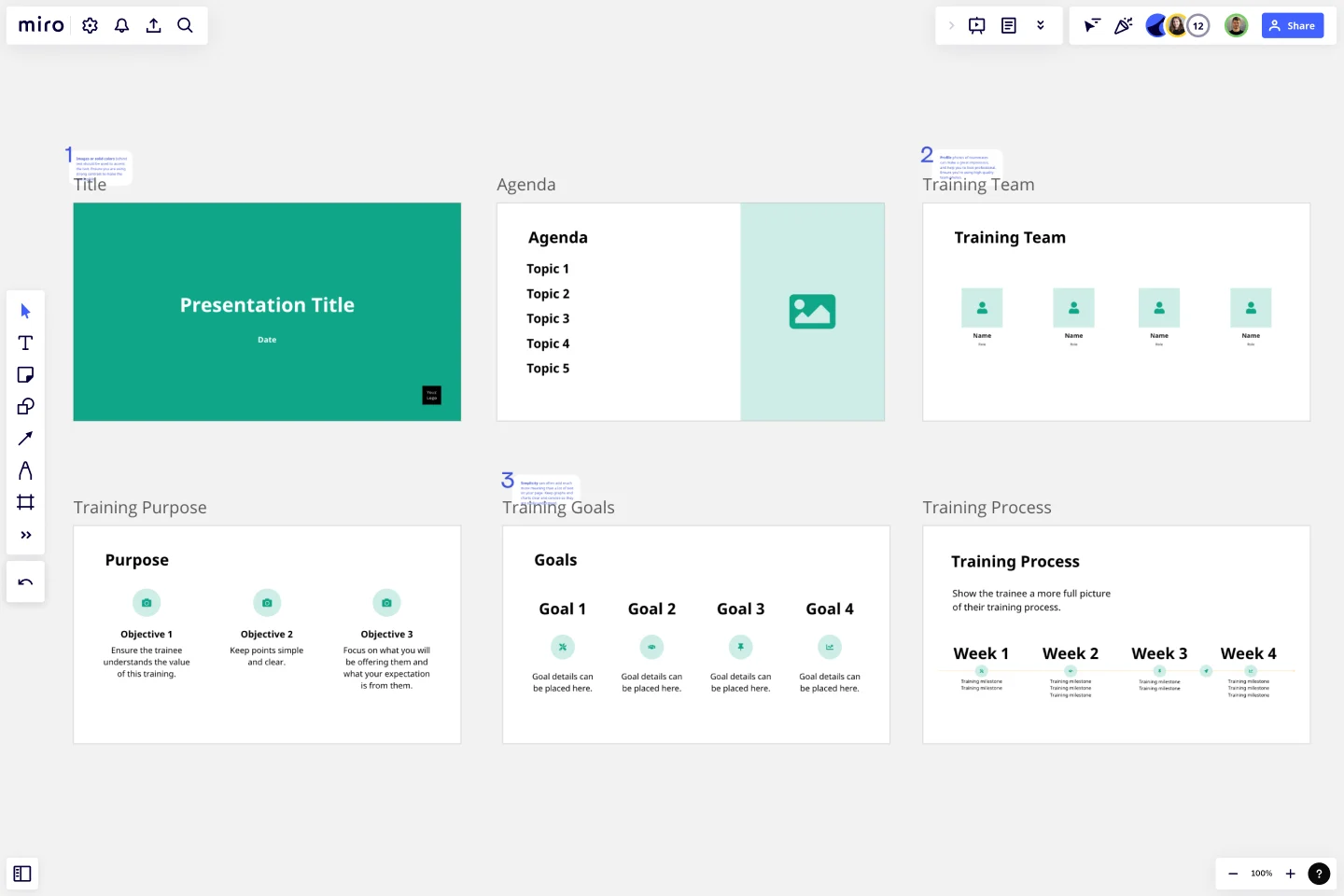
Training Presentation Template
Effectively develop your workforce with an engaging training presentation template that simplifies the training creation process.
About the Training Presentation Template
Upskilling your workforce can cultivate a more creative and innovative workplace. When you provide high-quality training, you equip your team for success.
How you present your training can make or break the experience for your employees. Even the most in-depth training content can go over your employees’ heads if they’re not fully engaged in the experience.
The Training Presentation Template helps you outline your training and provide a visually engaging presentation for your employees. Plus, it’s easy for you to collaborate with other trainers by hashing out ideas on the board and customizing the template from your brainstorming sessions.
Once the training is over, your team can use your Training Presentation Template as a single source of truth to refer back to. No more switching back and forth between a slide editor, paper documents, and handwritten mind maps in someone’s notebooks.
How to use the Training Presentation Template
The Training Presentation Template is already designed for you on your board — that’s why it’s so easy to create a training presentation with Miro. You can say goodbye to boring training slides.
You can easily edit and customize the training presentation to fit your needs and match your company’s branding. Whether you need to change up the colors, add a logo, link to some additional training resources, or complement your training with images, this template makes customization simple and painless.
And there’s no need to stay constricted within the template, either. You can add or remove frames to get as many or as few slides as you need to create stunning training content.
Customize your frames with your training content
In Miro, frames are your presentation “slides.” All frames are contained within a board on the platform. They hold all the content of your slide and keep it together so it’s ready to present your training, just like you would with a traditional slide editor.
Once you open your Training Presentation Template, you can:
Change the text
Adjust the font
Change the background color
Replace images with your own
Add more images
Drag and drop to switch the order of your frames. When you do, everything contained within the frame will also move. There’s no need to select all the elements within the frame first!
To add elements within the frame, simply pull in images, text boxes, and other elements you’d like to use. You can double-click the title of each frame to give them a different title if desired.
Duplicate frames to add more slides.You can even add new frames by drawing on the board for a custom ratio or by selecting from one of the existing frame ratios, like 16:9.
For more in-depth information on how to customize your training material, read about presentation mode in Miro .
Brainstorm training content with your team
Because your frames are in a Miro board, you can use the remainder of the board to collaborate with anyone else helping to build out the training. Brainstorm slide ideas by putting together mockup designs and sketches. Alternatively, add mind maps to the board to map out your training.
View your Frames list and export
You can view all the frames on your board with the Frames list. This list will give you a preview of what your training presentation will look like when you export your board.
Drag and drop your frames to change the order if desired. Once you’re happy with how everything looks, you can save your training presentation as a PDF.
Present your training in Miro
If you want to present directly from your board without leaving Miro instead of exporting a PDF, you can do that. Miro has a built-in presentation mode designed for that purpose.
When you activate presentation mode , you’ll start a slideshow from your existing training presentation frames. Use your arrow keys to move back and forth between frames.
Tips for structuring a training presentation
Greet the audience first when you structure your training presentation frames. Next, introduce yourself or the training team.
Once you complete the introduction section, jump into the training by tackling the challenge this training is designed to help them overcome. You should also state your expectations to your employees. For example, do you want them to interact during training? Will you only take questions at the end? Should they expect a quiz or an exam once the training is over?
Go into the main topic of your training and give a summary before each section with time for questions if possible. When you create your conclusion, summarize the main training points and key elements to retain.
You can wrap up the training presentation by giving a call to action to let them know what’s next for them. That could be homework, a specific goal, another upcoming training session, assessments, or more.
To encourage discussion, leave a slide at the end that signals you’re ready to take questions.
What should be included in a training presentation?
Make sure to include content that appeals to different learning styles. Not every employee learns in the same way.For example, you can include flow charts and maps for visual learners. Add some text to your slides for learners who prefer to read. For kinesthetic learners, include some real examples and practical exercises to be performed during the training session. Finally, auditory learners will benefit from hearing you speak during the presentation.
How do you give an effective training presentation?
When you give your training presentation, make sure you’re well-rested for the occasion. It’s important to appear open and approachable.If you’re giving a training presentation that’s longer than 30 minutes, schedule some short breaks to allow for better retention. You should also add interactive elements in between sections. For instance, include exercises with scenarios to gauge your employees’ understanding of the content. Thank your employees for their attention once you conclude the training session. Answer any questions you can. When possible, clear your schedule after the presentation so that employees can speak to you one-on-one about further questions and concerns.
Get started with this template right now.
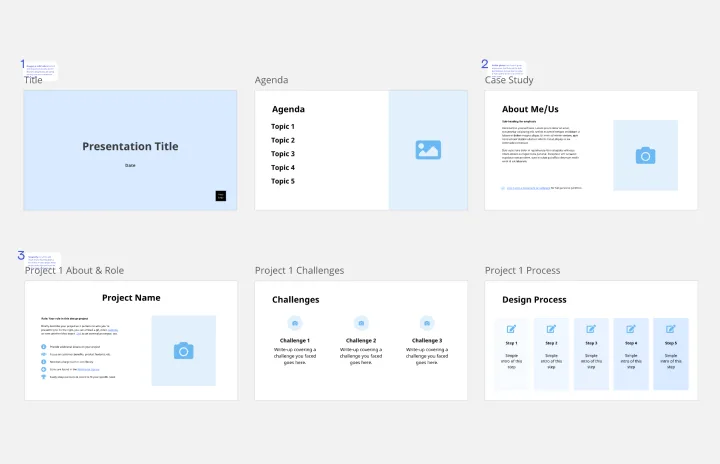
Portfolio Presentation Template
Works best for:.
Presentations, UX Design
Display your work in an engaging and visually-appealing format with Miro’s Portfolio Presentation Template. Exhibit your best work and help your audience visualize your designs.
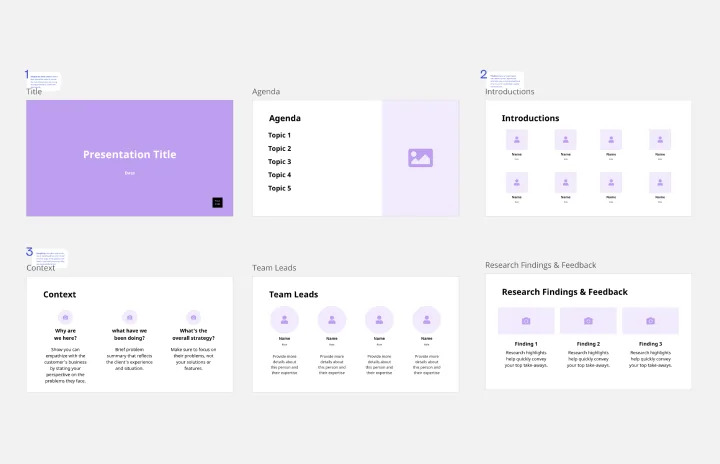
Demo Presentation Template
Presentations, Meetings
Present your ideas confidently and professionally with this Demo Presentation Template. Use it to show potential and existing customers how your product or service works so they can fully appreciate its value.
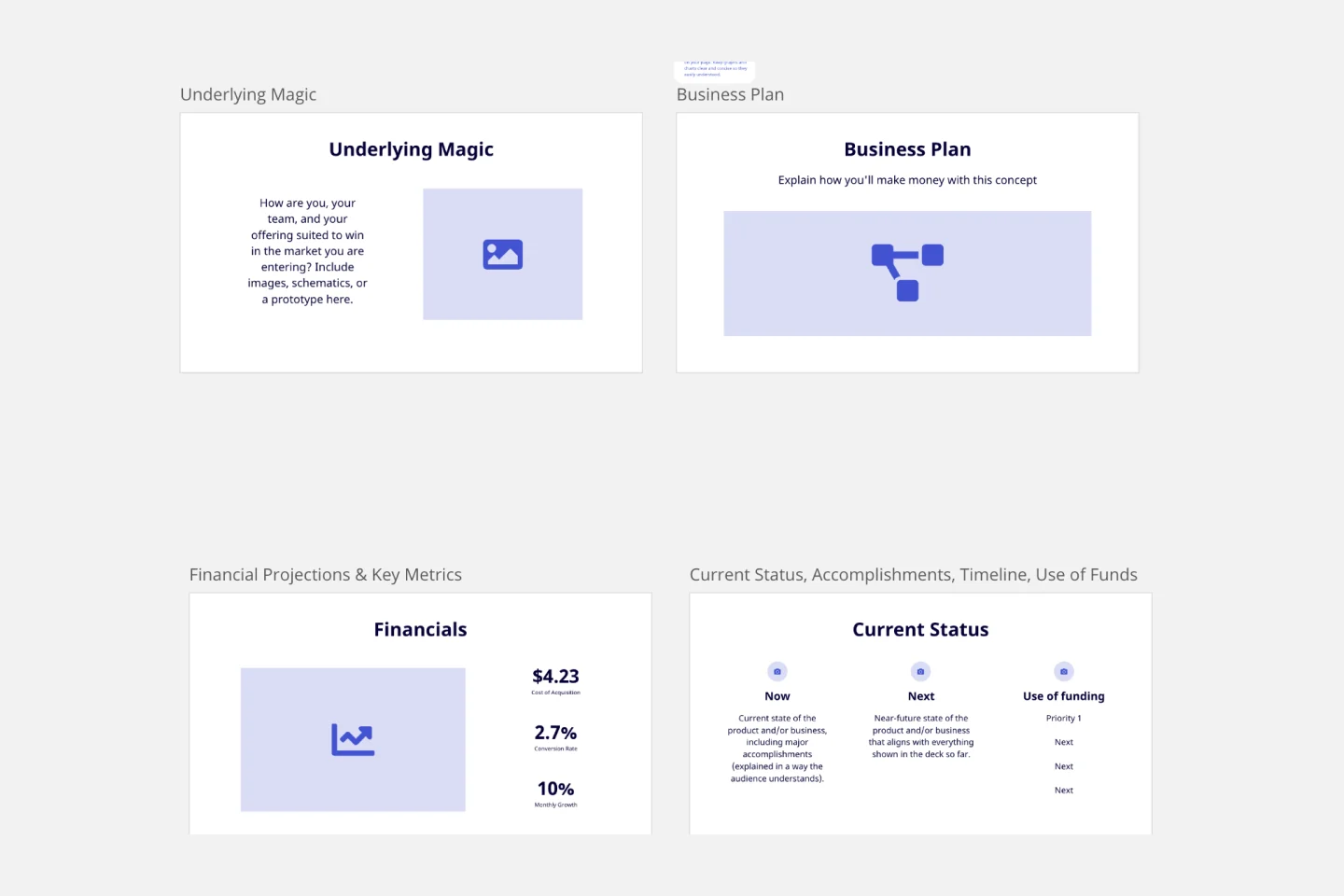
Pitch Deck Template
Stand out and leave a lasting impression with the Pitch Deck Template. Make people care about your idea and gain supporters everywhere.
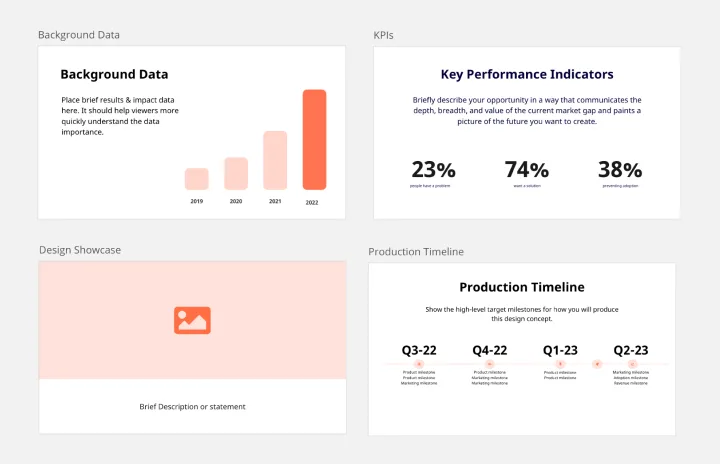
Critical Design Review Presentation Template
Use this template to finalize the design phase of a project. Keep all team members on the same page and ensure that your team’s technical efforts are on track.
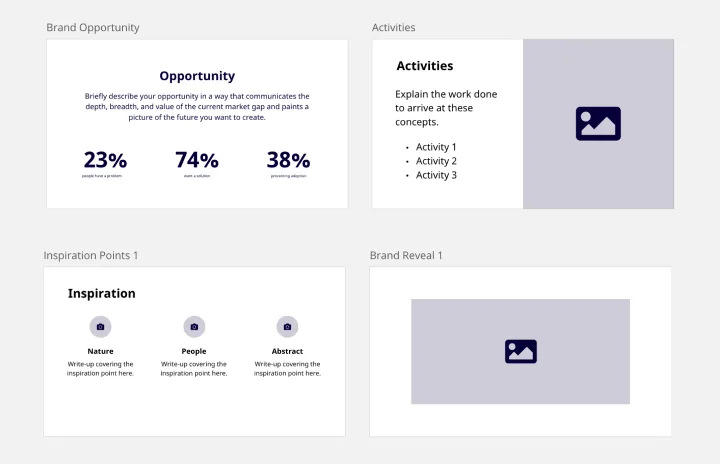
Rebranding Presentation
Out with the old, in with the new! Showcase your brand’s newly revised strategy with this dynamic Rebranding Presentation Template.
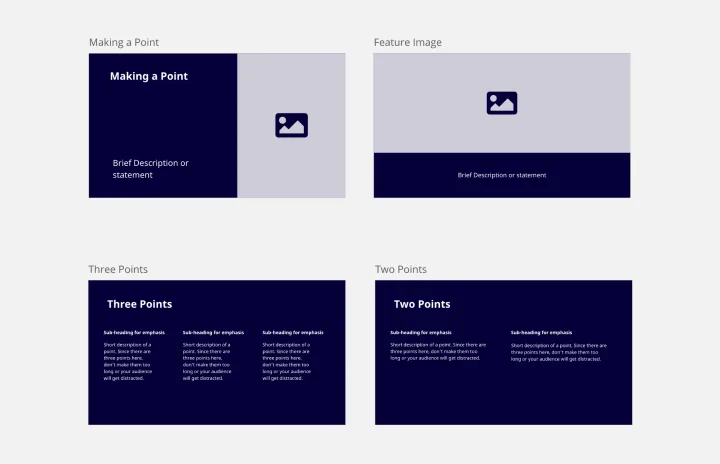
Simple Presentation Template
Presentations
Designed to remove the clutter and communicate the most important information in a clear and visually appealing way, our Simple Presentation Template will keep your audience’s eyes glued to the screen and their ears tuned into your voice — without having to add any fancy bells or whistles.

- DELIVERY METHODS
- OnDemand Online Training
- In-Person Training
- Live Remote Training
- Instructional Design
- Virtual Customer Service Training: Empower Your Remote Workforce
- Meet The Team
- Laughs and Learning Around the Bonfire
- Video Library
- Testimonials
- Case Studies
- Pricing & FAQ
- WBE & More!
The Do’s and Don’ts of Training Presentations

As a trainer, you have a lot riding on your shoulders. Training new or existing employees can help your company improve employee performance, engagement, customer satisfaction, and so much more. But, your organization can only reap the benefits of training when it’s presented properly.
Here are some basic do’s and don’ts of training presentations:
1. Be Prepared
There’s no need to have your entire presentation memorized, but it’s important to rehearse it a few times so you aren’t stumbling over your words. It will help you shake off nerves, and your confidence will show on the day(s) of your presentation.
In addition to practicing what you’re going to say, be sure to also take note of:
- Voice volume
- Posture and movement
- Speech cadence
2. Know Your Audience
Before you start, take a little time to gain an understanding of what your trainees actually do for the company. They want (and need) to hear about topics that will help them do their job, not someone else’s. If you’re teaching phone skills, it’s important to package your message differently for front-line representatives versus C-suite staff.
It’s also helpful to know what kind of learners will be in the audience. If you’ve worked closely with any of them in the past, you may rely on your emotional intelligence to guide you. Or, you can simply ask them. Having this information will help you outline your presentation. The three basic types of learners include:
- Visual: learn by seeing
- Auditory: learn by hearing
- Kinesthetic: learn by doing
3. Include Engaging Activities
Include activities that will engage your various learners, keep their attention, and make your training stick. Your auditory learners will get the most out of your presentation, but for your kinesthetic learners, role-playing various situations can be extremely helpful. Also, watching videos of other people doing the activities can be beneficial for visual learners.
You should know that a person can be more than just one type of learner. Try to include an activity or various activities that will speak to all types. For example, Bonfire utilizes gallery walks to keep people engaged in multiple ways. We place flip chart pages about the topic of study on the wall of the training room. Then, we break down trainees into groups and have them go around to the various prompts, each adding or responding to the previous group’s answer. Discussing the answers afterward helps stimulate conversation and questions.
Don’t:
1. Be Bored with Your Own Presentation
Be passionate about your subject of training. People respond to other people’s excitement. If you walk into the room and speak in a monotone while frequently checking the time, you might as well not even give the presentation.
Think about how your training will help drive the goals of your organization and make your audience’s lives more efficient. Channel that thinking into your tone of voice and your physical presence. Present with purpose. You should neither wander aimlessly around the room, nor pace back and forth like a tiger in a zoo.
2. Rely Too Much on Your Media
Do not, I repeat, do not read your presentation word for word, and certainly don’t turn around and face your slide deck to read it. It’s unhelpful, counter-productive, and almost insulting. If all you’re doing is reading, then the training could have been sent in an email that people could read for themselves.
While it’s important to have a solid slide deck, remember: you’re the show. The media you use to support your presentation is the fog machine to your rockstar performance.
3. Talk Over the Head of the Audience
Data is good, but too much can be overwhelming. If you’re just firing statistics at your audience, they may mentally check out. Some real-world examples are needed to validate your training, but they should support your presentation rather than encompass it.
You’ll be better off using stats and situations that your trainees experience in their everyday work lives. Concrete examples will make an impression and stick with your audience.
One extra tip: training shouldn’t end after you conclude your presentation. Follow-up activities and correspondence enforce learning transfer, giving trainees an opportunity to apply their new skills and knowledge.
Are you ready to master the training techniques and philosophies that will keep your class and staff engaged? Our Presentation Skills course can help you incorporate the skills you need. Contact us today!
Additional Resources:
- Emotional Intelligence shows up every day. The question is how well is it managed to ensure everyone is performing at a high level .
- Improve your trainers presentation development and delivery skills to ensure excellence when presenting to clients .
- Develop employee engagement, emerging leaders, and improved customer experience. Contact us today !
- Shop Bonfire
- Meet the Team
Ready to spark some change?
Please fill out the form below to get started on your training journey.
- (855) 776-7763
Collaborate
WebinarNinja
ProProfs.com
Knowledge Base
Survey Maker
All Products
- Get Started Free
FREE. All Features. FOREVER!
Try our Forever FREE account with all premium features!
How to Create an Engaging Online Training Session – 8 Simple Steps

ProProfs Training Maker Editorial Team is a diverse group of professionals passionate about online training and e-learning. We update you on the latest trends, dive into technical topics, and offer insights to elevate your business.

I once found myself in a training session that was more like a slow-motion episode of “Watching Paint Dry.” Not exactly inspiring, right? Well, that’s when I realized how crucial an engaging training session can be.
So, what exactly is a training session? Why should you care? And more importantly, how can you create one that keeps everyone from checking their phones every five minutes?
In this guide, I’ll share the secrets to creating a training session that doesn’t just inform but excites you. You’ll discover the core benefits, the essential components, and the steps to design one that leaves a lasting impression.
Ready to transform your training sessions from “meh” to “wow”? Let’s dive in!
What Is a Training Session?
A training session is basically a planned event where you teach new skills or transfer knowledge to a group of employees. It’s like a workshop but specifically focused on helping them improve their work performance.
Why Are Training Sessions Important?
Training sessions are an investment in your greatest asset: employees.
Imagine this: You’ve got a team of talented individuals, but you know they could be unstoppable with a little extra polish . Training sessions are your way to bridge that gap. You can take their skills and knowledge to the next level, whether it’s mastering a new software program or perfecting a sales strategy. By providing targeted instruction, you equip your employees with the tools they need to excel. And guess what? When your employees are well-trained, they become ninjas in their roles . They can tackle tasks with lightning speed and make fewer mistakes. This translates directly to a productivity boost for your entire team. But it’s not just about speed. You can significantly reduce errors by equipping your teams with the right knowledge and procedures. We all know mistakes happen, but training helps prevent them in the first place. This saves you time and money and ensures your work meets the highest standards.
Similarly, training isn’t just about ticking boxes. It’s about sparking creativity and igniting problem-solving skills . By exposing your employees to new ideas and approaches, you can inspire them to think outside the box and devise innovative solutions.
Here’s the key: engaged employees are happy employees. And happy employees tend to stick around. Training demonstrates that you value their development and want them to succeed. This creates a positive work environment and reduces employee turnover, saving you time and money on recruitment.
How to Create an Effective Online Training Session
Creating an effective online training session involves meticulous planning and a deep understanding of your audience’s needs. I will share with you a detailed step-by-step guide.
Step 1: Define Your Goals and Objectives
What to do: Clearly define the goals of your session. Determine what participants should learn and accomplish by the end.
How to do it: Use actionable, specific objectives like “apply conflict resolution strategies in customer interactions.”
Why it’s crucial: Precise objectives guide your content creation and ensure the training meets its intended outcomes.
Step 2: Know Your Audience
What to do: Understand the demographics, prior knowledge, and expectations of your audience.
How to do it: Use surveys or informal pre-session interviews to gather insights.
Why it’s crucial: Tailoring the session to your audience ensures relevance and engagement, preventing mismatches in content complexity.
Step 3: Choose the Right Training Tool
What to do : Select the most appropriate training tool(s) to deliver your content effectively.
How to do it : Consider factors like the size of your audience, learning objectives, and budget. Options include instructor-led training, eLearning modules, simulations, or a blended approach.
Why it’s crucial : The right tool can significantly enhance learning and engagement.
Step 4: Design the Content
What to do: Plan the structure of your session, incorporating various teaching methods.
How to do it: Organize the training into distinct sections, including lectures, interactive activities, and group discussions.
Why it’s crucial: A diverse and well-structured session keeps participants engaged and facilitates better learning.
Step 5: Prepare Materials
What to do: Develop all necessary training materials and ensure technological tools function properly.
How to do it: Prepare handouts, slides, and multimedia resources ahead of time. Test everything before the session.
Why it’s crucial: Effective materials and smooth-running technology support the training delivery and minimize disruptions.
Step 6: Facilitate the Session
What to do: Actively engage with participants, delivering content clearly and interactively.
How to do it: Use engaging speaking techniques and encourage participation through questions and activities.
Why it’s crucial: Skillful facilitation enhances understanding and keeps energy levels high, making the learning experience more effective.
Step 7: Use Real-Life Examples
What to do: Integrate examples from real-world scenarios to illustrate key points.
How to do it: Share relevant experiences or case studies that apply directly to the skills being taught.
Why it’s crucial: Real-life examples help participants visualize how they can apply what they learn in their own roles.
Step 8: Evaluate and Follow Up
What to do: Assess the effectiveness of the session and gather participant feedback.
How to do it: Use assessments and feedback forms like surveys at the end of the session; follow up with additional support if necessary.
Why it’s crucial: Evaluation helps refine future training efforts and ensures that participants can effectively apply their new skills.
What Makes a Good Training Session?
When I used to train my teams, I always ensured my training programs had certain vital elements. Here is my take on what makes a training session superior:
- Clear Objectives : Starting with clear and specific objectives helps learners understand what they will achieve by the end of the session.
- Engaging Content : It is essential to ensure the content is exciting and relevant. Real-life examples and case studies make the topics relatable. Include activities like group discussions, role-plays, and hands-on exercises. Here’s a quick video on: How to Add Media to Your Online Courses
- Practical Application : Focus on practical applications of the concepts taught as it helps learners see the value in what they are learning and how it applies to their work.
- Feedback and Assessment : Provide regular feedback and conduct assessments to gauge understanding. Adjust training methods to address any gaps in knowledge.
- Supportive Environment : Create a supportive and inclusive environment. The key is to encourage questions and foster a space where learners feel comfortable expressing their thoughts and concerns.
- Continuous Improvement : Seeking feedback from learners and continuously improving training sessions based on their input helps stay relevant and effective.
Remember: a training session having all these elements is informative, engaging, and practical at the same time.
What Are the 4 Components of a Training Session?
During my training days, I learned from both successes and challenges. I remember once, we overlooked the evaluation component in a rushed training session, resulting in a lack of understanding of how much the participants had actually absorbed.
This led to ineffective follow-ups and limited practical application by the attendees. This experience taught me a crucial lesson on the necessity of a well-structured session.
That’s why I always emphasize to my fellow trainers the importance of incorporating these four essential components in their training sessions:
1. Introduction
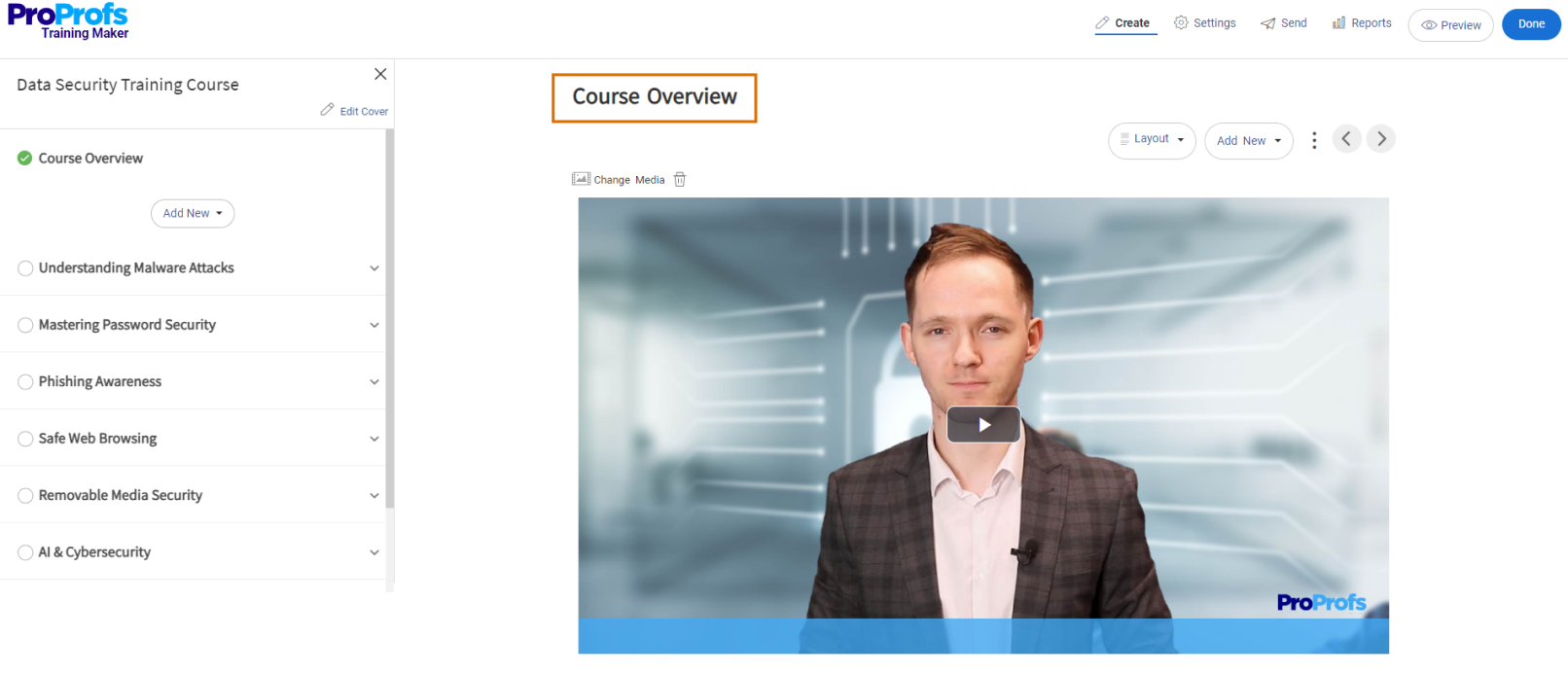
Here’s how an overview and course objectives are written:
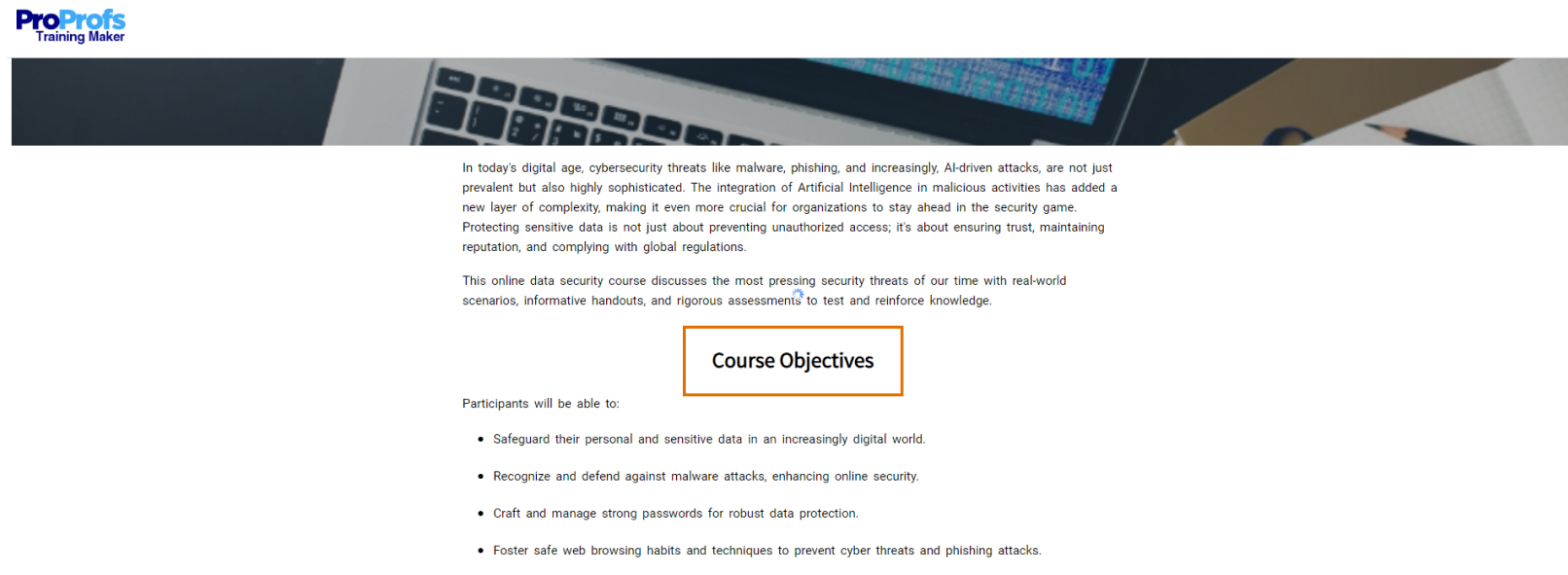
2. Instruction
This is where the main content delivery happens. Based on my experience, this stage needs to balance information delivery with participant engagement effectively. Whether it’s through a presentation, demonstration, or direct teaching, the goal is to make the content accessible and understandable. Using multimedia, handouts, assessments, or real-life examples can greatly enhance the learning experience.
3. Application
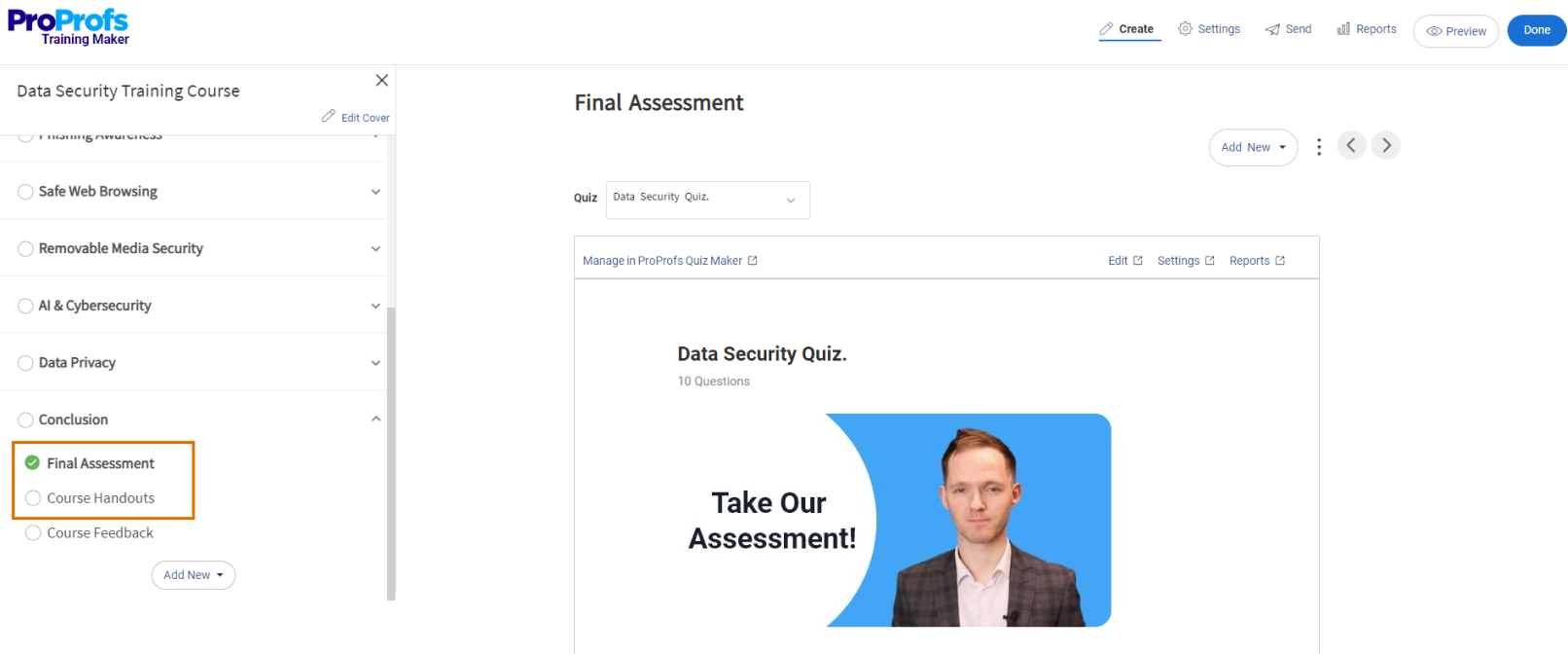
After grasping the new information, participants need an opportunity to put their knowledge into practice. This could be through workshops, simulations, or group discussions. From my own training sessions, I found that participants often gain deeper insights during this phase as they explore the practical aspects of the knowledge in a controlled, supportive environment.
4. Evaluation
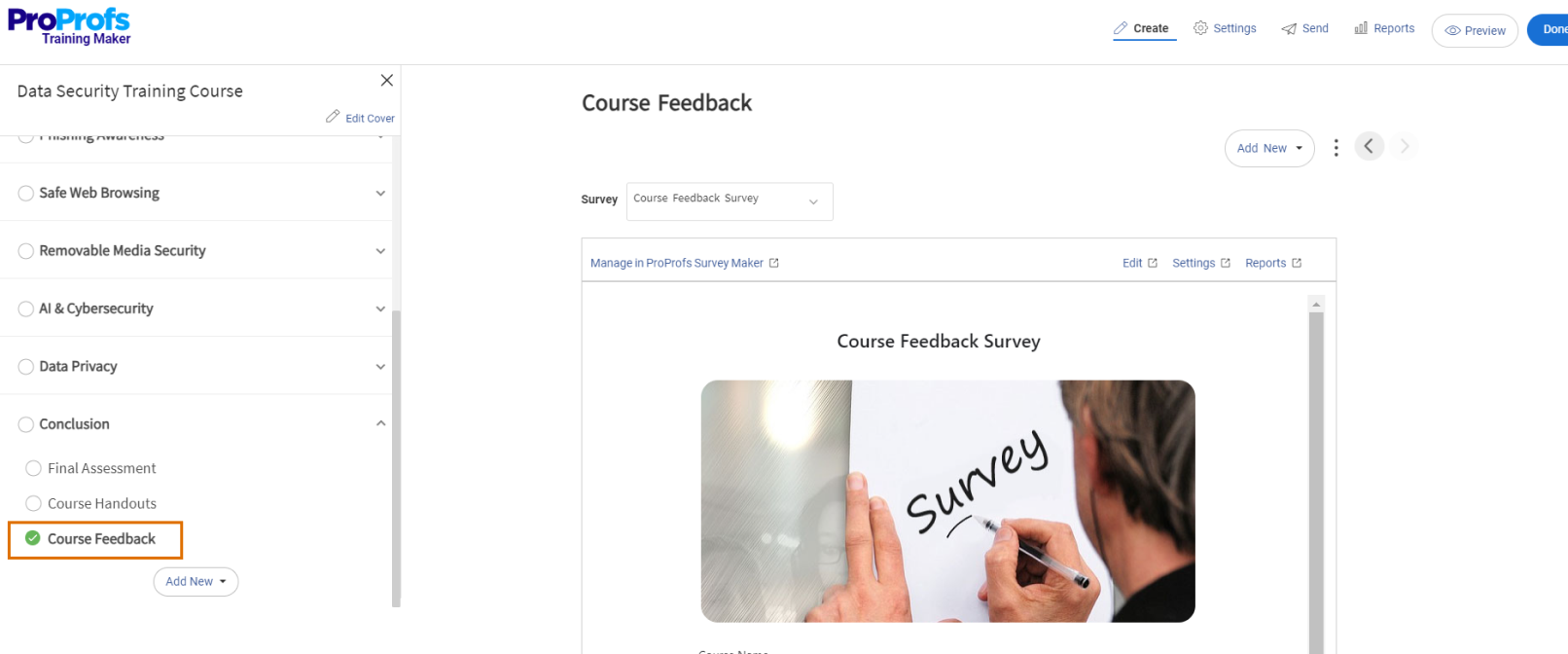
Reflecting on that one session in which we missed out on evaluation, I now diligently incorporate this phase. It involves assessing the participants’ understanding through quizzes, feedback forms, or practical tasks. This phase helps confirm that the training objectives were met and gather insights on how to improve future sessions.
8 Effective Online Training Session Examples
Now, I will share a few examples of highly effective training sessions in various organizational settings. These examples include the type of training session, the objective it aims to achieve, a brief description of the session, and the target audience for each training.
1. Leadership Development Workshop
This workshop focuses on developing effective leadership qualities, including decision-making, team management, and conflict resolution, through interactive sessions and role-playing activities.
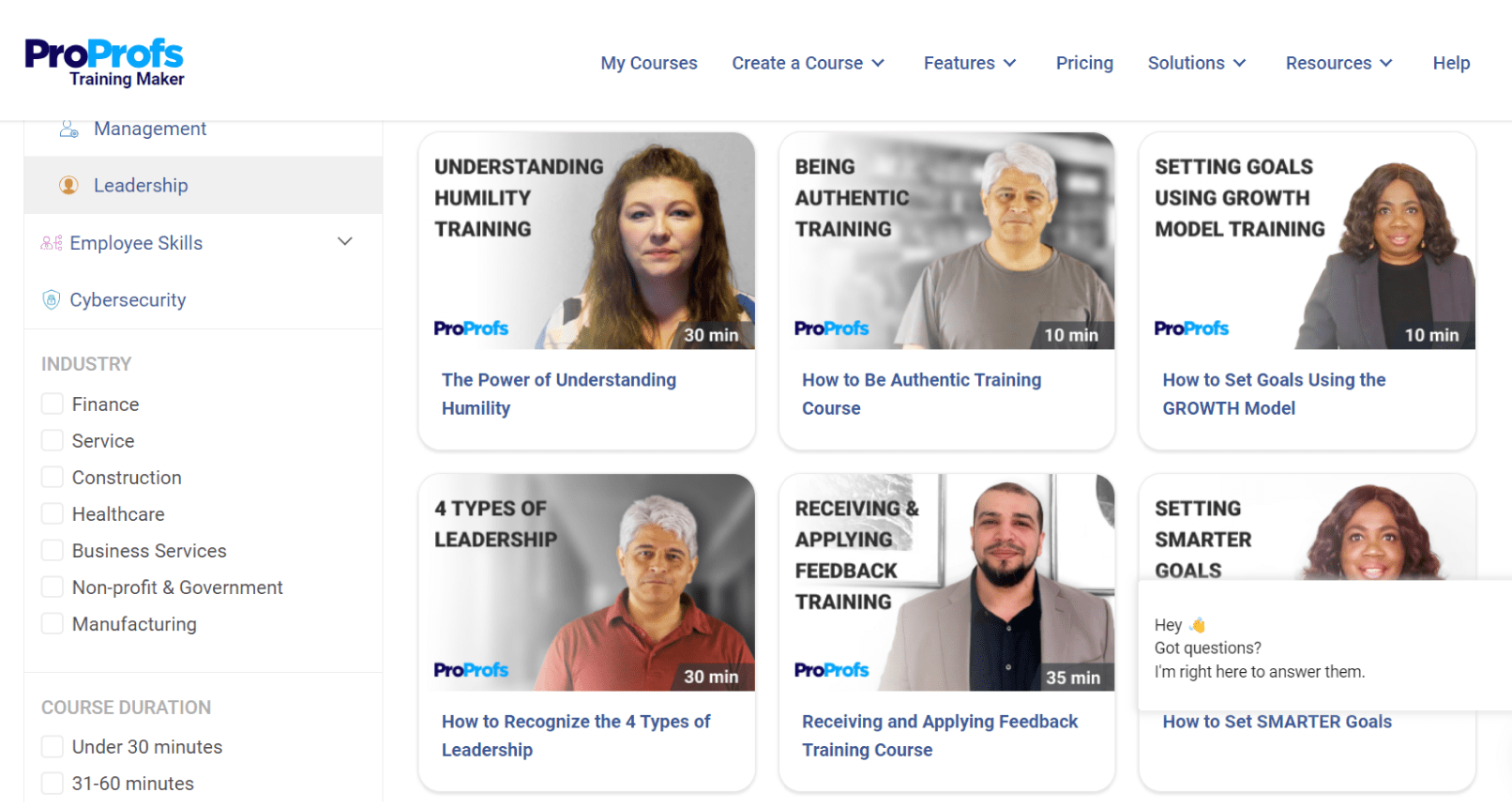
- Objective: To enhance core leadership skills and strategic thinking ability.
- Whom to Train: Current and aspiring leaders and managers.
2. Customer Service Excellence Training
Through simulations and case studies, participants will learn best practices in customer service, including communication techniques, handling difficult customers, and building lasting customer relationships.
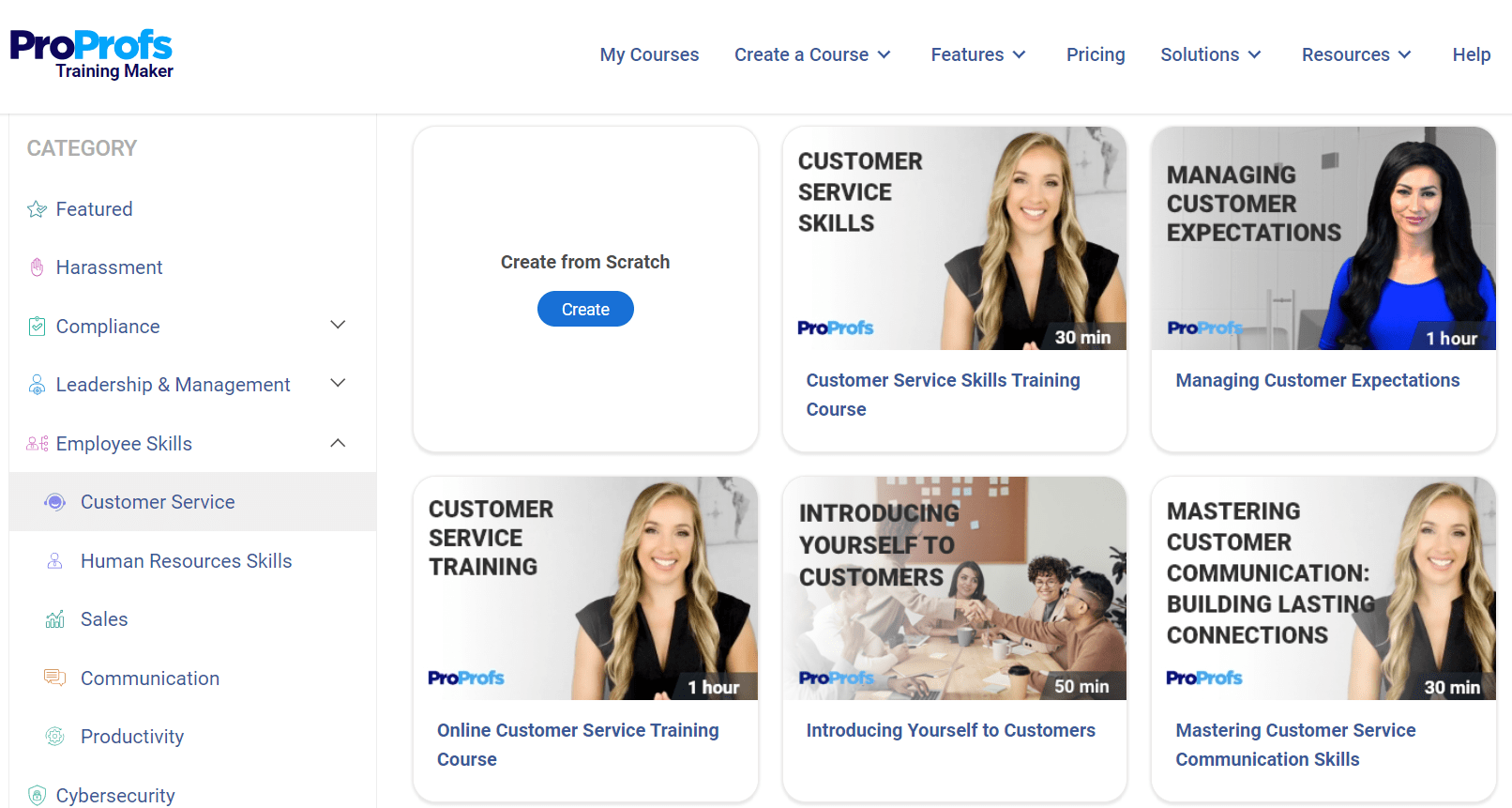
- Objective: To improve customer service skills and ensure customer satisfaction and loyalty.
- Whom to Train: Customer service representatives and front-line staff.
3. Effective Communication Skills
Participants will engage in exercises and discussions designed to improve verbal and non-verbal communication, active listening, and public speaking abilities.
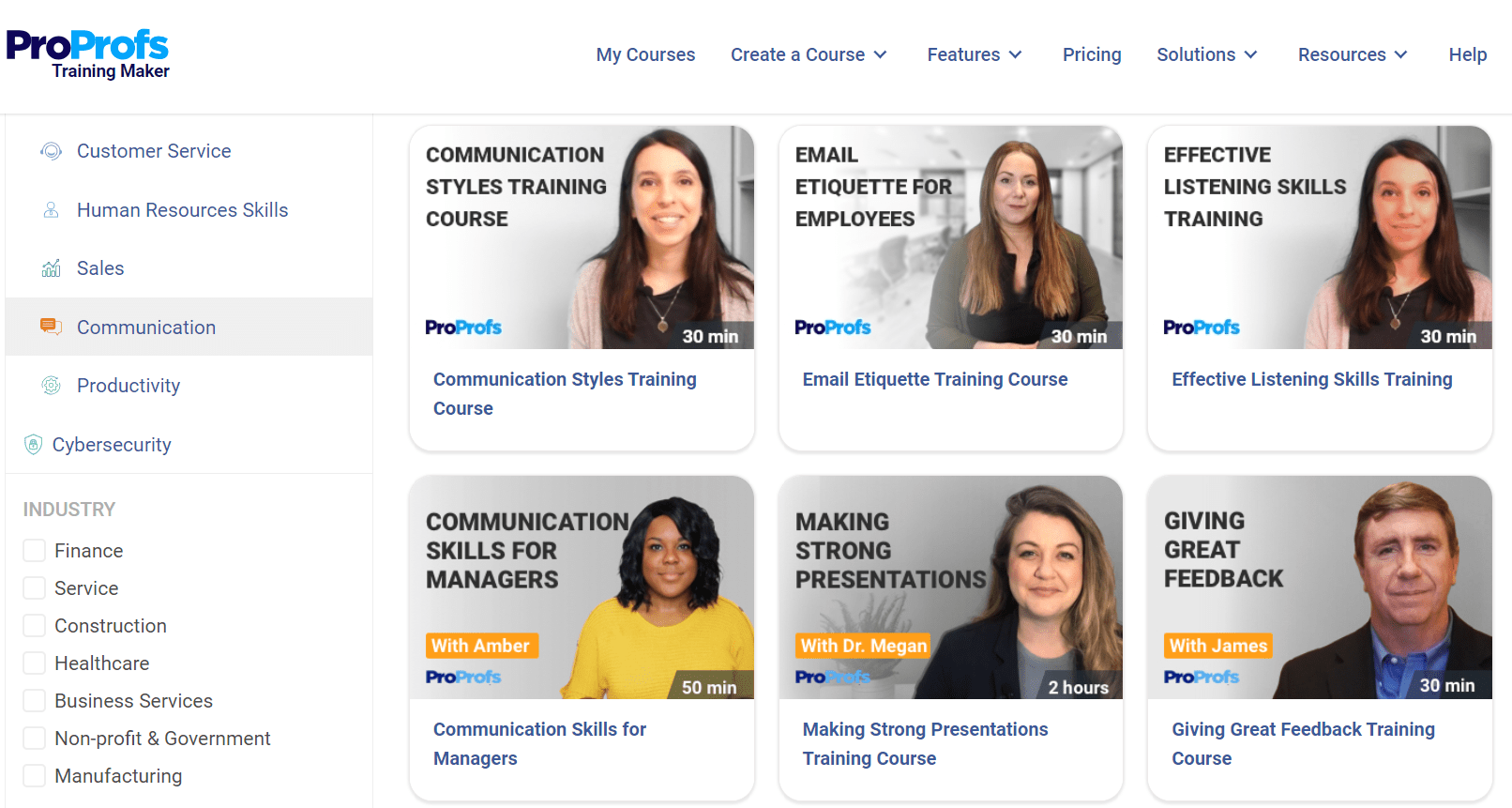
- Objective: To enhance interpersonal communication and presentation skills.
- Whom to Train: Employees at all levels who need to improve communication skills.
4. Time Management and Productivity
This training session provides strategies for prioritizing tasks, managing deadlines, and avoiding procrastination, with practical tips and tools to enhance personal and professional productivity.
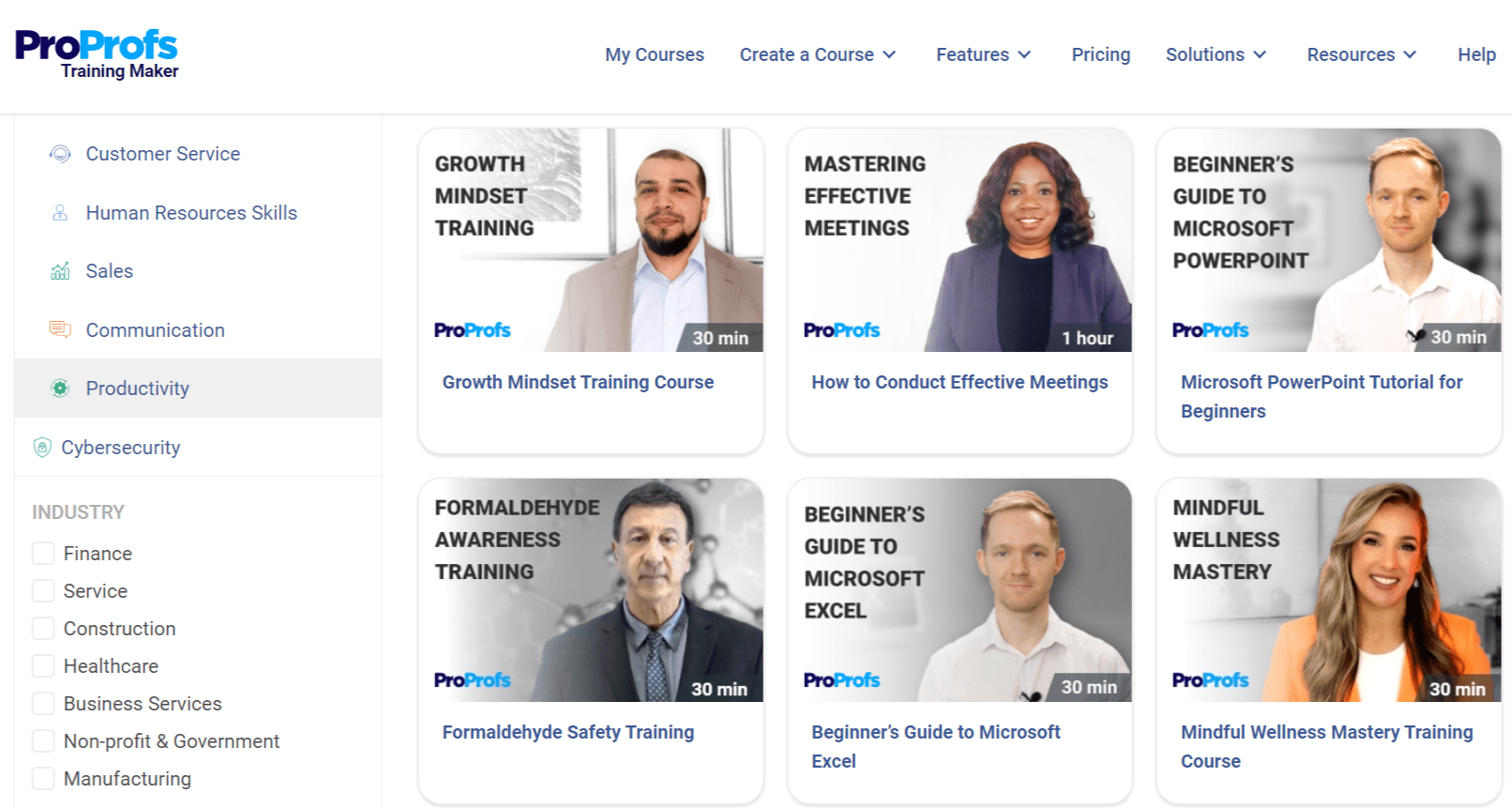
- Objective: To boost productivity through effective time management techniques.
- Whom to Train: All employees seeking to improve time management.
5. Diversity and Inclusion Training
The training aims to raise awareness about diversity issues, promote inclusivity, and provide strategies for creating a respectful and supportive work environment through interactive activities and discussions.
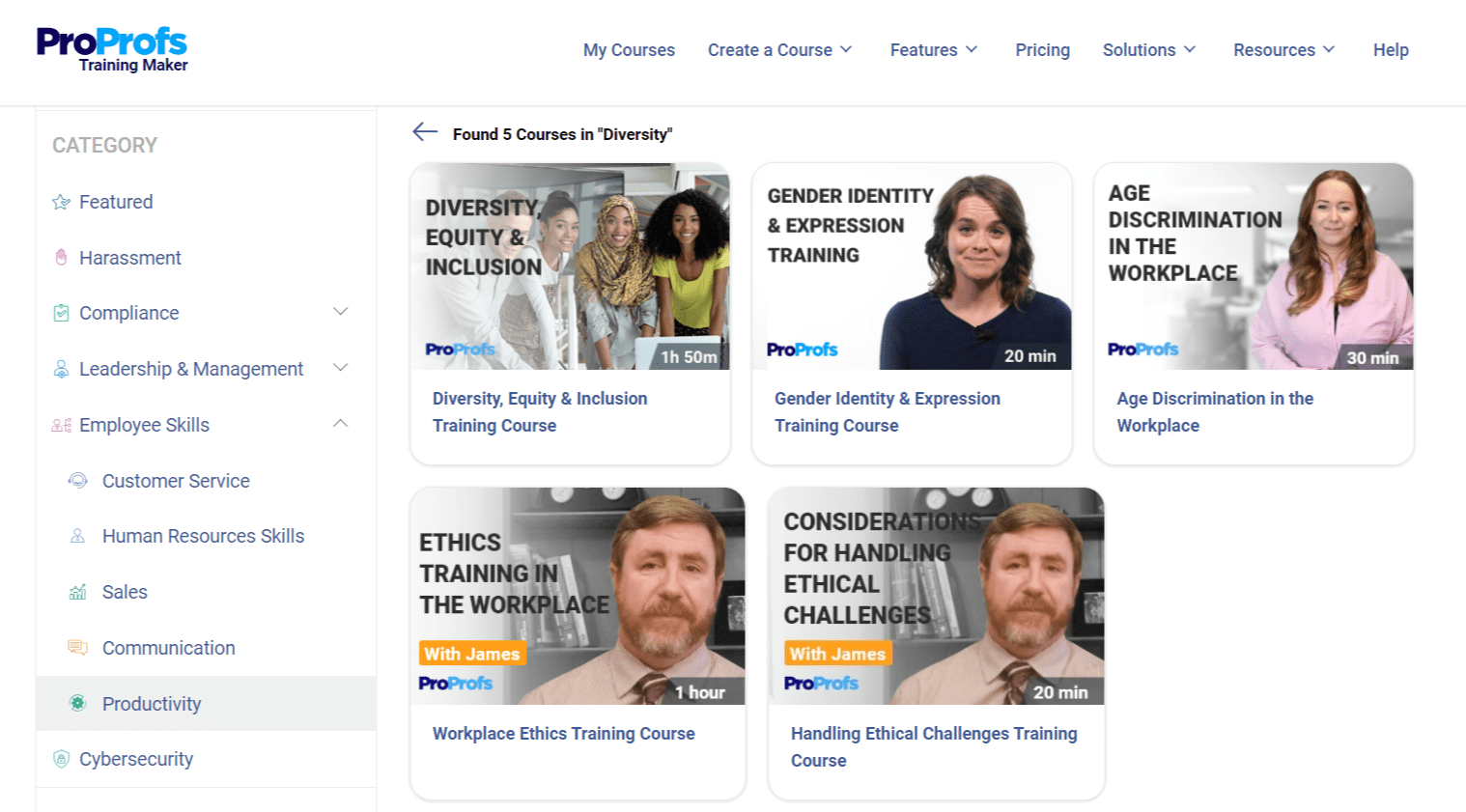
- Objective: To foster an inclusive and respectful workplace culture.
- Whom to Train: All employees, with a focus on leadership and HR personnel.
6. Health and Safety Awareness
This session covers workplace safety protocols, emergency procedures, and health guidelines, emphasizing the importance of maintaining a safe and healthy work environment through practical demonstrations and safety drills.
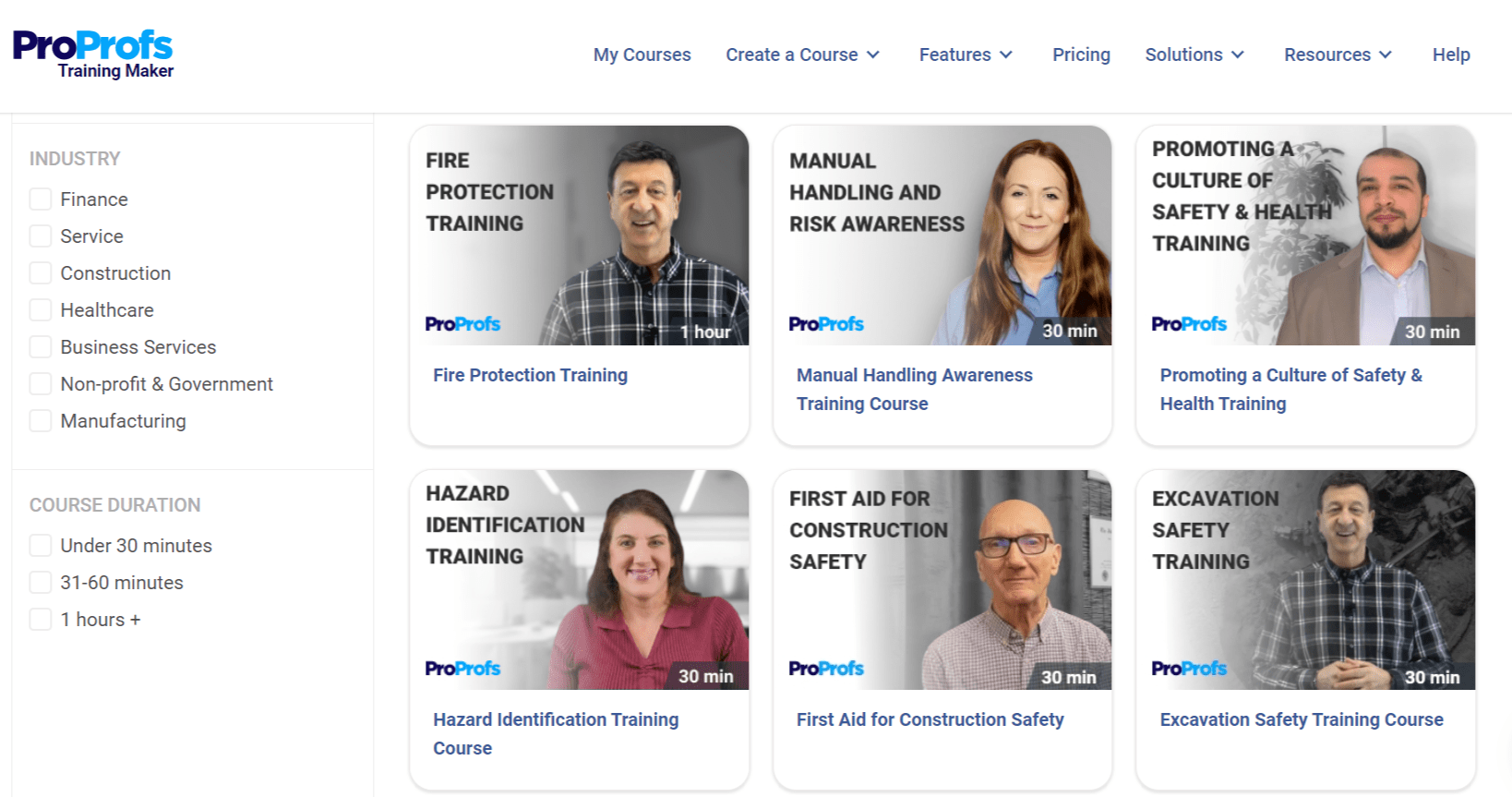
- Objective: To ensure the safety and well-being of employees.
- Whom to Train: All employees, especially those in high-risk roles.
7. Conflict Resolution and Negotiation Skills
Participants will learn techniques for resolving conflicts and negotiating effectively, with a focus on achieving win-win outcomes through role-playing and scenario-based exercises.
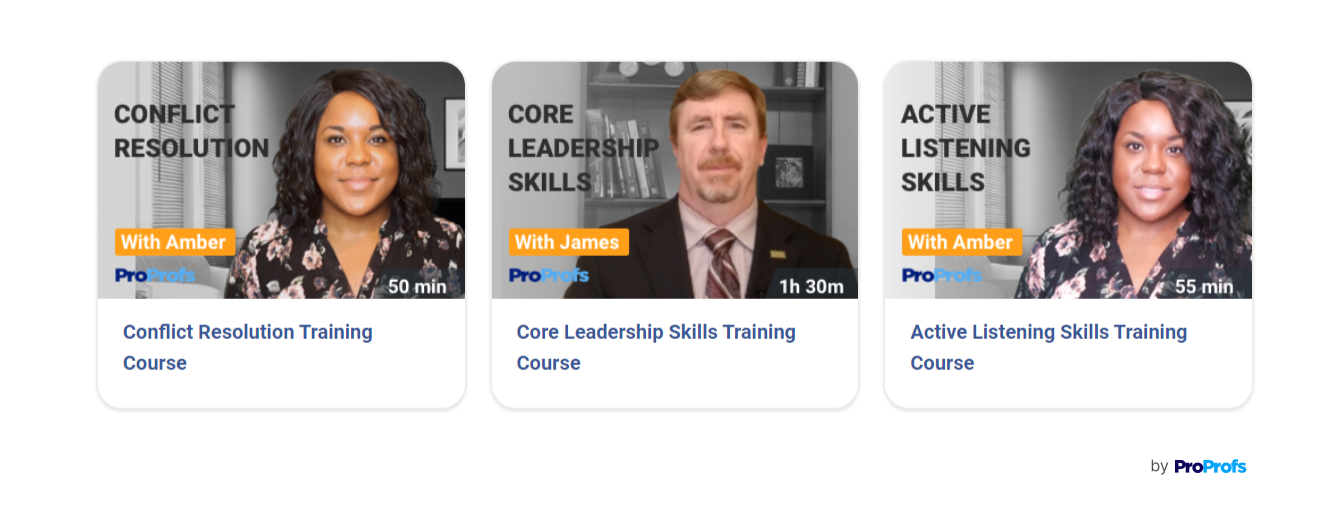
- Objective: To improve conflict resolution and negotiation skills.
- Whom to Train: Managers, team leaders, and HR professionals.
8. Compliance Training
This training ensures that participants are well-versed in industry regulations, legal requirements, and company policies, thereby minimizing risks and ensuring adherence to standards.
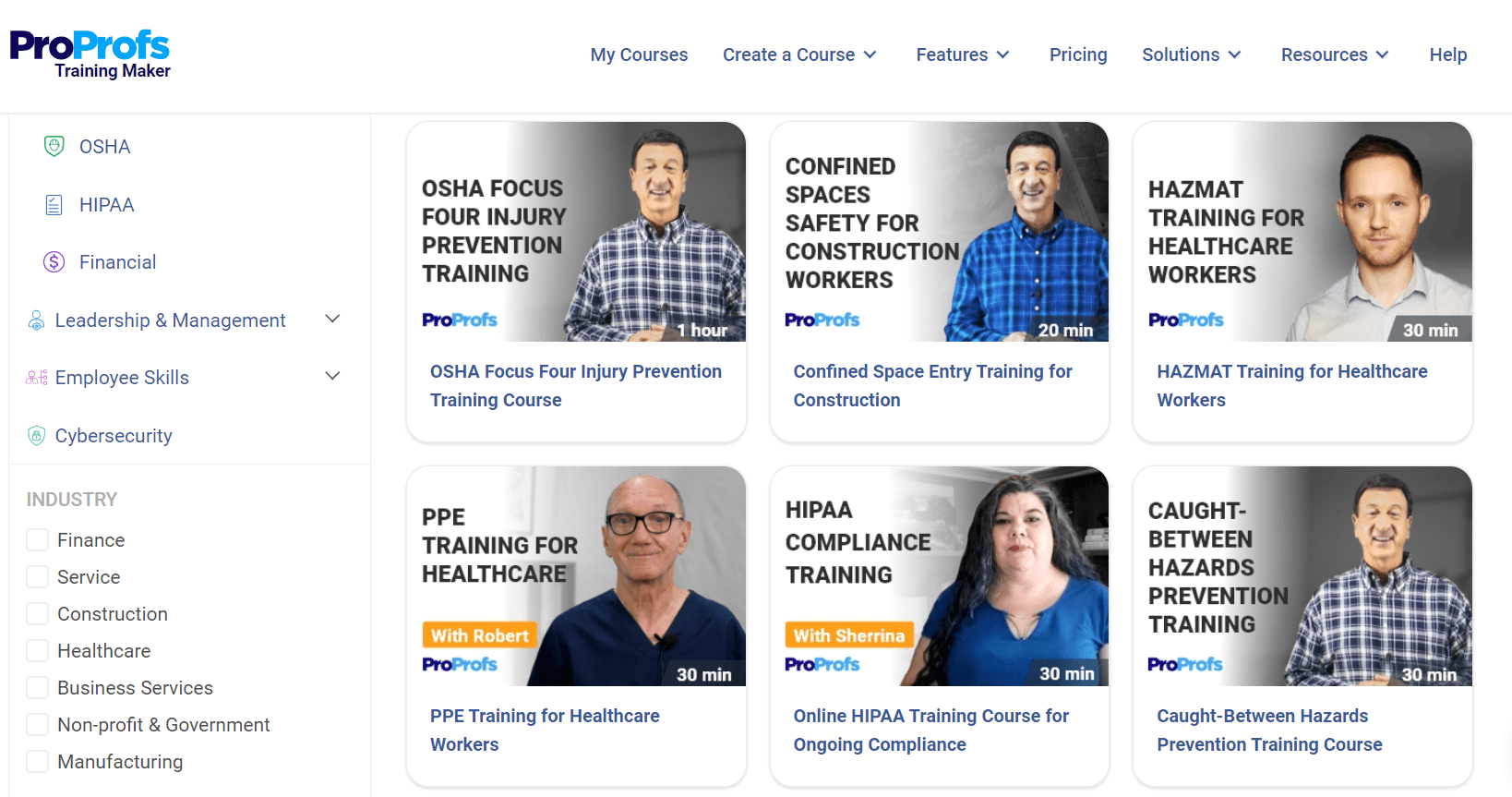
- Objective: To ensure all employees understand and adhere to applicable laws, regulations, and internal policies.
- Whom to Train: All employees, with a focus on those in roles with regulatory, legal, and compliance responsibilities.
Bring Out the Potential of Your Workforce With Effective Training Sessions!
Training sessions are not just about filling employees’ heads with information; they’re about igniting their potential. By implementing the strategies outlined in this guide, you can transform your training sessions from forgettable lectures into engaging experiences that empower your team to excel.
Remember, effective training is an investment that yields significant returns. It boosts productivity, fosters innovation, minimizes errors, and keeps your employees engaged, happy, and productive.
So, take the first step today and create training sessions that leave a lasting impression – not just on your employees’ minds, but on your company’s bottom line.

About the author
ProProfs Editorial Team
ProProfs Training Maker Editorial Team is a passionate group of eLearning experts dedicated to empowering your learning experiences with top-notch training content. We stay ahead of the curve on trends, tackle technical hurdles, and provide practical tips to boost your business. With our commitment to quality and integrity, you can be confident you're getting the most reliable resources to enhance your training initiatives.

10 Best Remote Training Software to Use

What Makes a Training Program Rewarding for Your Employees

10 Best Employee Training Methods & Their Biggest Benefits

10 Best Virtual Employee Engagement Ideas for a Better Team Connection

The Ultimate New Hire Onboarding Checklist You Need for Employees

7 Best Sensitivity Training Courses & Programs for Employees

COMMENTS
Top Tips for Creating an Effective Training Presentation. What we commonly call "effective presentation" is the right balance of two elements: the content you provide and how you deliver it. The first part is on your expertise and every piece of information you can share. But the second part is where the real magic happens.
On Chromecast, choose to use the split screen. One side shows the video of you teaching, and the other is the training presentation you prepared. Send the recording to the employees that didn't attend in person or live online. Infographic of the steps required to create a SCRUM training presentation. 3.
Template 5: Training proposal template. This PowerPoint Template is a deck of 29 slides. It depicts an in-depth proposal regarding corporate training and professional growth. Objectives and actions such as team building workshops, ensuring the stability of the business, time management, etc., are included.
Here are a few tips for business professionals who want to move from being good speakers to great ones: be concise (the fewer words, the better); never use bullet points (photos and images paired ...
Step 6. Create the slides and include multimedia elements. Once you've selected the design for your presentation, populate it with the content you have from the previous steps. Make sure to balance the different elements of a presentation to engage trainees effectively.
One of the most important tips for creating effective training presentations is that design matters. As much as it may seem that the information is more important than the design for a training course, the design is actually very critical. Not only can your design reinforce your brand image and brand identity, but it can further engage your ...
How to Deliver Effective Training Presentations. 1. Practice and Rehearse. Preparation and practice are key to delivering a perfect and polished presentation. Familiarize yourself with the content and practice your delivery multiple times. Pay attention to your tone, pitch, and expressions during the rehearsal.
Apply the 10-20-30 rule. Apply the 10-20-30 presentation rule and keep it short, sweet and impactful! Stick to ten slides, deliver your presentation within 20 minutes and use a 30-point font to ensure clarity and focus. Less is more, and your audience will thank you for it! 9. Implement the 5-5-5 rule. Simplicity is key.
By assessing learner understanding, collecting and analyzing feedback, and embracing a culture of continuous improvement, you can enhance the quality of your presentations and deliver exceptional learning experiences. Crack the code on successful training presentations! Engage your audience with proven strategies.
Ugly text. Ugly graphics. Too much text. Inconsistent layout. No white space. The sort of presentation that says "we didn't really try" but still gets used for onboarding all new staff, or at training sessions with senior management. It's embarrassing. People notice design - consciously or sub-consciously.
Before writing the content of your presentation, be sure to gauge what your listeners already know. 2. Set Measurable Goals. Before unleashing an overwhelming amount of data or instruction - clearly communicate your general agenda and outline of the contents of your training. 3.
Sit down with this team and go over what's expected from your instruction. Aim to make your goals as specific and concrete as possible, too. If you're running a public speaking course, then one of your goals could be having each person in the course give a two-minute presentation at the end.
So, go beyond the traditional onboarding and get ready to upskill your team all year long. Here I've compiled 15 presentation topics you can employ for employee training and development: 1.-. Time Management and Productivity. 2.-.
Examine each point and distill it down into 2-5 keywords. Go to insert > icon and find a relevant icon that matches the point being made. Insert the icon above or next to each set of keywords, and then align them. This is another quick and simple improvement that can immediately lift the effectiveness of your presentations.
A good training presentation can provide structure to your speech and boost your confidence as a presenter. It can also deliver your message efficiently, and stick with your audience long after your presentation is over. Use our training presentation template to: Present information simply and logically. Help you stay focused on your speech.
MWNL is a training PowerPoint presentation with a modern design. This template comes with 30 unique slides. The MWNL training PowerPoint presentation comes with graphics that can be resized and edited. Tips on Creating an eLearning Presentation. Creating a training presentation can be a big task. But there are a few ways to make it easier.
This article will take you through the steps to create a compelling PowerPoint-based training module and suggest ways to convert it into an eLearning format for enhanced accessibility and engagement, using the following steps: Understanding your audience. Structuring your content. Designing for impact. Engaging your audience.
Even better, replace the bullet points with a vivid diagram along with keeping the icons. #7: Presenting Summary of the Training. At the end of the training, remember to repeat the main message once again. Present the main conclusion, and give your audience something to think about.
Tip #3: Keep your slides short and sweet. Tip #4: Focus on your presentation design. Tip #5: Visualize boring numbers and data. Tip #6: Practice in front of a live audience. Tip #7: Meet your audience before presenting. Tip #8: Channel nervous energy into enthusiastic energy.
Shift the spotlight from yourself to what you have to say. Reject the voice in your head trying to destroy your confidence. Knowing what matters - and what doesn't - will help you succeed. I ...
When you give your training presentation, make sure you're well-rested for the occasion. It's important to appear open and approachable.If you're giving a training presentation that's longer than 30 minutes, schedule some short breaks to allow for better retention. You should also add interactive elements in between sections.
Voice volume. Posture and movement. Speech cadence. 2. Know Your Audience. Before you start, take a little time to gain an understanding of what your trainees actually do for the company. They want (and need) to hear about topics that will help them do their job, not someone else's.
A training session is basically a planned event where you teach new skills or transfer knowledge to a group of employees. It's like a workshop but specifically focused on helping them improve their work performance. ... This could involve presentations, videos, courses, discussions, activities, or even practice exercises—anything that helps ...